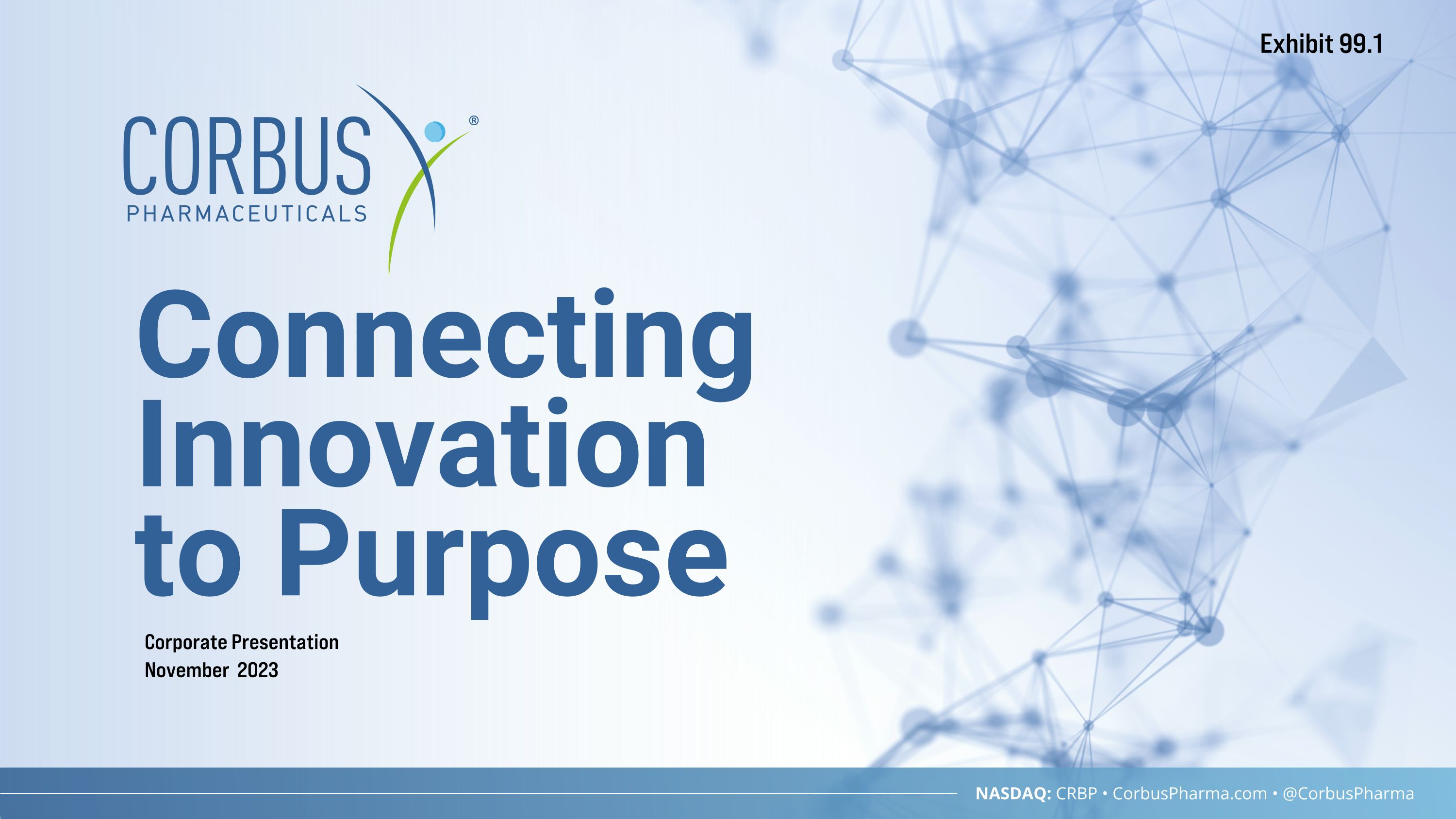

Connecting Innovation to Purpose Corporate Presentation November 2023 NASDAQ: CRBP • CorbusPharma.com • @CorbusPharma Exhibit 99.1
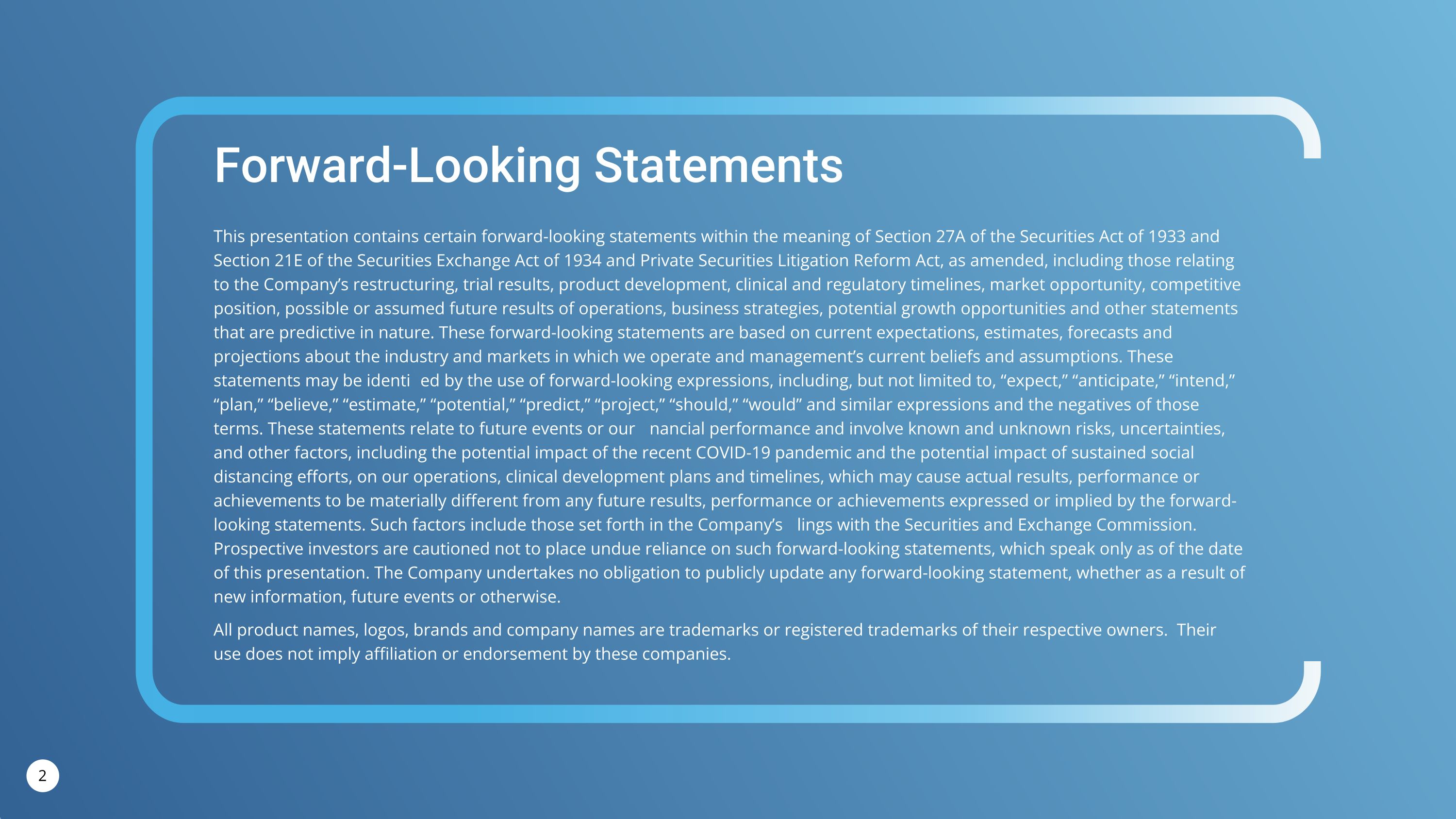
Forward-Looking Statements This presentation contains certain forward-looking statements within the meaning of Section 27A of the Securities Act of 1933 and Section 21E of the Securities Exchange Act of 1934 and Private Securities Litigation Reform Act, as amended, including those relating to the Company’s restructuring, trial results, product development, clinical and regulatory timelines, market opportunity, competitive position, possible or assumed future results of operations, business strategies, potential growth opportunities and other statements that are predictive in nature. These forward-looking statements are based on current expectations, estimates, forecasts and projections about the industry and markets in which we operate and management’s current beliefs and assumptions. These statements may be identified by the use of forward-looking expressions, including, but not limited to, “expect,” “anticipate,” “intend,” “plan,” “believe,” “estimate,” “potential,” “predict,” “project,” “should,” “would” and similar expressions and the negatives of those terms. These statements relate to future events or our financial performance and involve known and unknown risks, uncertainties, and other factors, including the potential impact of the recent COVID-19 pandemic and the potential impact of sustained social distancing efforts, on our operations, clinical development plans and timelines, which may cause actual results, performance or achievements to be materially different from any future results, performance or achievements expressed or implied by the forward-looking statements. Such factors include those set forth in the Company’s filings with the Securities and Exchange Commission. Prospective investors are cautioned not to place undue reliance on such forward-looking statements, which speak only as of the date of this presentation. The Company undertakes no obligation to publicly update any forward-looking statement, whether as a result of new information, future events or otherwise. All product names, logos, brands and company names are trademarks or registered trademarks of their respective owners. Their use does not imply affiliation or endorsement by these companies.
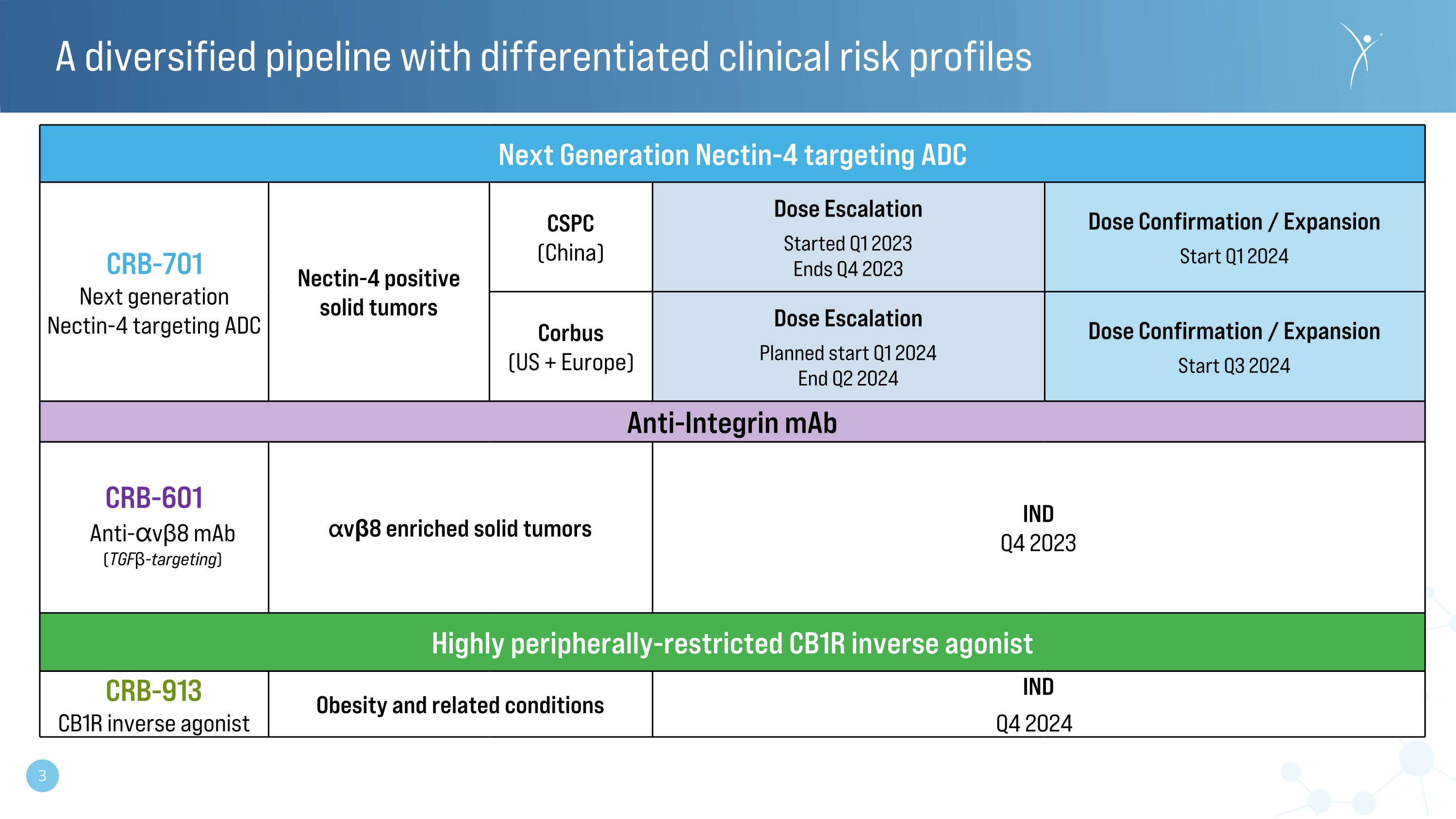
Next Generation Nectin-4 targeting ADC CRB-701 Next generation Nectin-4 targeting ADC Nectin-4 positive solid tumors CSPC (China) Dose Escalation Started Q1 2023 Ends Q4 2023 Dose Confirmation / Expansion Start Q1 2024 Corbus (US + Europe) Dose Escalation Planned start Q1 2024 End Q2 2024 Dose Confirmation / Expansion Start Q3 2024 Anti-Integrin mAb CRB-601 Anti-⍺vβ8 mAb (TGFβ-targeting) ⍺vβ8 enriched solid tumors IND Q4 2023 Highly peripherally-restricted CB1R inverse agonist CRB-913 CB1R inverse agonist Obesity and related conditions IND Q4 2024) A diversified pipeline with differentiated clinical risk profiles
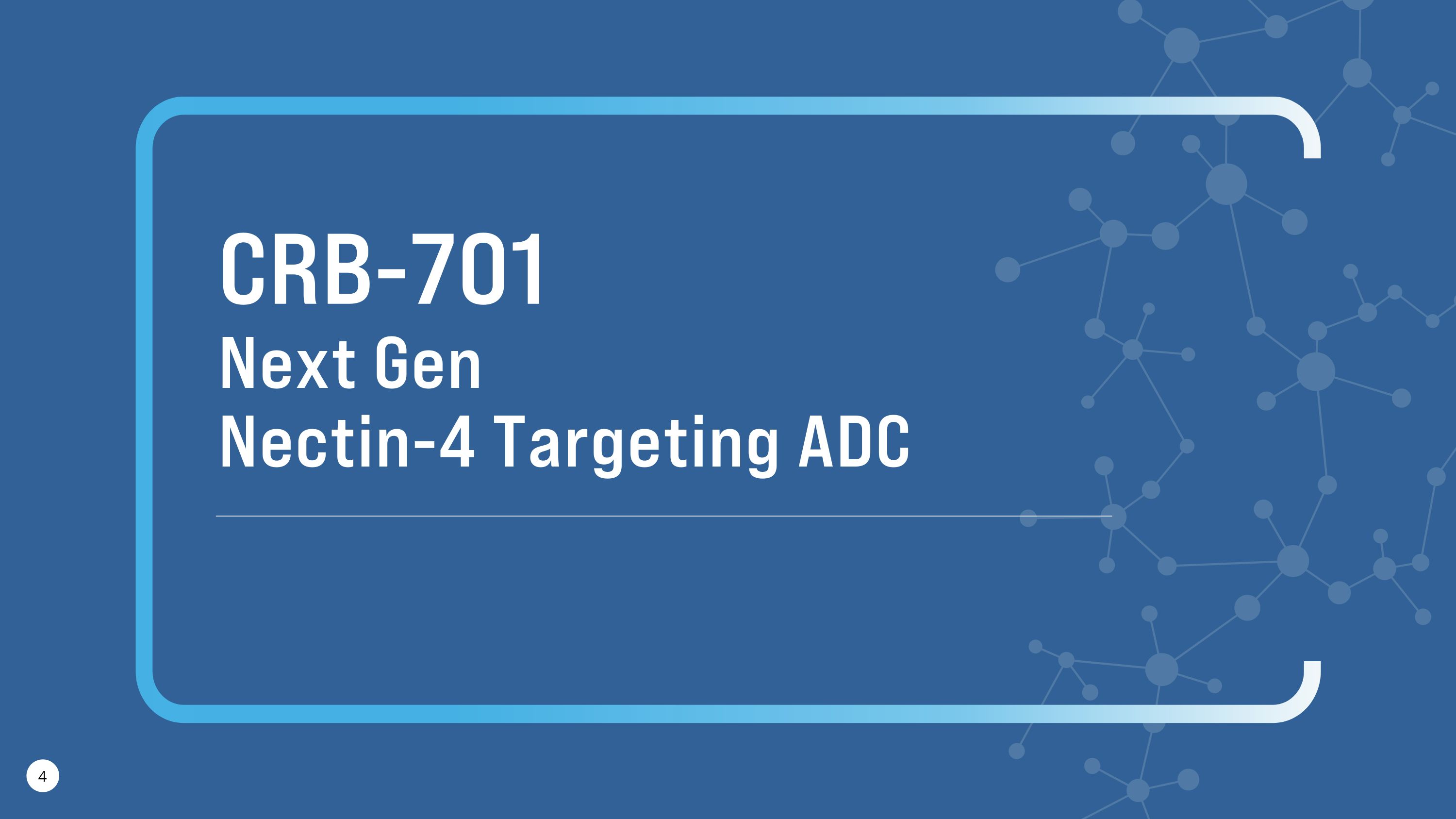
CRB-701 Next Gen Nectin-4 Targeting ADC
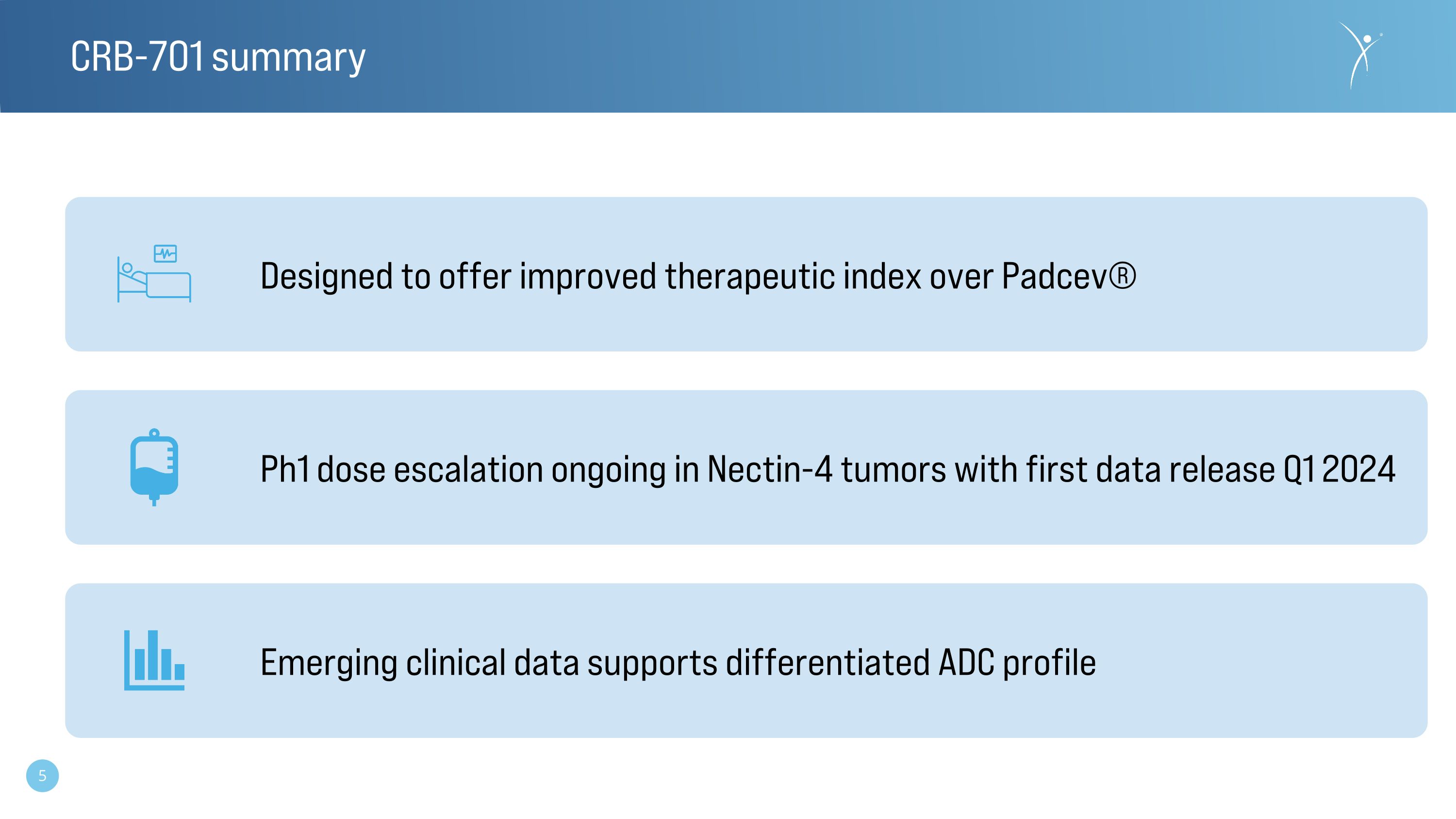
CRB-701 summary Designed to offer improved therapeutic index over Padcev® Ph1 dose escalation ongoing in Nectin-4 tumors with first data release Q1 2024 Emerging clinical data supports differentiated ADC profile
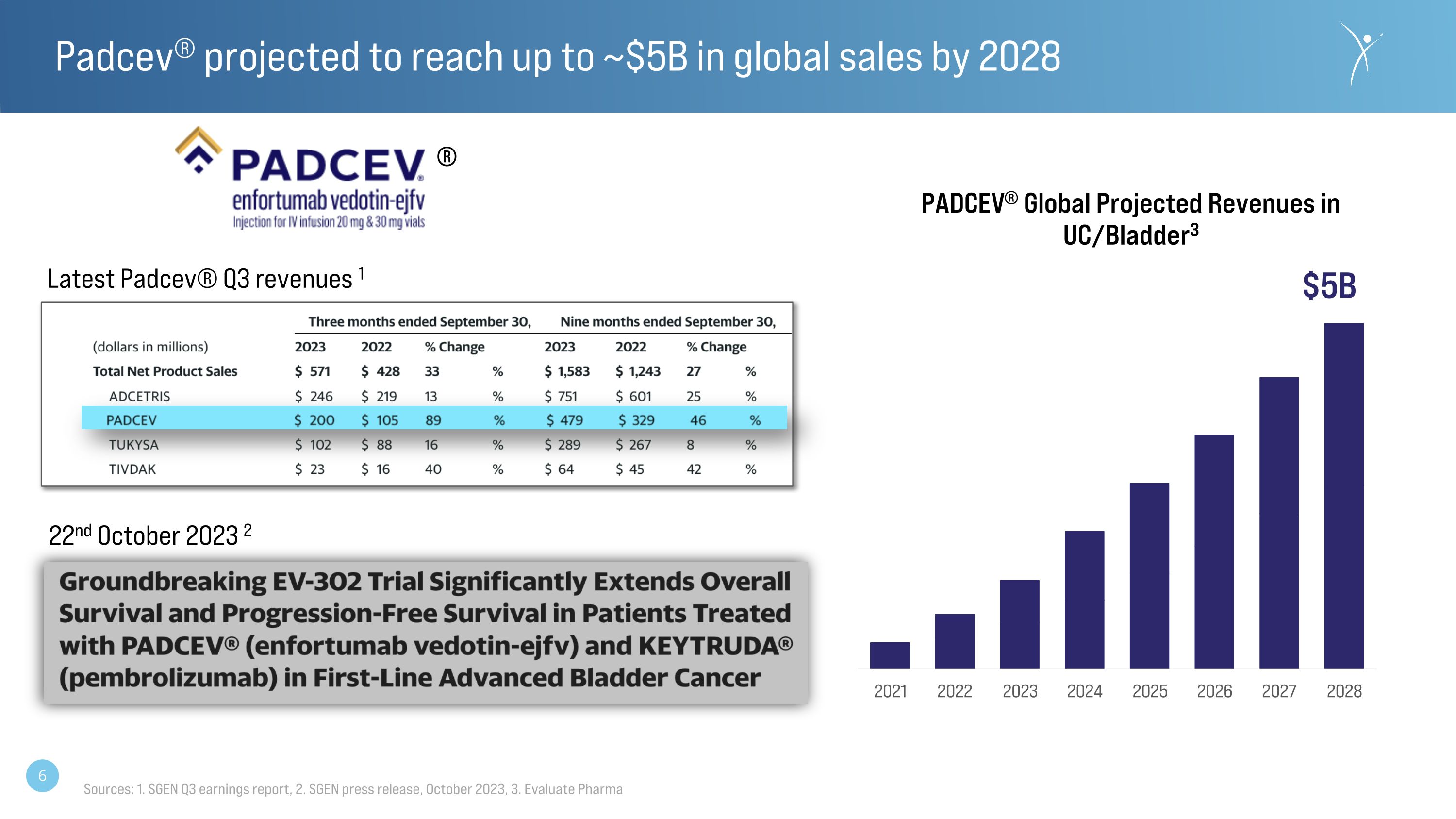
Padcev® projected to reach up to ~$5B in global sales by 2028 $5B ® Latest Padcev® Q3 revenues 1 22nd October 2023 2 Sources: 1. SGEN Q3 earnings report, 2. SGEN press release, October 2023, 3. Evaluate Pharma
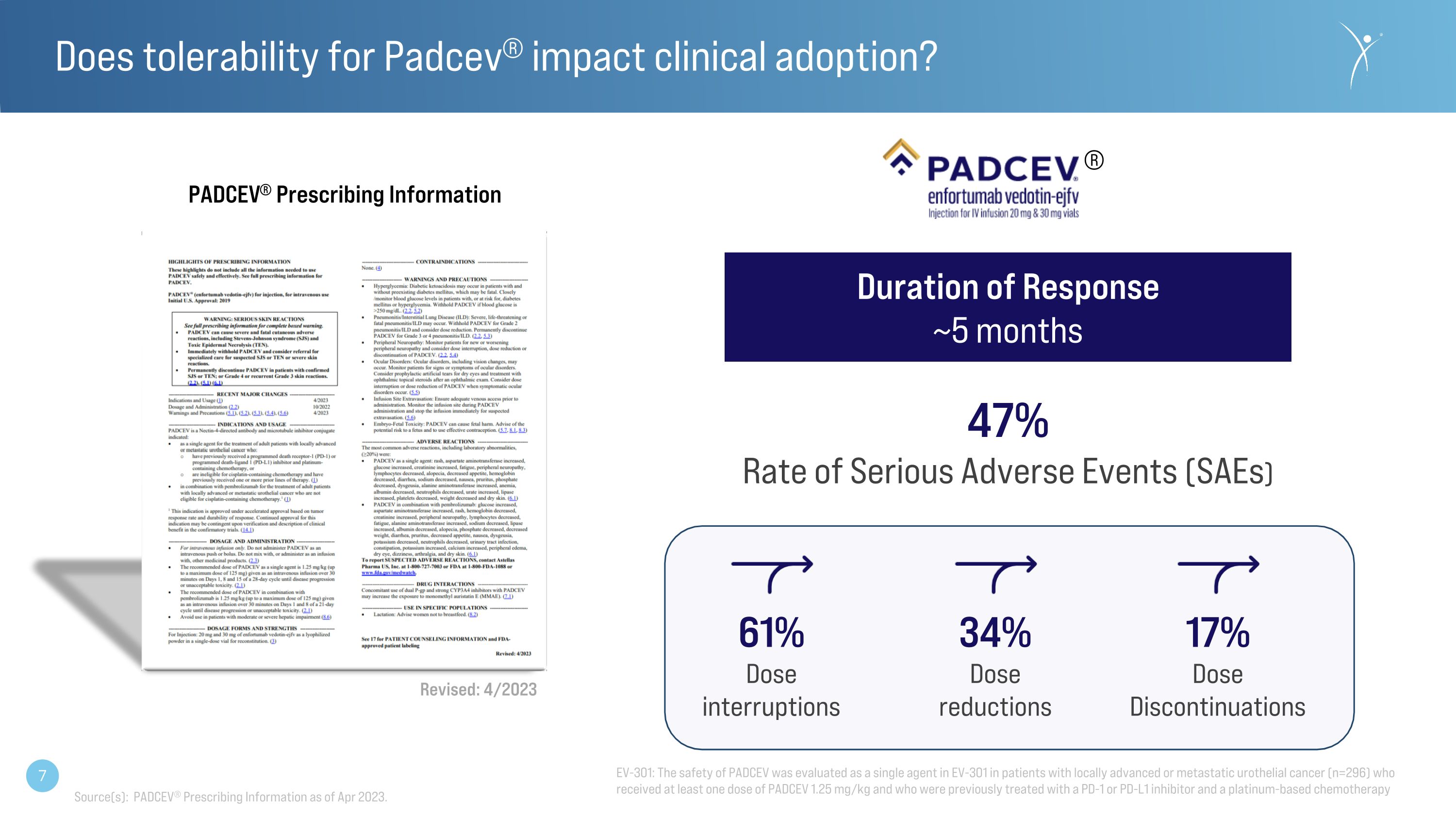
Does tolerability for Padcev® impact clinical adoption? ® Duration of Response ~5 months 47% Rate of Serious Adverse Events (SAEs) 61% Dose interruptions 34% Dose reductions 17% Dose Discontinuations Revised: 4/2023 PADCEV® Prescribing Information Source(s): PADCEV® Prescribing Information as of Apr 2023. EV-301: The safety of PADCEV was evaluated as a single agent in EV-301 in patients with locally advanced or metastatic urothelial cancer (n=296) who received at least one dose of PADCEV 1.25 mg/kg and who were previously treated with a PD-1 or PD-L1 inhibitor and a platinum-based chemotherapy
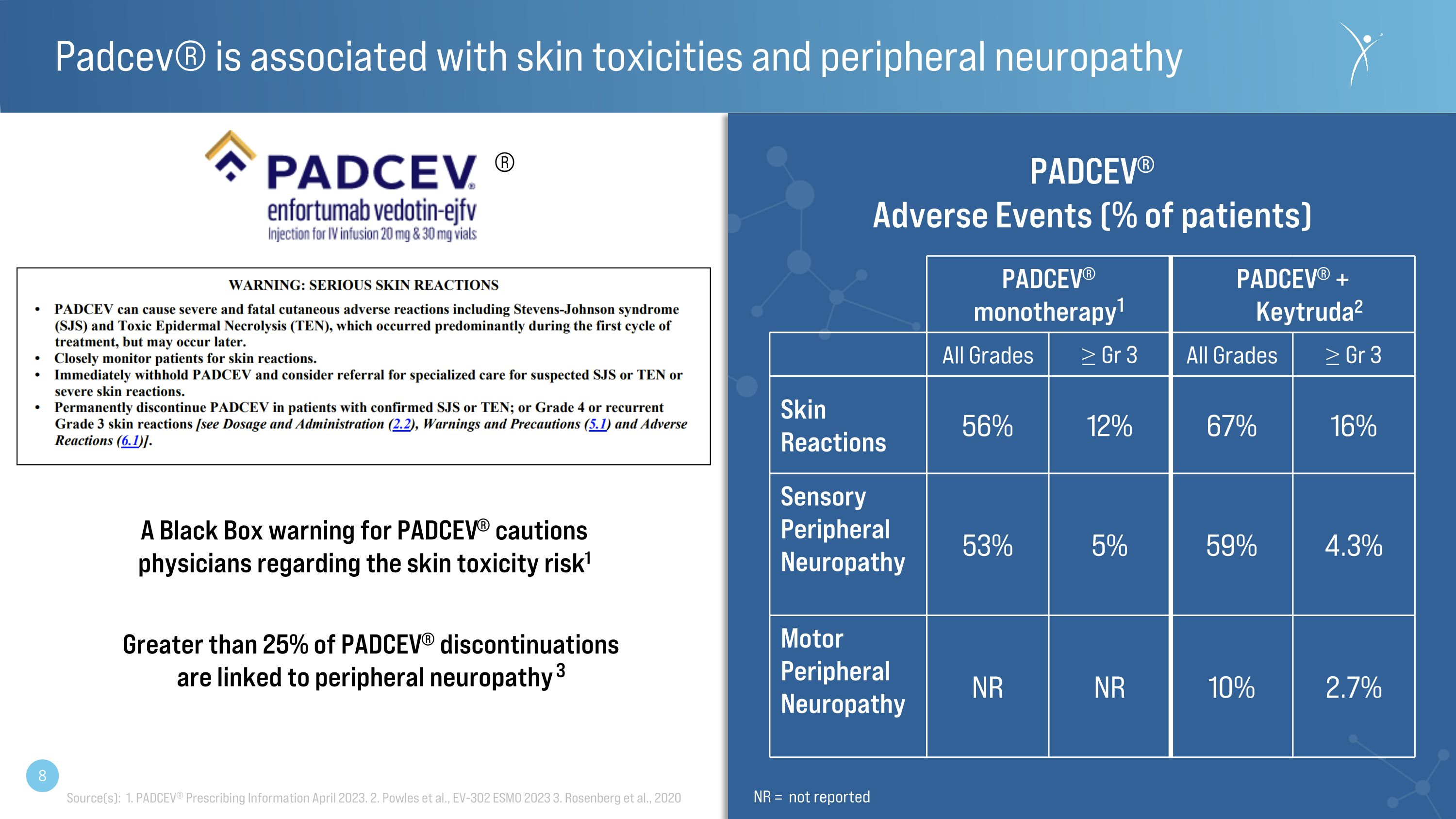
Padcev® is associated with skin toxicities and peripheral neuropathy PADCEV® monotherapy1 PADCEV® + Keytruda2 All Grades ≥ Gr 3 All Grades ≥ Gr 3 Skin Reactions 56% 12% 67% 16% Sensory Peripheral Neuropathy 53% 5% 59% 4.3% Motor Peripheral Neuropathy NR NR 10% 2.7% PADCEV® Adverse Events (% of patients) Source(s): 1. PADCEV® Prescribing Information April 2023. 2. Powles et al., EV-302 ESMO 2023 3. Rosenberg et al., 2020 Greater than 25% of PADCEV® discontinuations are linked to peripheral neuropathy 3 ® A Black Box warning for PADCEV® cautions physicians regarding the skin toxicity risk1 NR = not reported
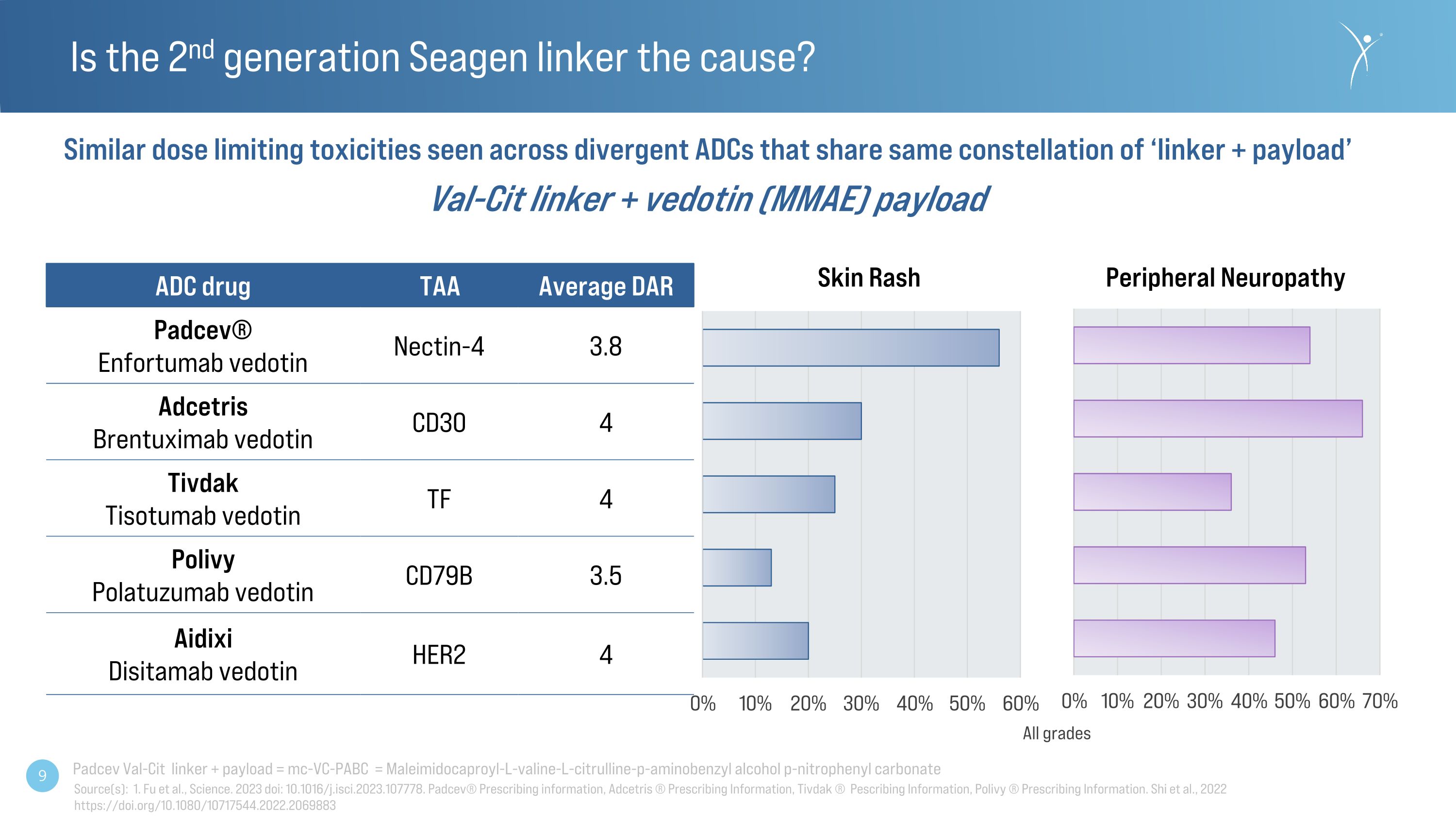
Is the 2nd generation Seagen linker the cause? Skin Rash Peripheral Neuropathy Similar dose limiting toxicities seen across divergent ADCs that share same constellation of ‘linker + payload’ Val-Cit linker + vedotin (MMAE) payload All grades ADC drug TAA Average DAR Padcev® Enfortumab vedotin Nectin-4 3.8 Adcetris Brentuximab vedotin CD30 4 Tivdak Tisotumab vedotin TF 4 Polivy Polatuzumab vedotin CD79B 3.5 Aidixi Disitamab vedotin HER2 4 Source(s): 1. Fu et al., Science. 2023 doi: 10.1016/j.isci.2023.107778. Padcev® Prescribing information, Adcetris ® Prescribing Information, Tivdak ® Pescribing Information, Polivy ® Prescribing Information. Shi et al., 2022 https://doi.org/10.1080/10717544.2022.2069883 Padcev Val-Cit linker + payload = mc-VC-PABC = Maleimidocaproyl-L-valine-L-citrulline-p-aminobenzyl alcohol p-nitrophenyl carbonate
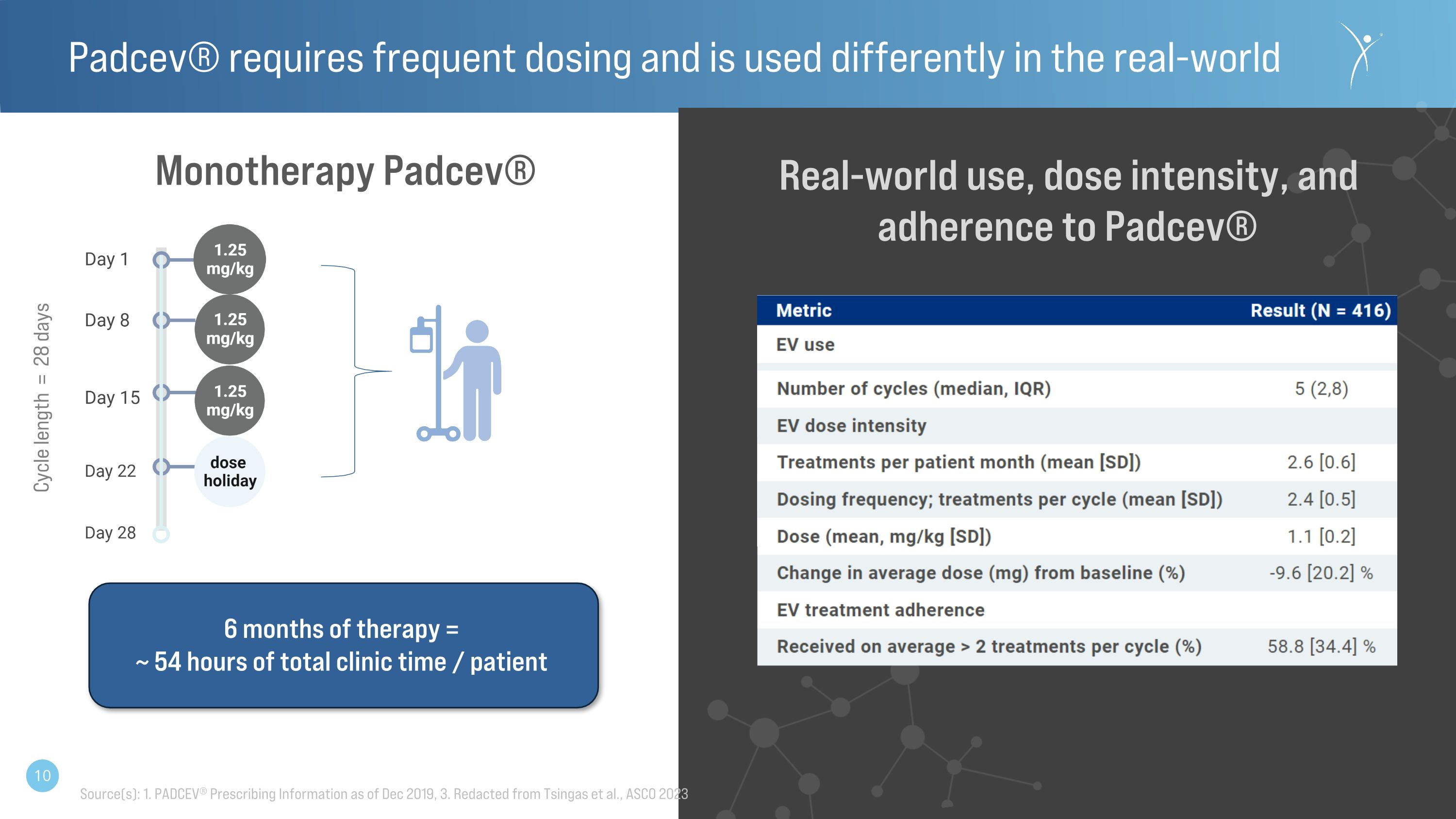
Monotherapy Padcev® Source(s): 1. PADCEV® Prescribing Information as of Dec 2019, 3. Redacted from Tsingas et al., ASCO 2023 6 months of therapy = ~ 54 hours of total clinic time / patient Real-world use, dose intensity, and adherence to Padcev® Padcev® requires frequent dosing and is used differently in the real-world Cycle length = 28 days
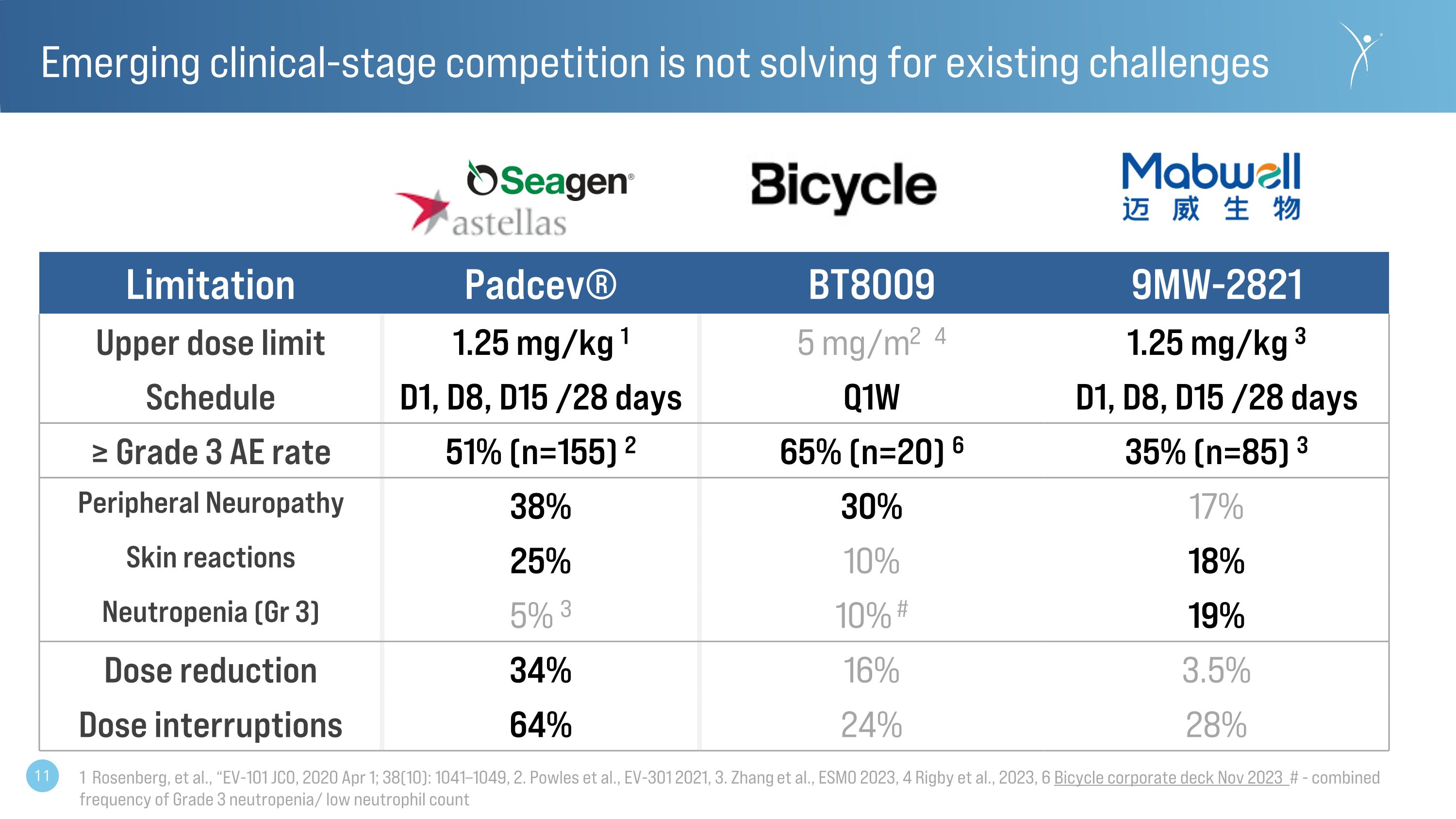
Emerging clinical-stage competition is not solving for existing challenges Limitation Padcev® BT8009 9MW-2821 Upper dose limit 1.25 mg/kg 1 5 mg/m2 4 1.25 mg/kg 3 Schedule D1, D8, D15 /28 days Q1W D1, D8, D15 /28 days ≥ Grade 3 AE rate 51% (n=155) 2 65% (n=20) 6 35% (n=85) 3 Peripheral Neuropathy 38% 30% 17% Skin reactions 25% 10% 18% Neutropenia (Gr 3) 5% 3 10% # 19% Dose reduction 34% 16% 3.5% Dose interruptions 64% 24% 28% 1 Rosenberg, et al., “EV-101 JCO, 2020 Apr 1; 38(10): 1041–1049, 2. Powles et al., EV-301 2021, 3. Zhang et al., ESMO 2023, 4 Rigby et al., 2023, 6 Bicycle corporate deck Nov 2023 # - combined frequency of Grade 3 neutropenia/ low neutrophil count
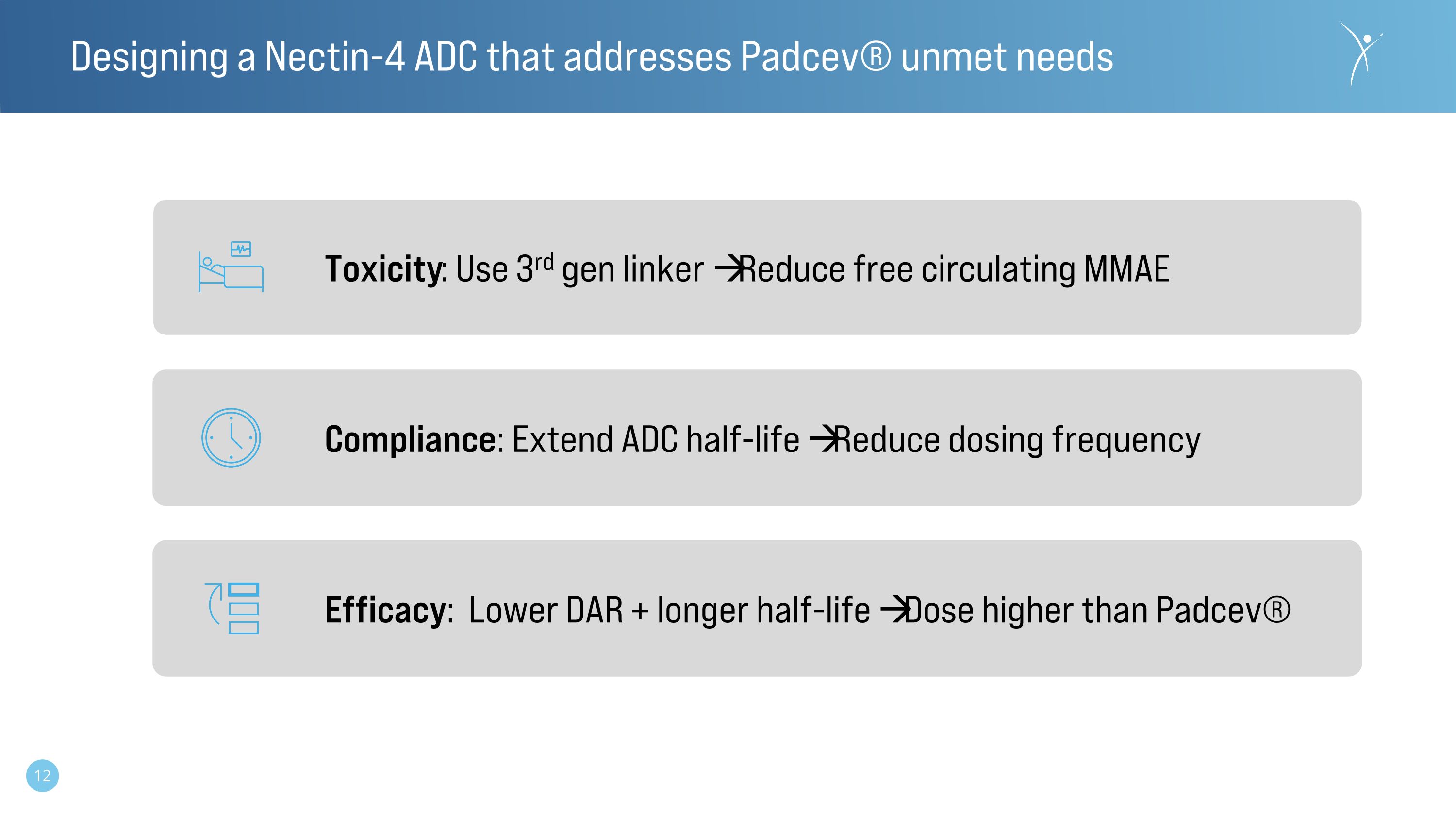
Designing a Nectin-4 ADC that addresses Padcev® unmet needs Toxicity: Use 3rd gen linker Reduce free circulating MMAE Compliance: Extend ADC half-life Reduce dosing frequency Efficacy: Lower DAR + longer half-life Dose higher than Padcev®
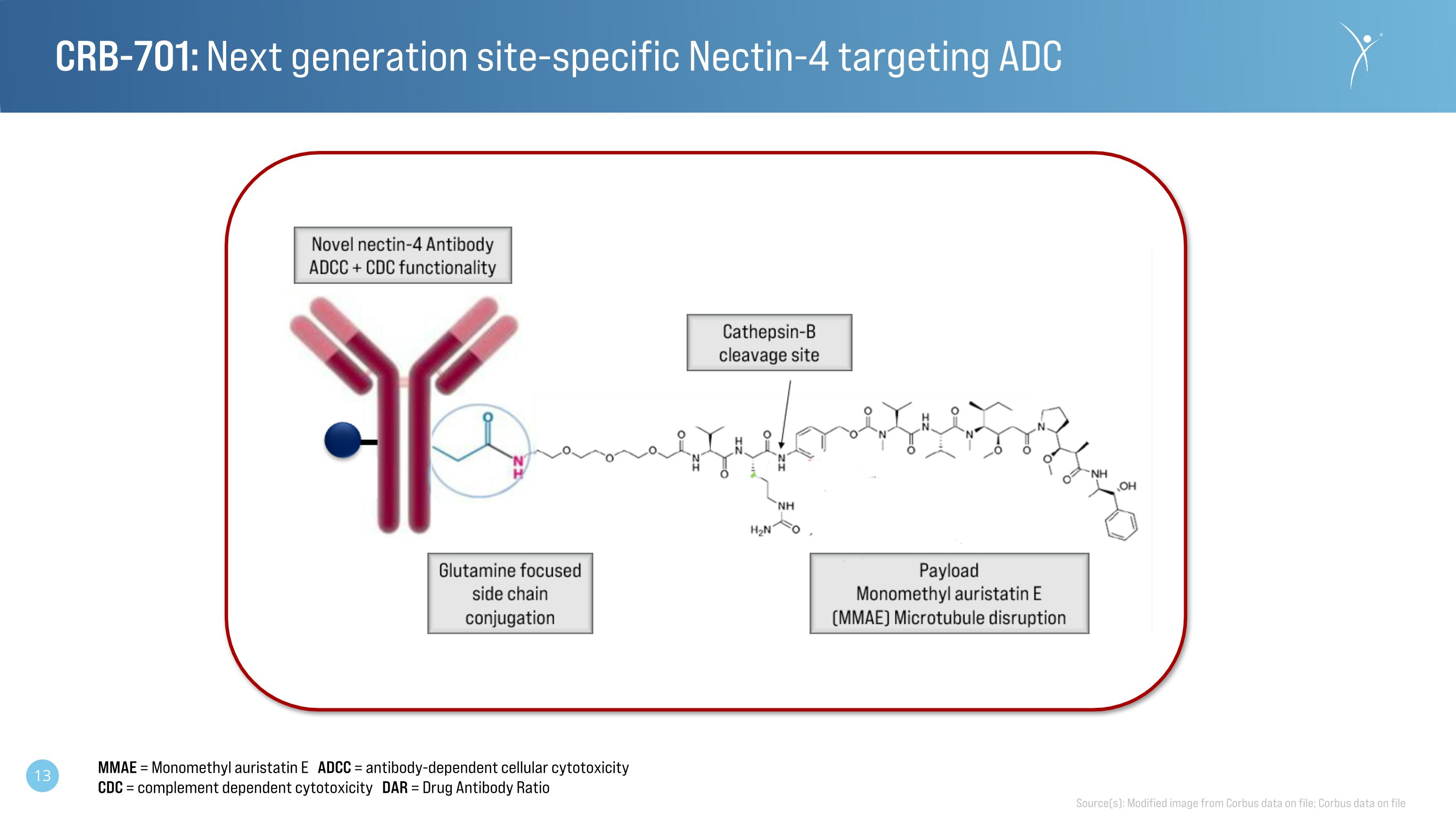
CRB-701: Next generation site-specific Nectin-4 targeting ADC Source(s): Modified image from Corbus data on file; Corbus data on file MMAE = Monomethyl auristatin E ADCC = antibody-dependent cellular cytotoxicity CDC = complement dependent cytotoxicity DAR = Drug Antibody Ratio
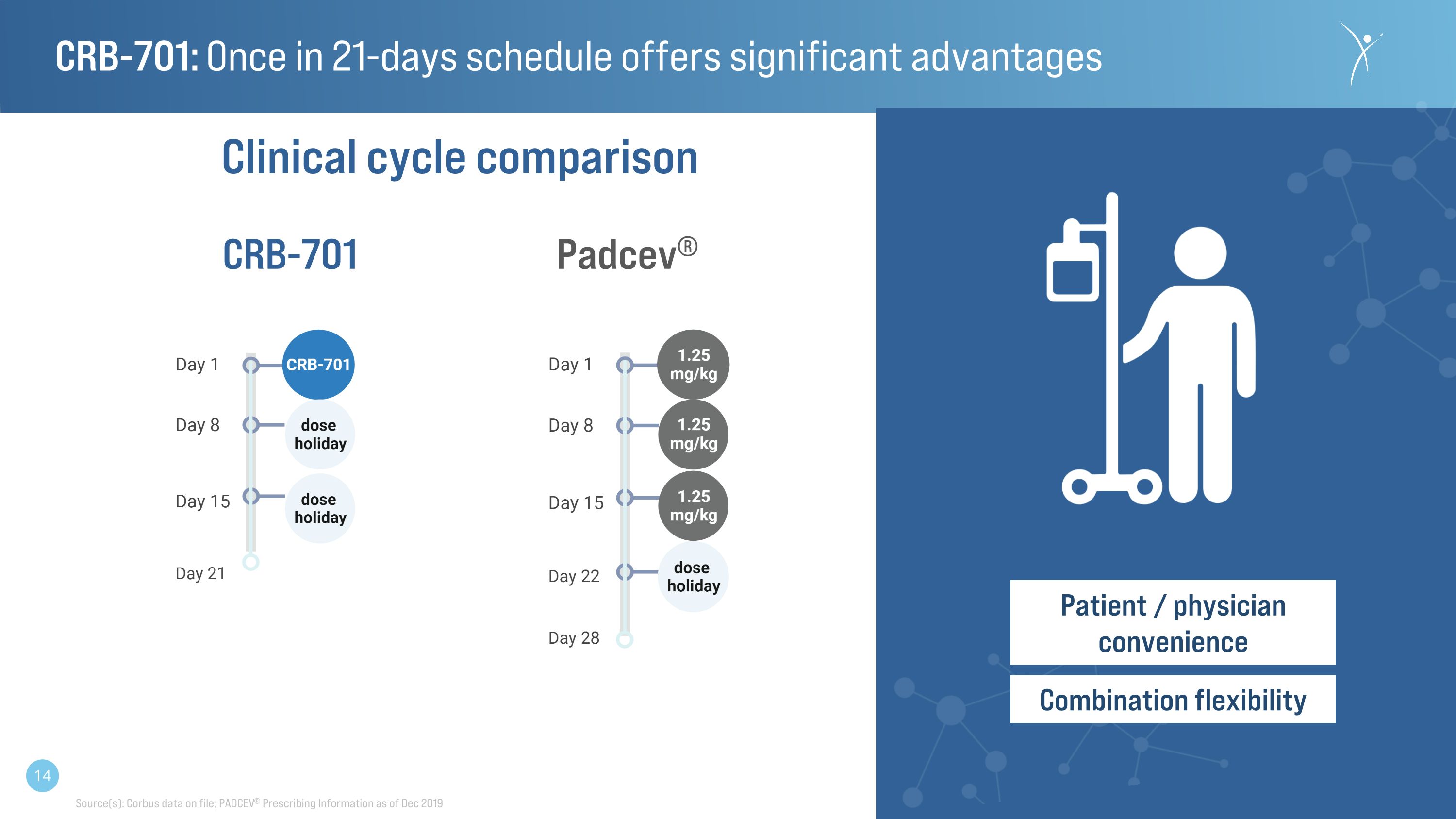
CRB-701: Once in 21-days schedule offers significant advantages Padcev® CRB-701 Patient / physician convenience Combination flexibility Clinical cycle comparison Source(s): Corbus data on file; PADCEV® Prescribing Information as of Dec 2019
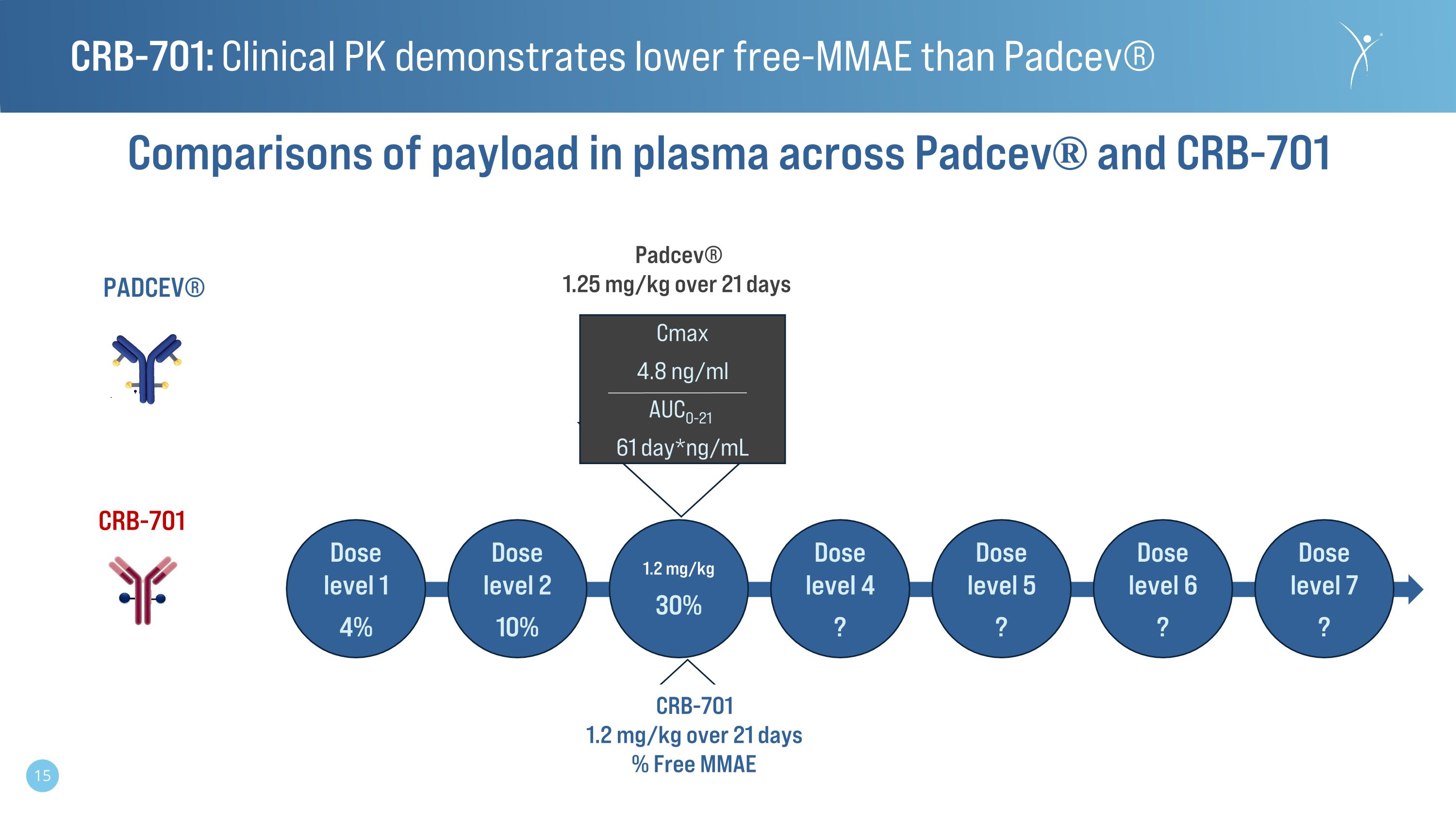
CRB-701: Clinical PK demonstrates lower free-MMAE than Padcev® 15 Corbus Pharmaceuticals - Confidential Comparisons of payload in plasma across Padcev® and CRB-701 CRB-701 PADCEV® Dose level 1 4% Dose level 2 10% Dose level 4 ? Dose level 5 ? Dose level 6 ? Dose level 7 ? 1.2 mg/kg 30% Padcev® 1.25 mg/kg over 21 days CRB-701 1.2 mg/kg over 21 days % Free MMAE Cmax 4.8 ng/ml AUC0-21 61 day*ng/mL
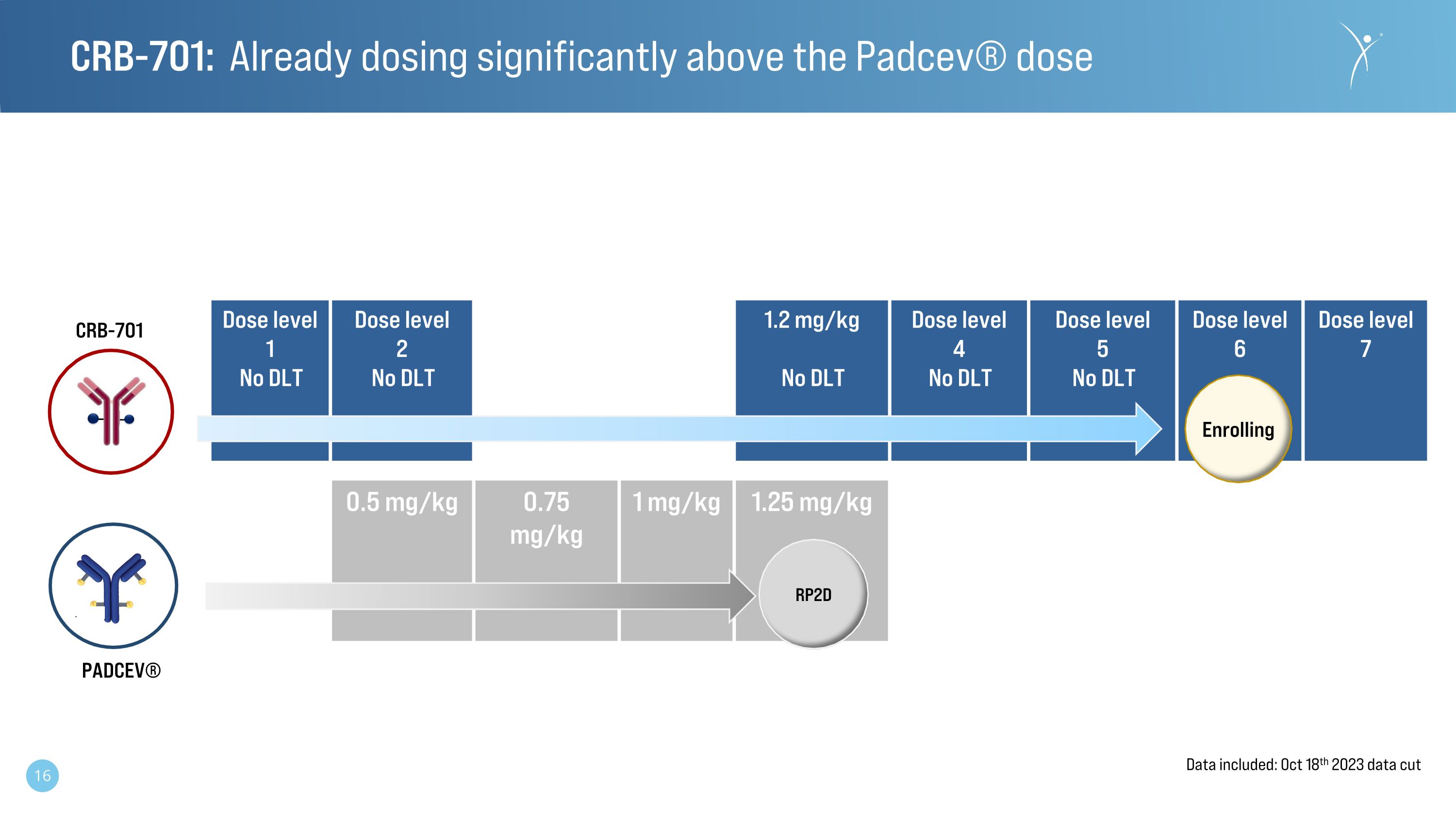
CRB-701: Already dosing significantly above the Padcev® dose 16 Corbus Pharmaceuticals - Confidential Dose level 1 No DLT Dose level 2 No DLT 1.2 mg/kg No DLT Dose level 4 No DLT Dose level 5 No DLT Dose level 6 Dose level 7 0.5 mg/kg 0.75 mg/kg 1 mg/kg 1.25 mg/kg Enrolling RP2D CRB-701 PADCEV® Data included: Oct 18th 2023 data cut
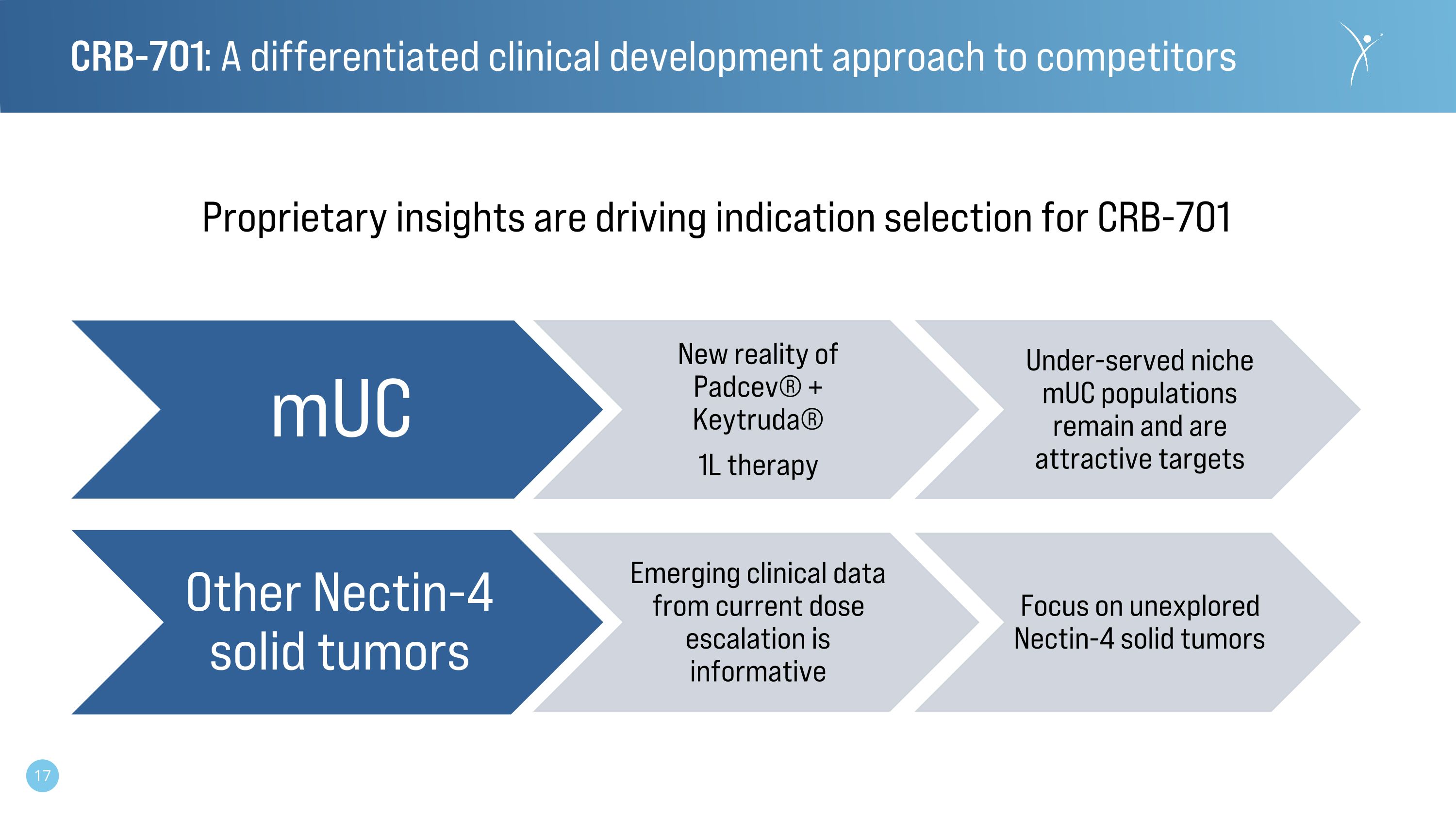
CRB-701: A differentiated clinical development approach to competitors mUC New reality of Padcev® + Keytruda® 1L therapy Under-served niche mUC populations remain and are attractive targets Other Nectin-4 solid tumors Emerging clinical data from current dose escalation is informative Focus on unexplored Nectin-4 solid tumors Proprietary insights are driving indication selection for CRB-701
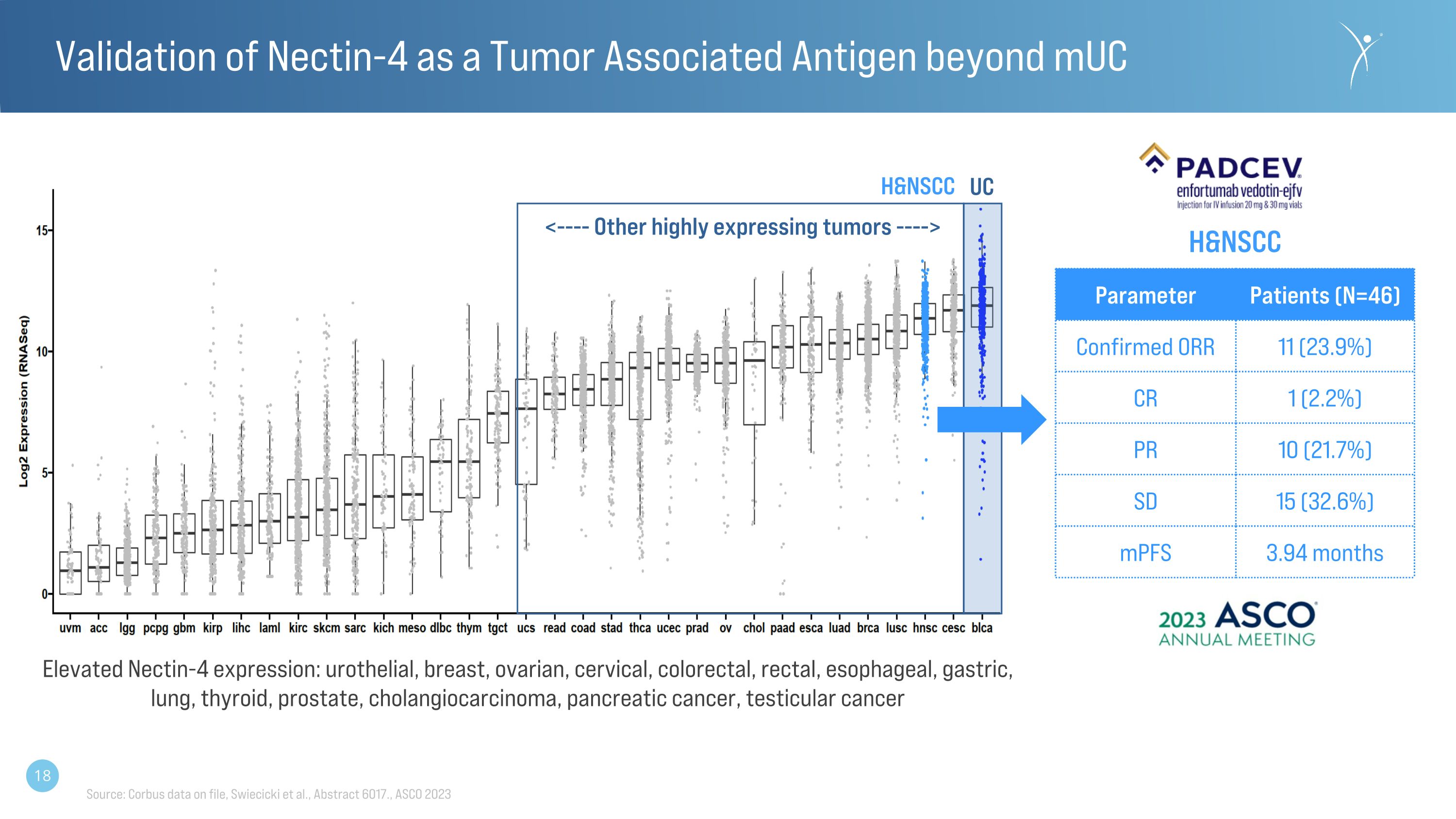
Validation of Nectin-4 as a Tumor Associated Antigen beyond mUC Parameter Patients (N=46) Confirmed ORR 11 (23.9%) CR 1 (2.2%) PR 10 (21.7%) SD 15 (32.6%) mPFS 3.94 months Source: Corbus data on file, Swiecicki et al., Abstract 6017., ASCO 2023 Elevated Nectin-4 expression: urothelial, breast, ovarian, cervical, colorectal, rectal, esophageal, gastric, lung, thyroid, prostate, cholangiocarcinoma, pancreatic cancer, testicular cancer <---- Other highly expressing tumors ----> UC H&NSCC H&NSCC
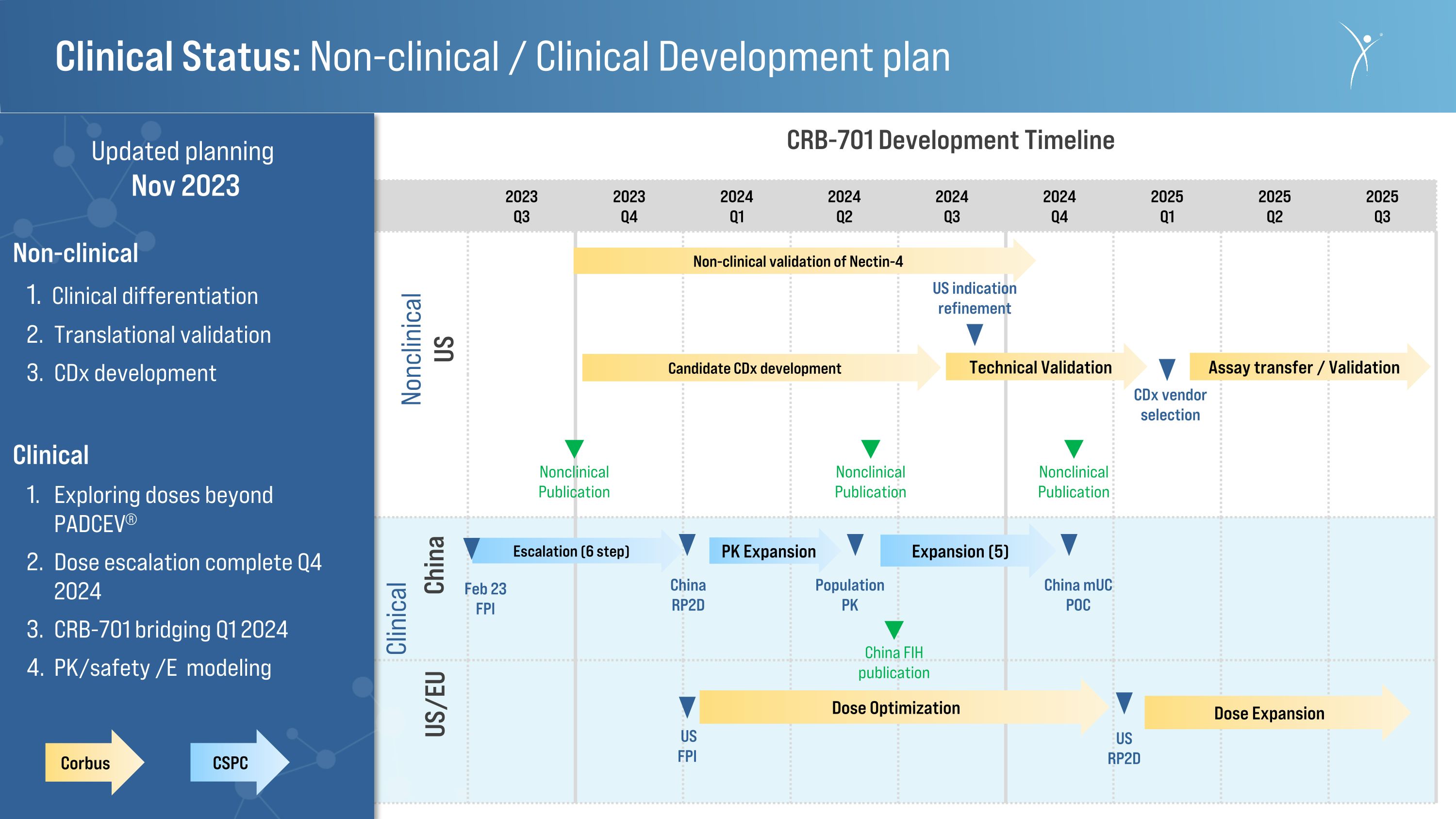
Clinical Status: Non-clinical / Clinical Development plan 2023 Q1 2023 Q2 2023 Q3 2023 Q4 2024 Q1 2024 Q2 2024 Q3 2024 Q4 2025 Q1 2025 Q2 2025 Q3 CRB-701 Development Timeline China US/EU Non-clinical validation of Nectin-4 US RP2D Escalation (6 step) Nonclinical US CDx vendor selection Expansion (5) Feb 23 FPI Population PK China RP2D China mUC POC Assay transfer / Validation Nonclinical Publication US indication refinement Corbus CSPC Dose Optimization Nonclinical Publication Technical Validation Clinical US FPI Updated planning Nov 2023 Non-clinical Clinical differentiation Translational validation CDx development Clinical Exploring doses beyond PADCEV® Dose escalation complete Q4 2024 CRB-701 bridging Q1 2024 PK/safety /E modeling PK Expansion Nonclinical Publication Candidate CDx development China FIH publication Dose Expansion
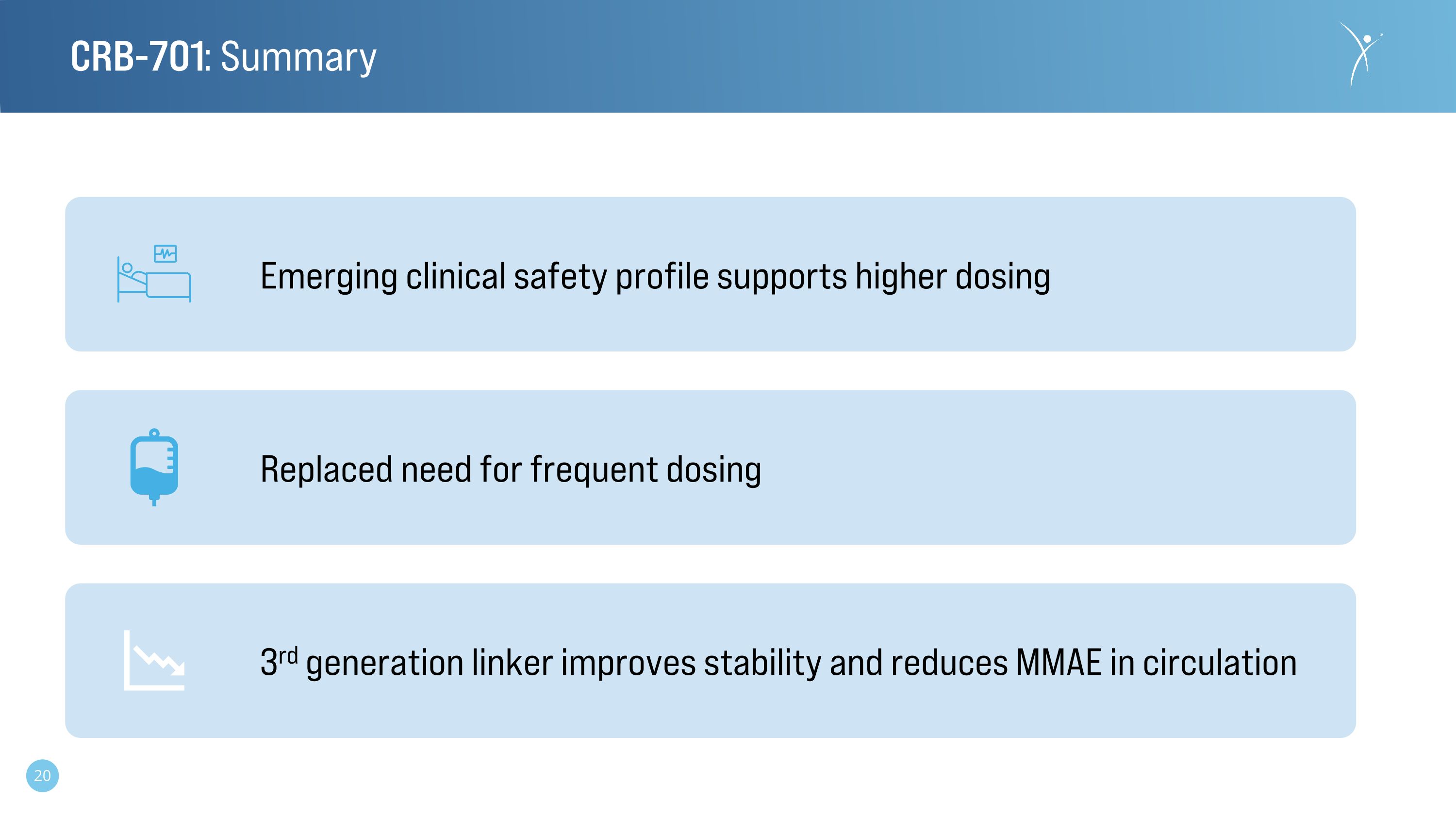
CRB-701: Summary Emerging clinical safety profile supports higher dosing Replaced need for frequent dosing 3rd generation linker improves stability and reduces MMAE in circulation
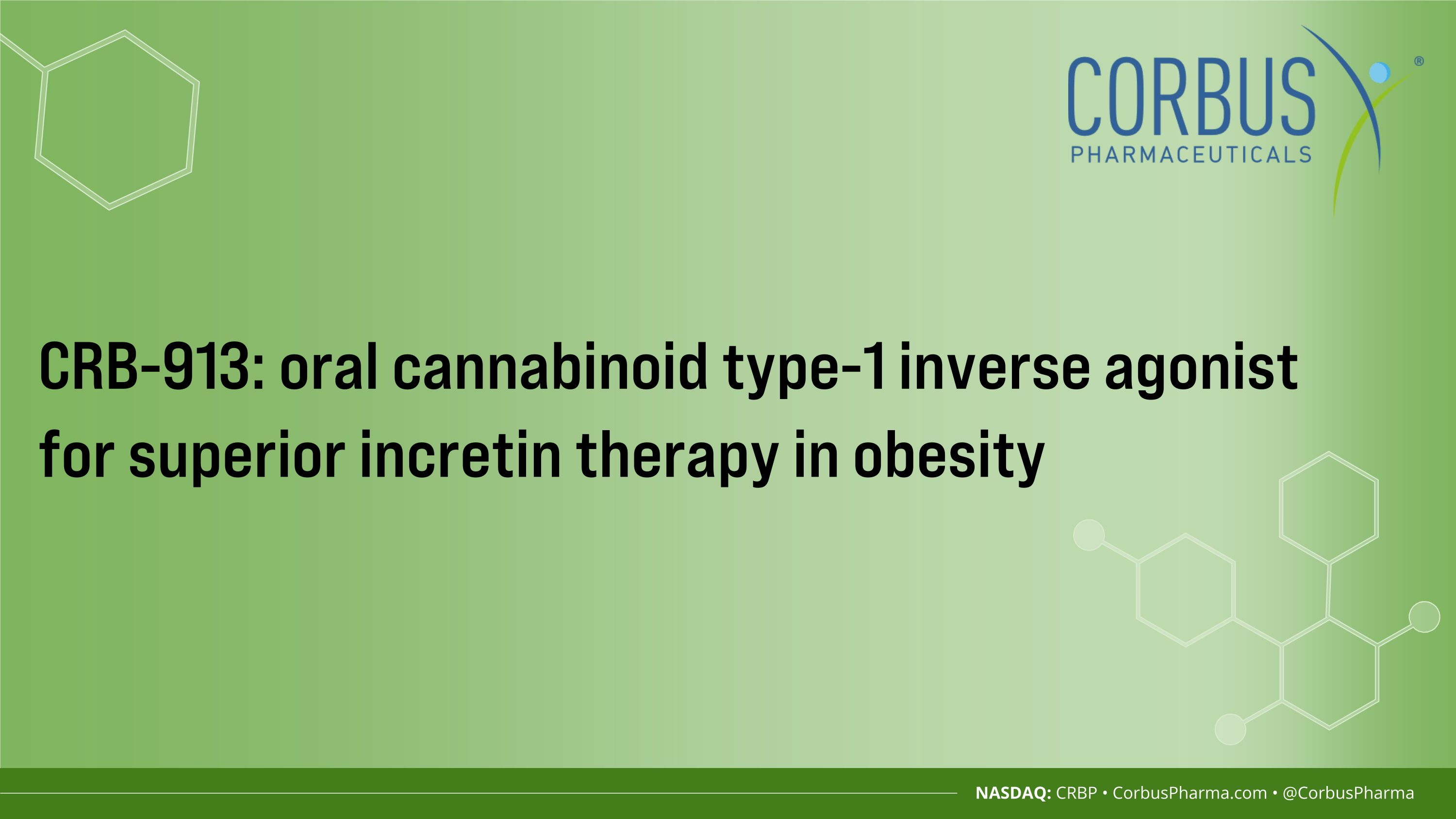
CRB-913: oral cannabinoid type-1 inverse agonist for superior incretin therapy in obesity NASDAQ: CRBP • CorbusPharma.com • @CorbusPharma
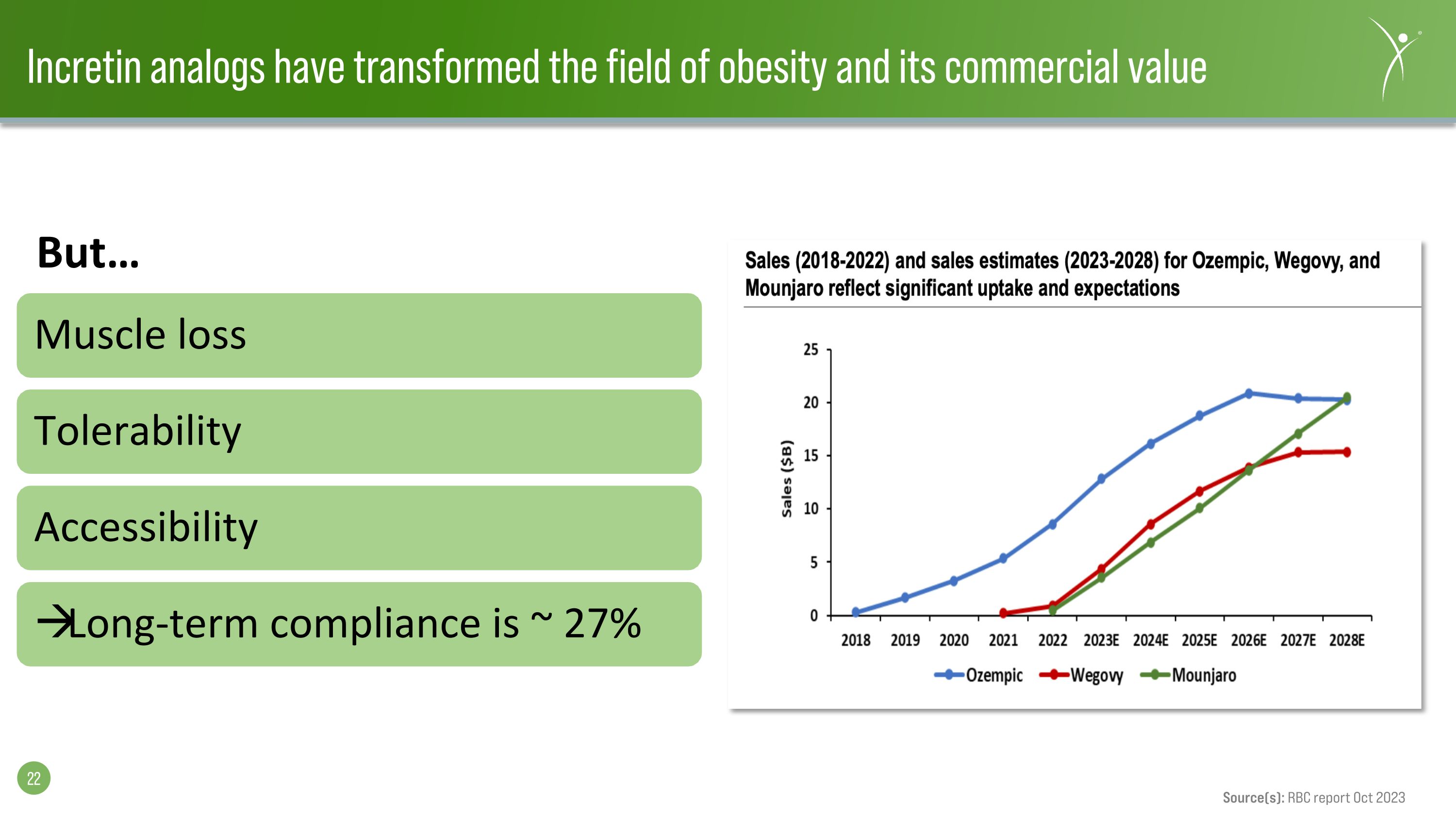
Incretin analogs have transformed the field of obesity and its commercial value Muscle loss Tolerability Accessibility Long-term compliance is ~ 27% Source(s): RBC report Oct 2023 But…
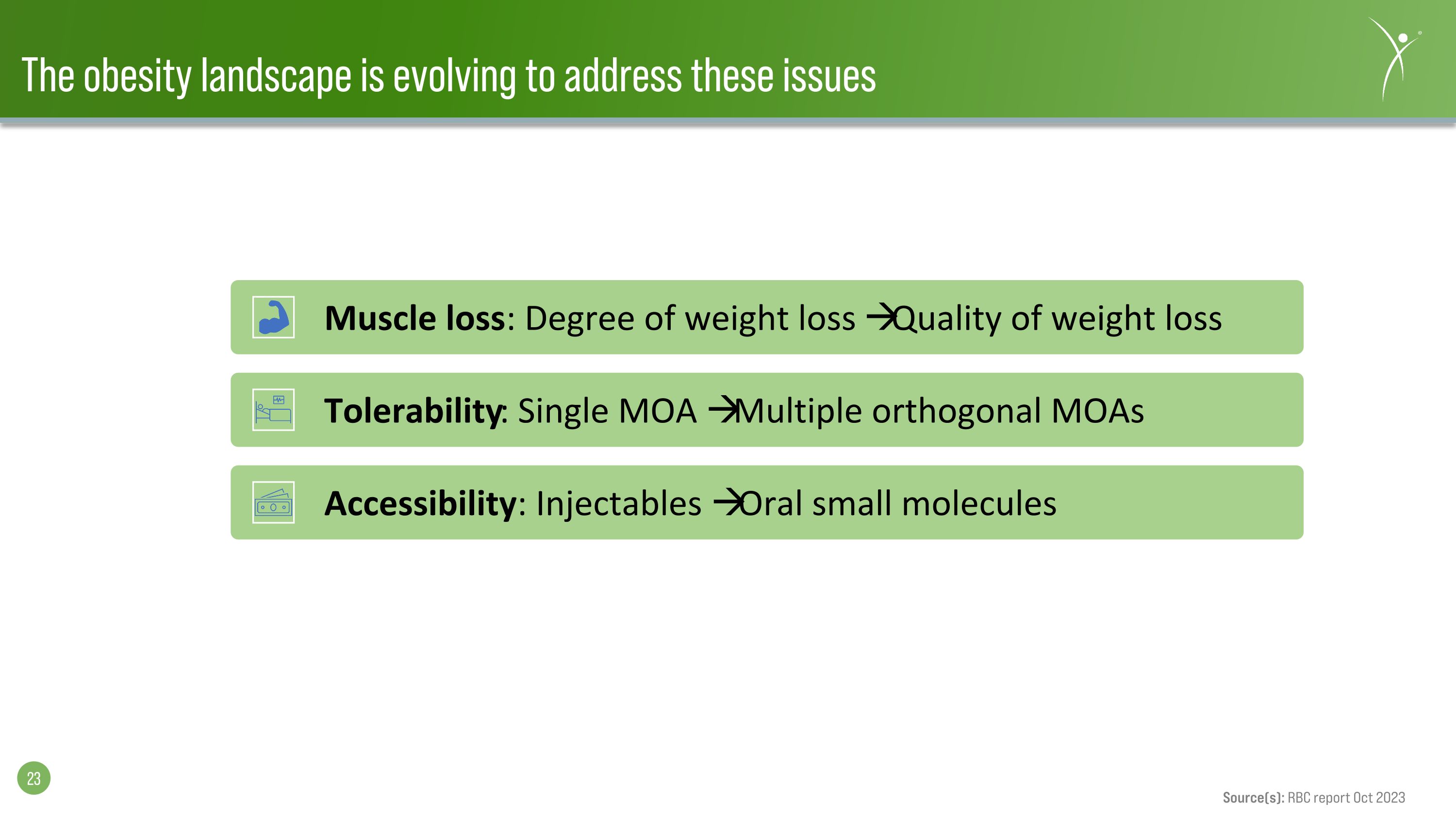
The obesity landscape is evolving to address these issues Muscle loss: Degree of weight loss Quality of weight loss Tolerability: Single MOA Multiple orthogonal MOAs Accessibility: Injectables Oral small molecules Source(s): RBC report Oct 2023
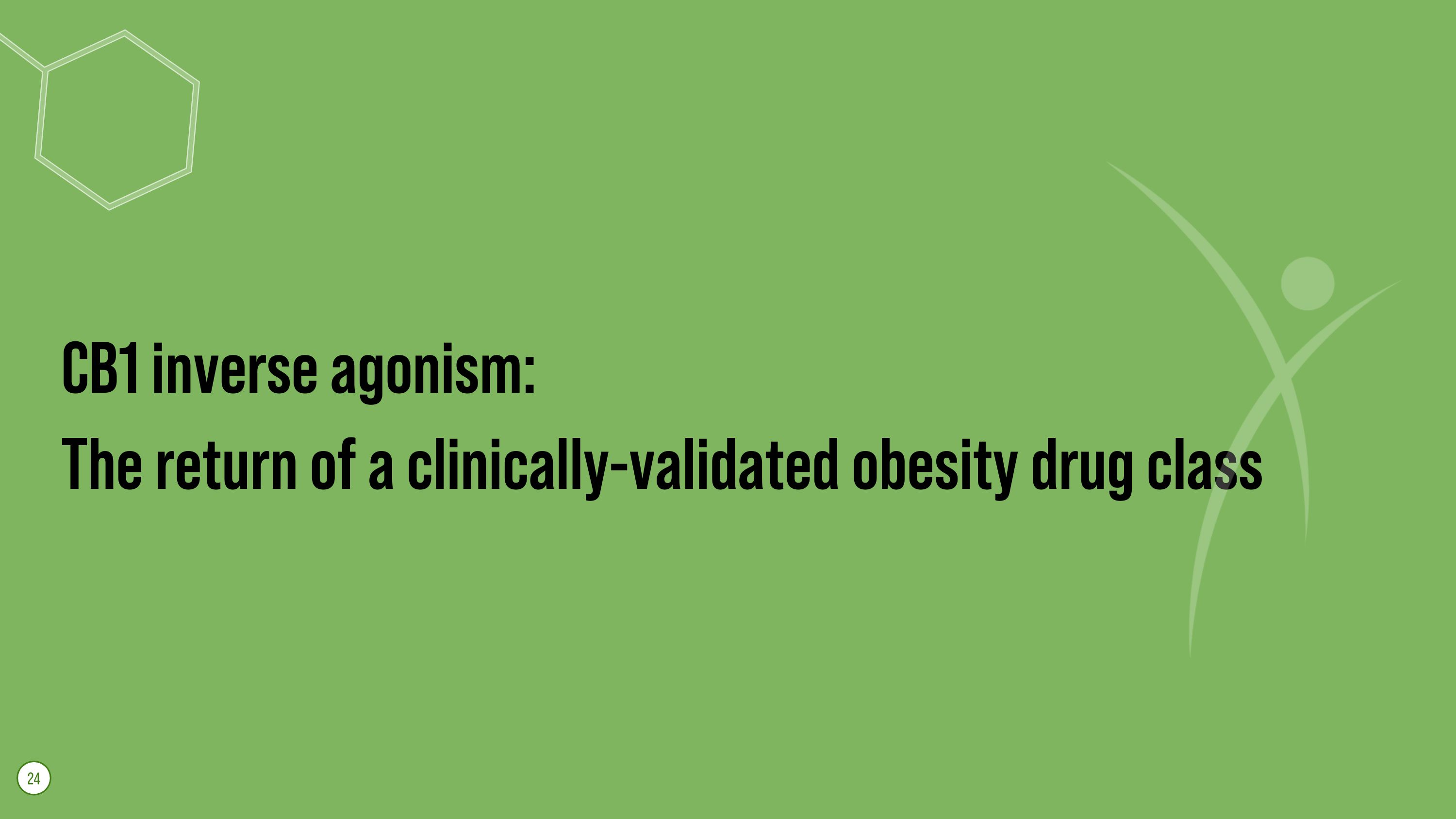
CB1 inverse agonism: The return of a clinically-validated obesity drug class 24
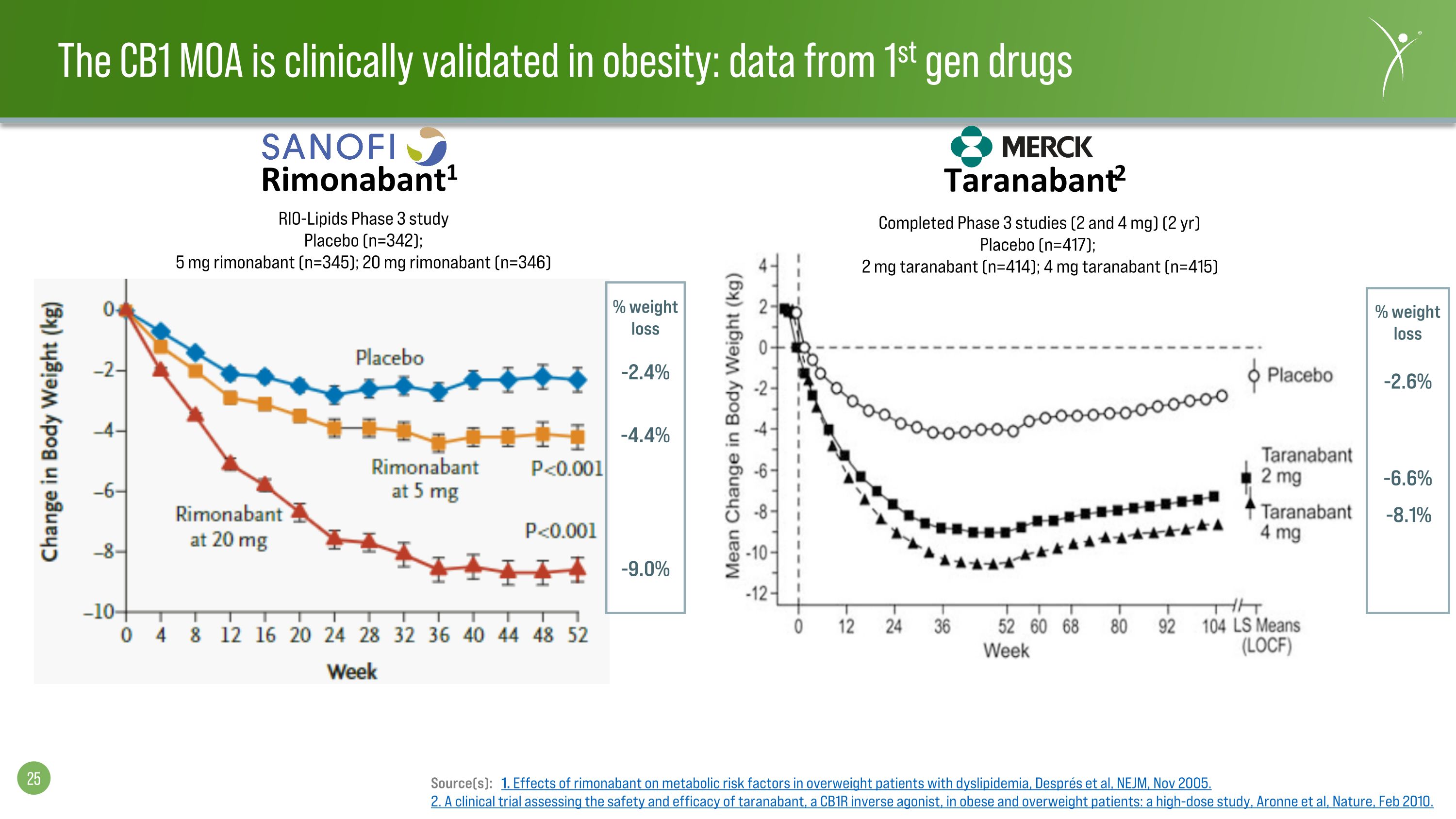
-9.0% -4.4% -2.4% % weight loss RIO-Lipids Phase 3 study Placebo (n=342); 5 mg rimonabant (n=345); 20 mg rimonabant (n=346) Completed Phase 3 studies (2 and 4 mg) (2 yr) Placebo (n=417); 2 mg taranabant (n=414); 4 mg taranabant (n=415) % weight loss -8.1% -6.6% -2.6% Rimonabant1 Taranabant2 Source(s): 1. Effects of rimonabant on metabolic risk factors in overweight patients with dyslipidemia, Després et al, NEJM, Nov 2005. 2. A clinical trial assessing the safety and efficacy of taranabant, a CB1R inverse agonist, in obese and overweight patients: a high-dose study, Aronne et al, Nature, Feb 2010. The CB1 MOA is clinically validated in obesity: data from 1st gen drugs
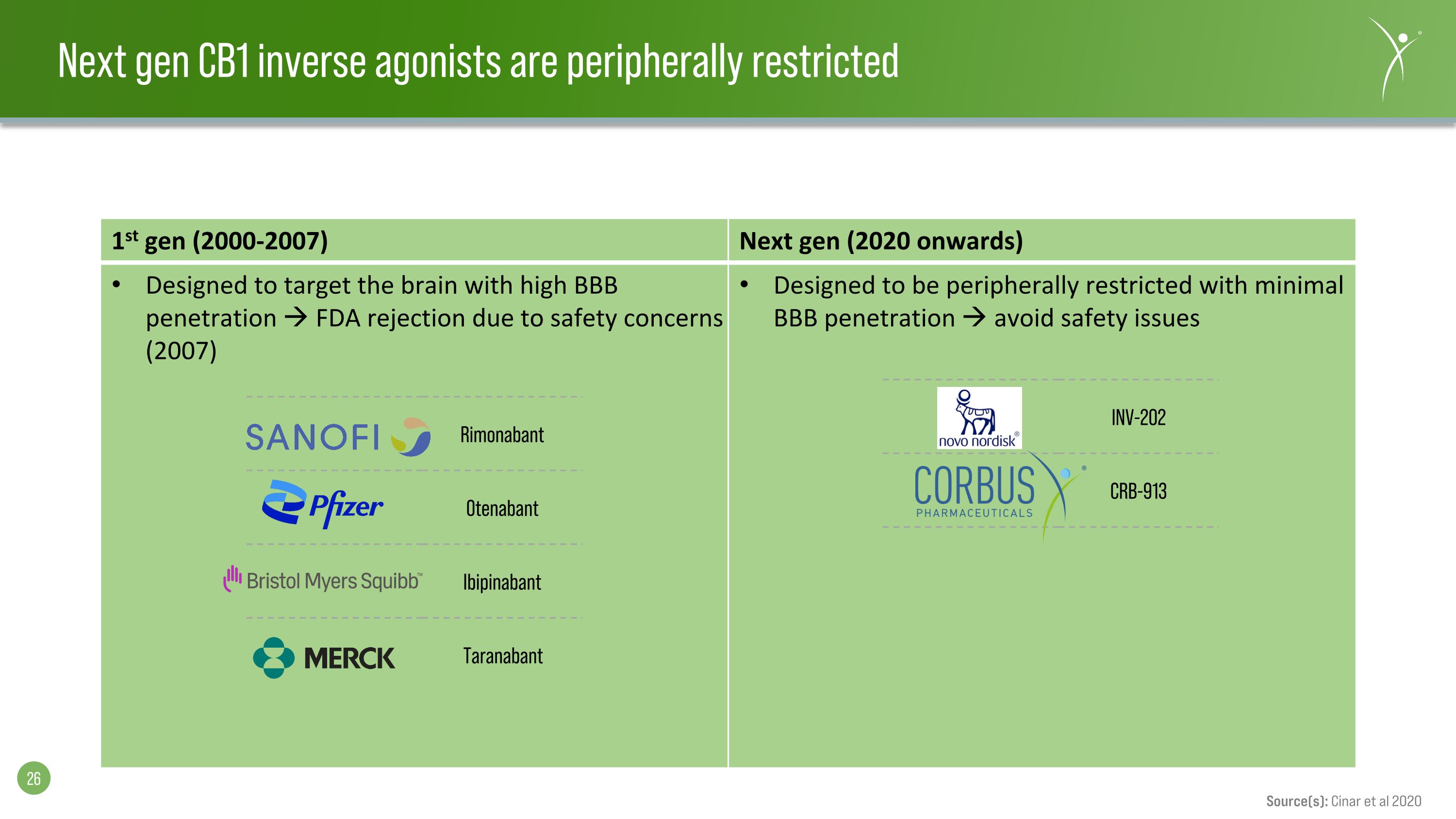
Next gen CB1 inverse agonists are peripherally restricted 1st gen (2000-2007) Next gen (2020 onwards) Designed to target the brain with high BBB penetration FDA rejection due to safety concerns (2007) Designed to be peripherally restricted with minimal BBB penetration avoid safety issues Rimonabant Otenabant Ibipinabant Taranabant INV-202 CRB-913 Source(s): Cinar et al 2020
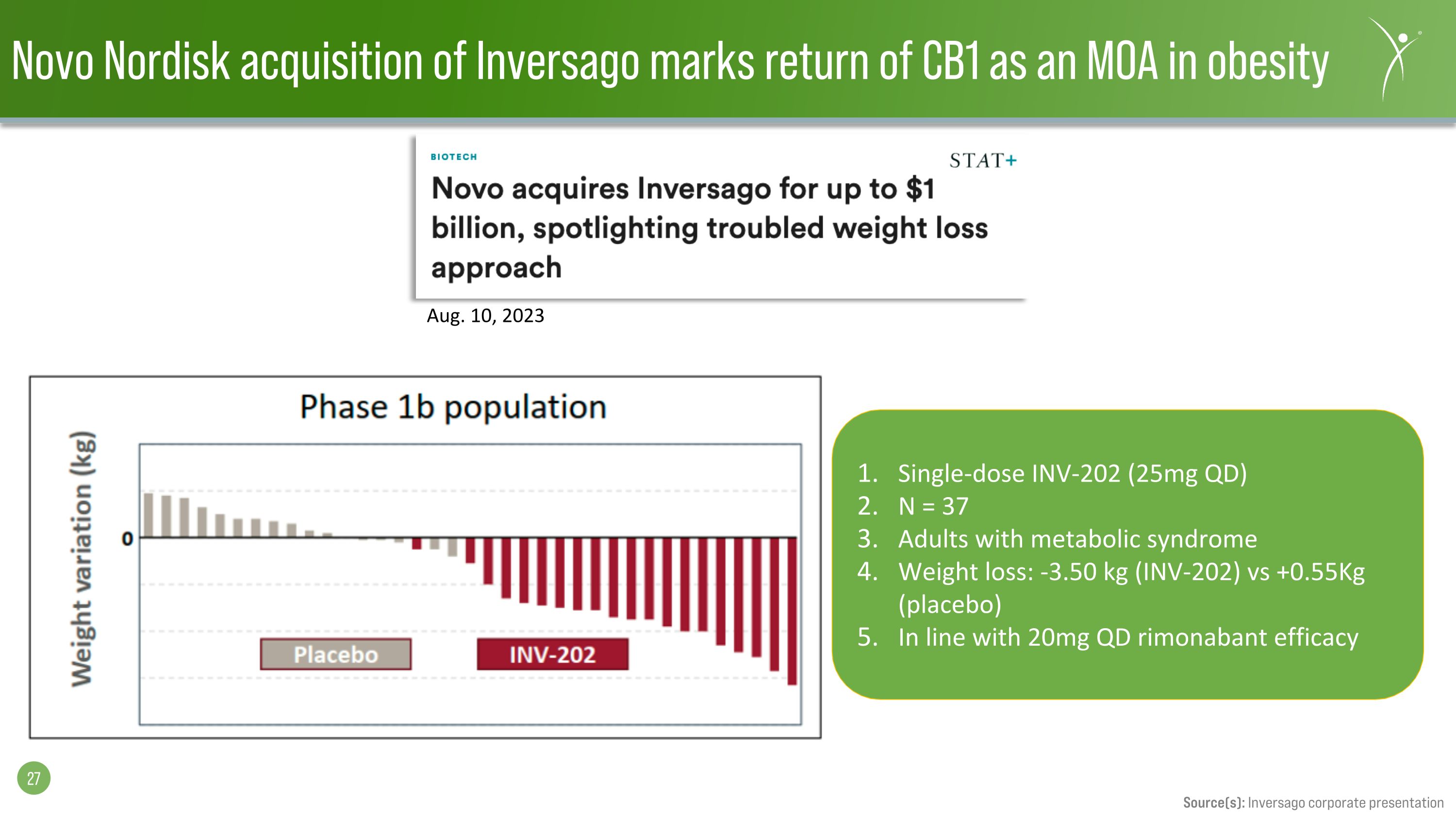
Novo Nordisk acquisition of Inversago marks return of CB1 as an MOA in obesity Single-dose INV-202 (25mg QD) N = 37 Adults with metabolic syndrome Weight loss: -3.50 kg (INV-202) vs +0.55Kg (placebo) In line with 20mg QD rimonabant efficacy Aug. 10, 2023 Source(s): Inversago corporate presentation
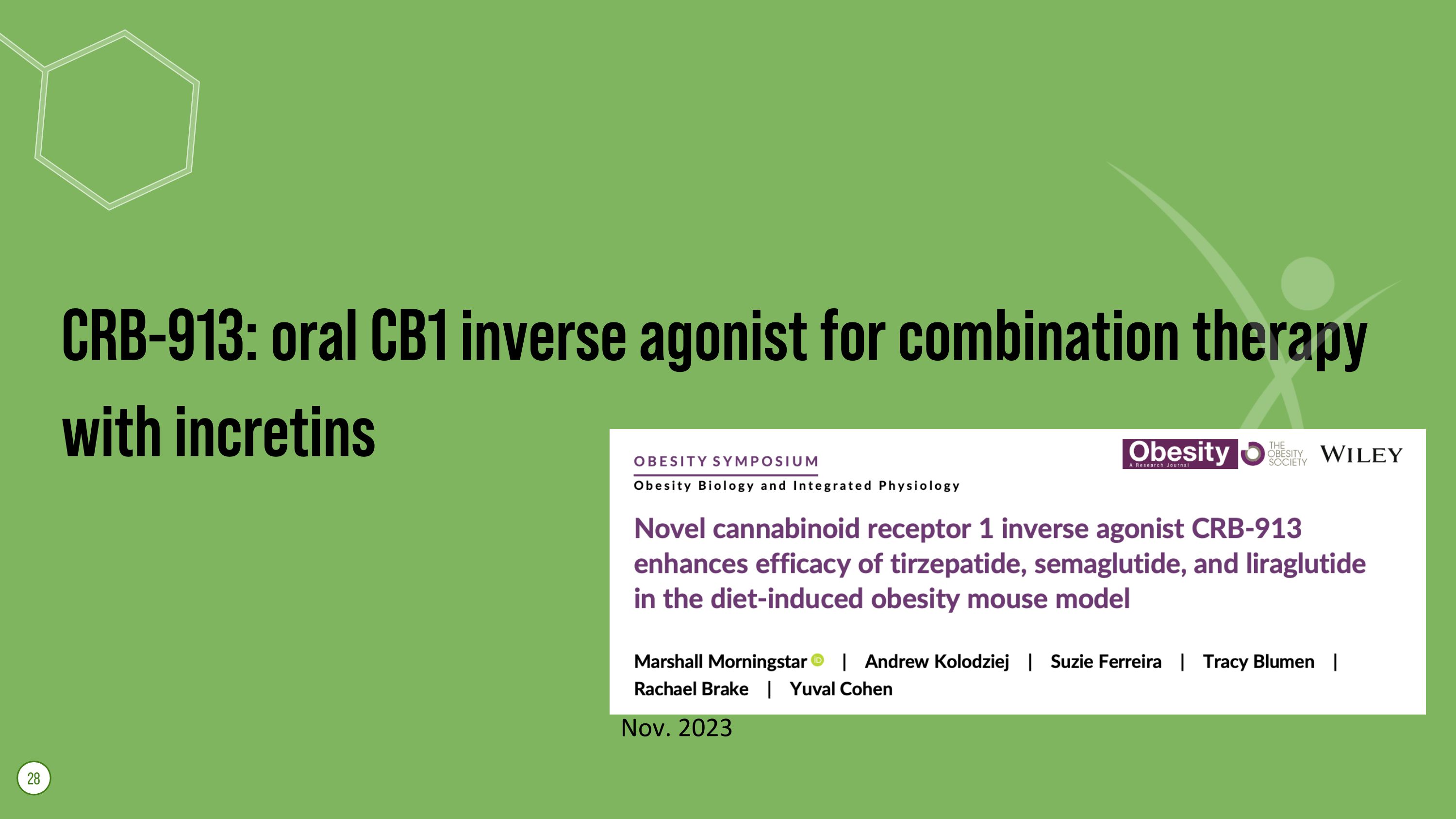
CRB-913: oral CB1 inverse agonist for combination therapy with incretins 28 Nov. 2023
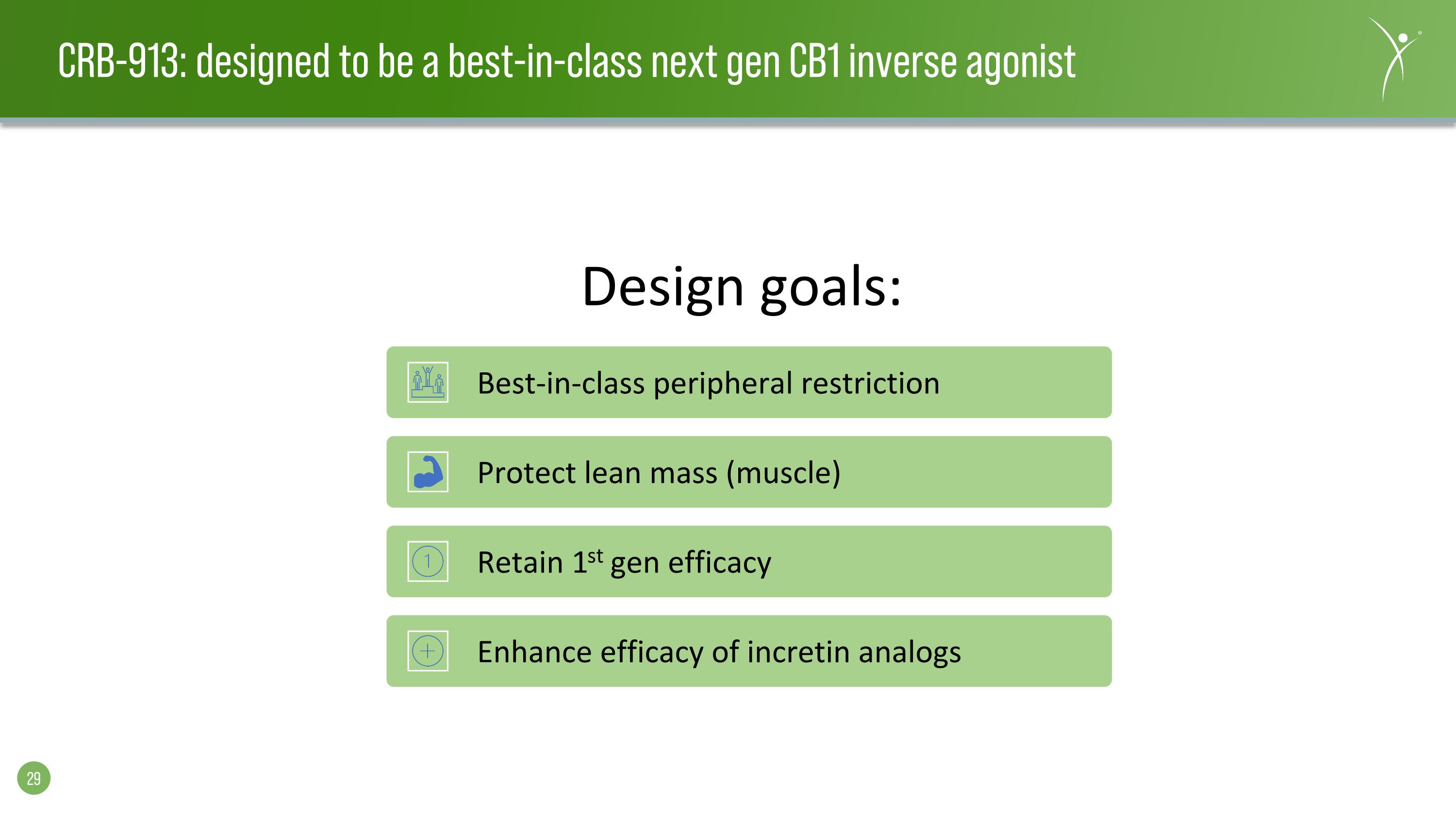
CRB-913: designed to be a best-in-class next gen CB1 inverse agonist Design goals: Best-in-class peripheral restriction Protect lean mass (muscle) Retain 1st gen efficacy Enhance efficacy of incretin analogs
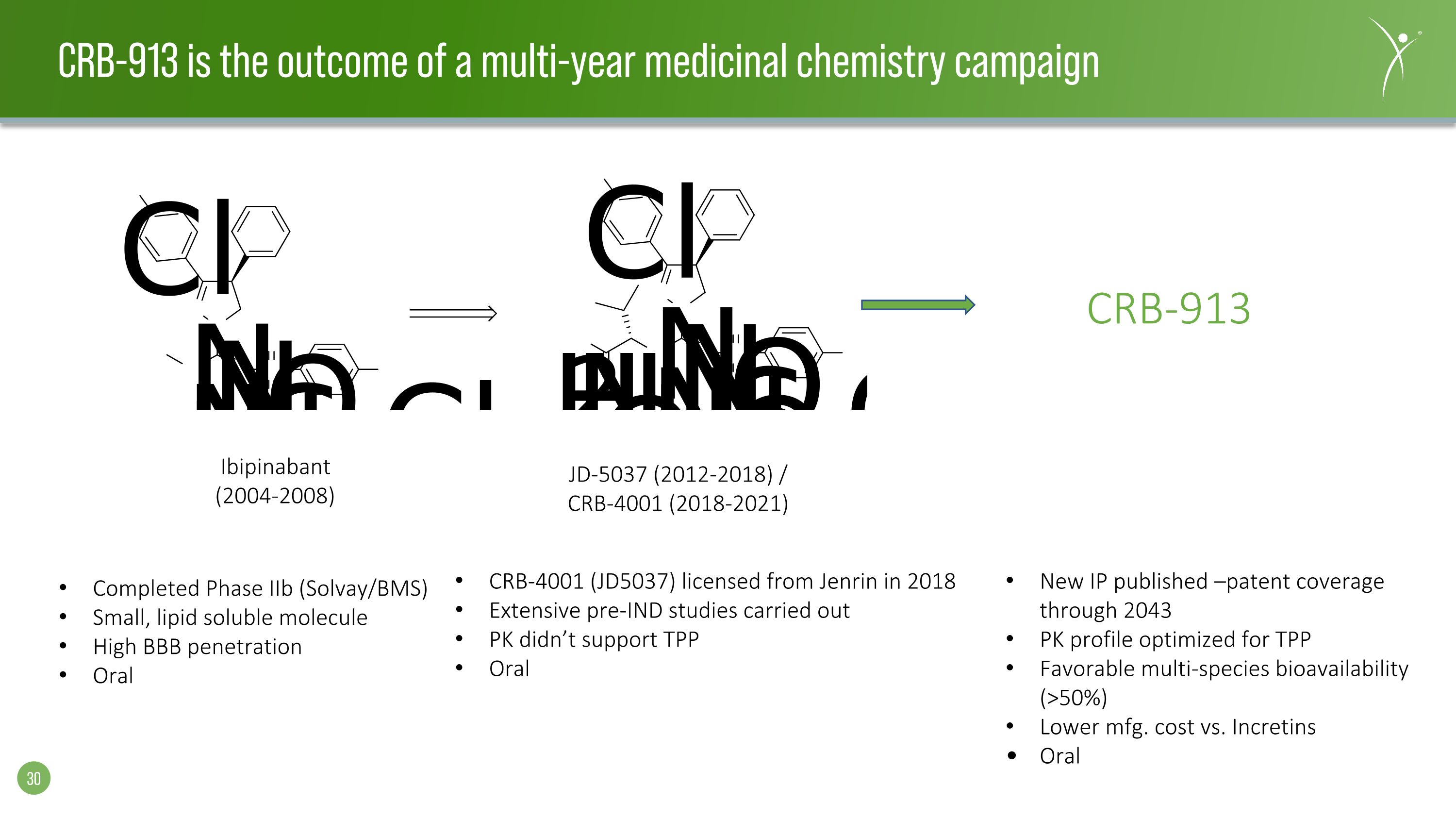
Ibipinabant (2004-2008) JD-5037 (2012-2018) / CRB-4001 (2018-2021) Completed Phase IIb (Solvay/BMS) Small, lipid soluble molecule High BBB penetration Oral CRB-4001 (JD5037) licensed from Jenrin in 2018 Extensive pre-IND studies carried out PK didn’t support TPP Oral CRB-913 New IP published –patent coverage through 2043 PK profile optimized for TPP Favorable multi-species bioavailability (>50%) Lower mfg. cost vs. Incretins Oral CRB-913 is the outcome of a multi-year medicinal chemistry campaign
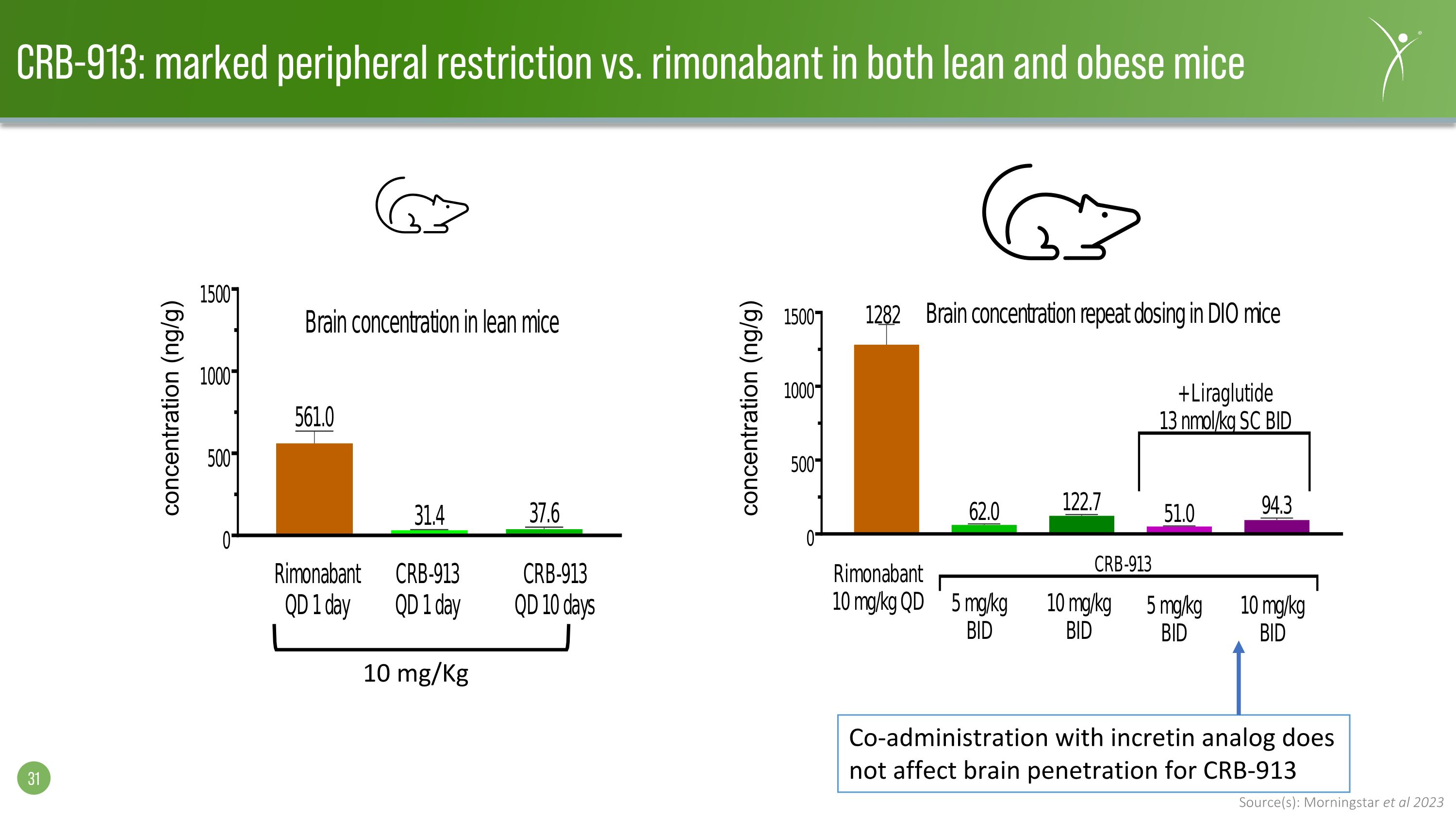
Source(s): Morningstar et al 2023 CRB-913: marked peripheral restriction vs. rimonabant in both lean and obese mice concentration (ng/g) concentration (ng/g) 10 mg/Kg Co-administration with incretin analog does not affect brain penetration for CRB-913
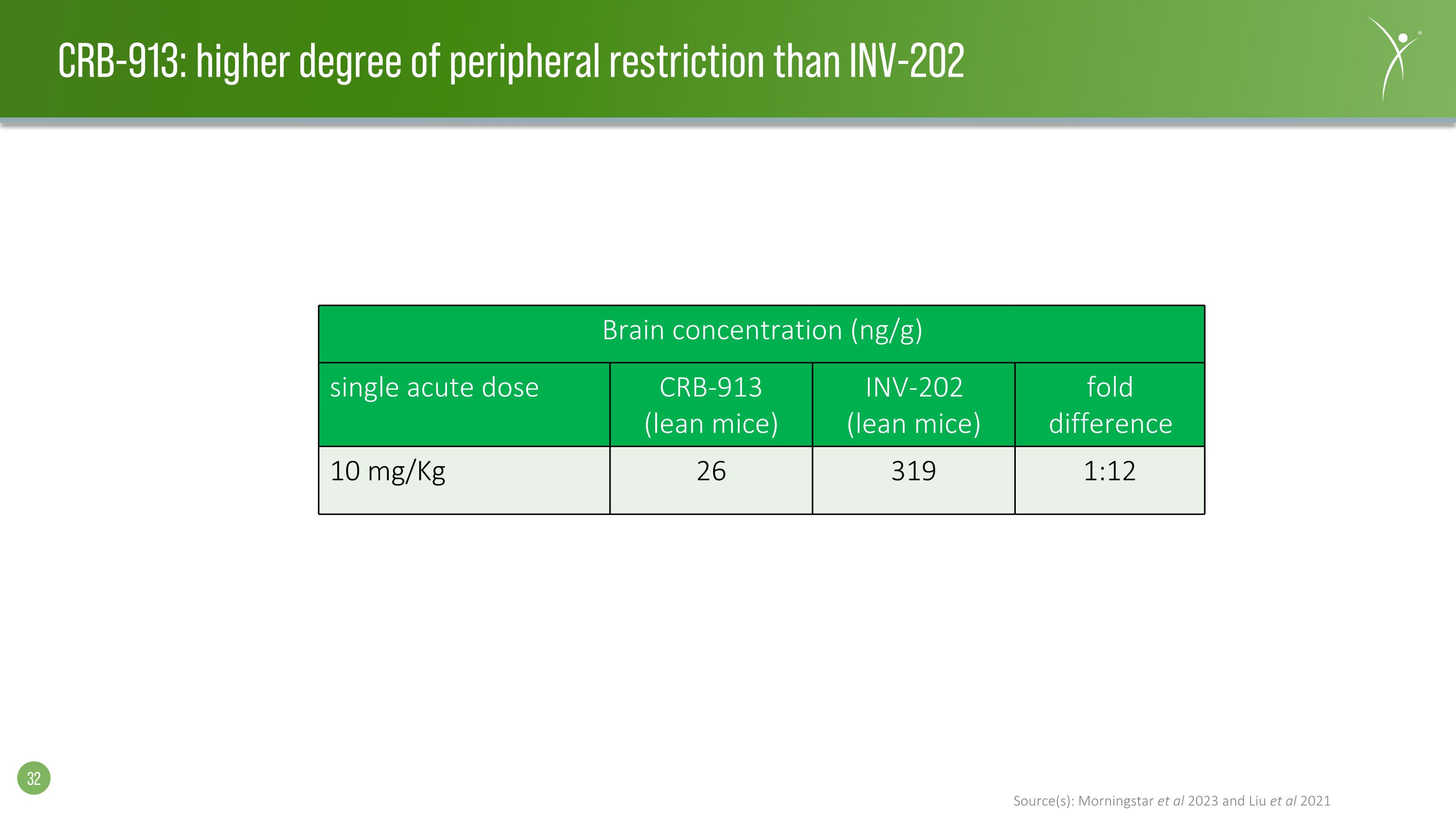
Source(s): Morningstar et al 2023 and Liu et al 2021 CRB-913: higher degree of peripheral restriction than INV-202 Brain concentration (ng/g) single acute dose CRB-913 (lean mice) INV-202 (lean mice) fold difference 10 mg/Kg 26 319 1:12
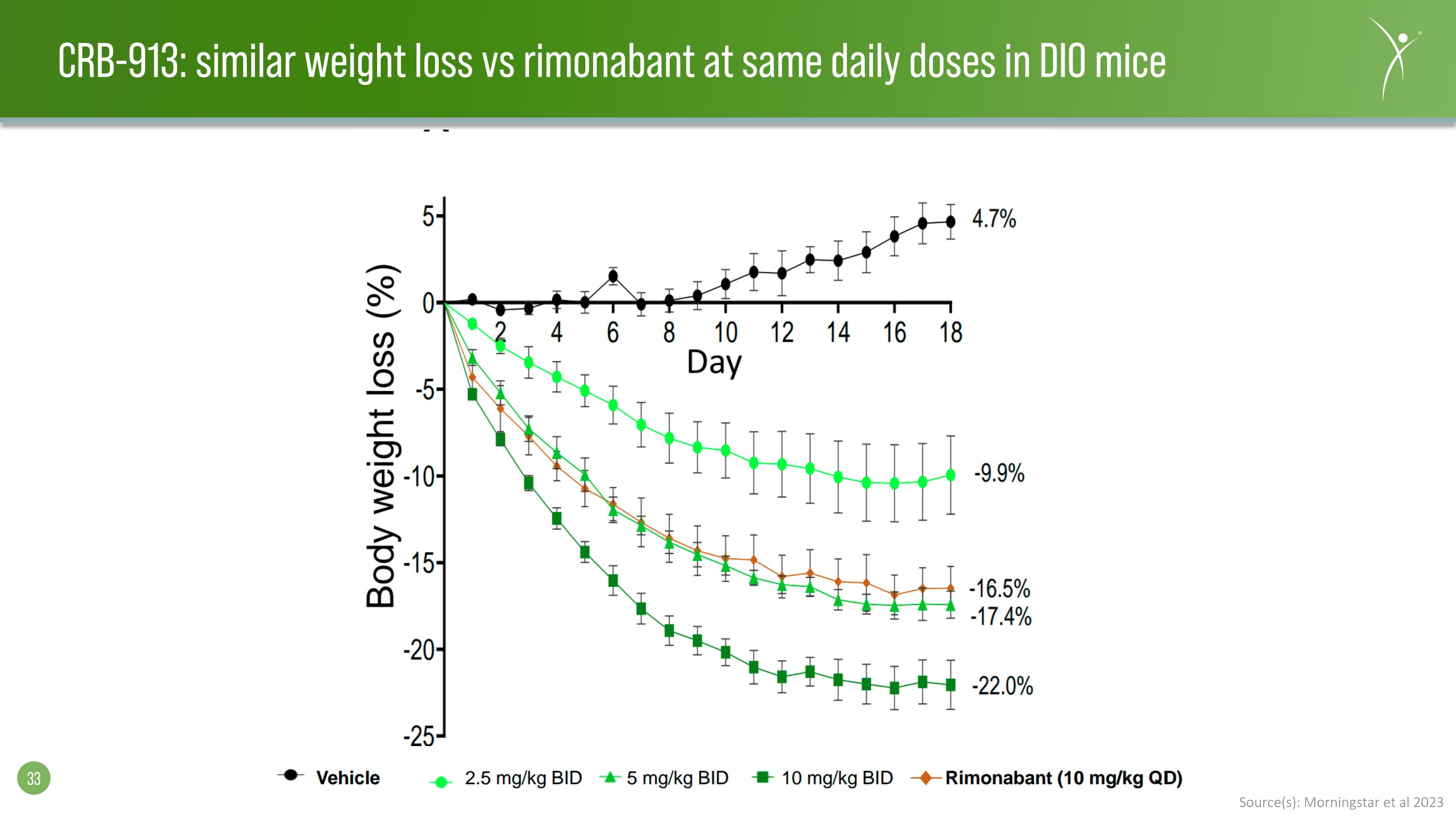
Source(s): Morningstar et al 2023 CRB-913: similar weight loss vs rimonabant at same daily doses in DIO mice
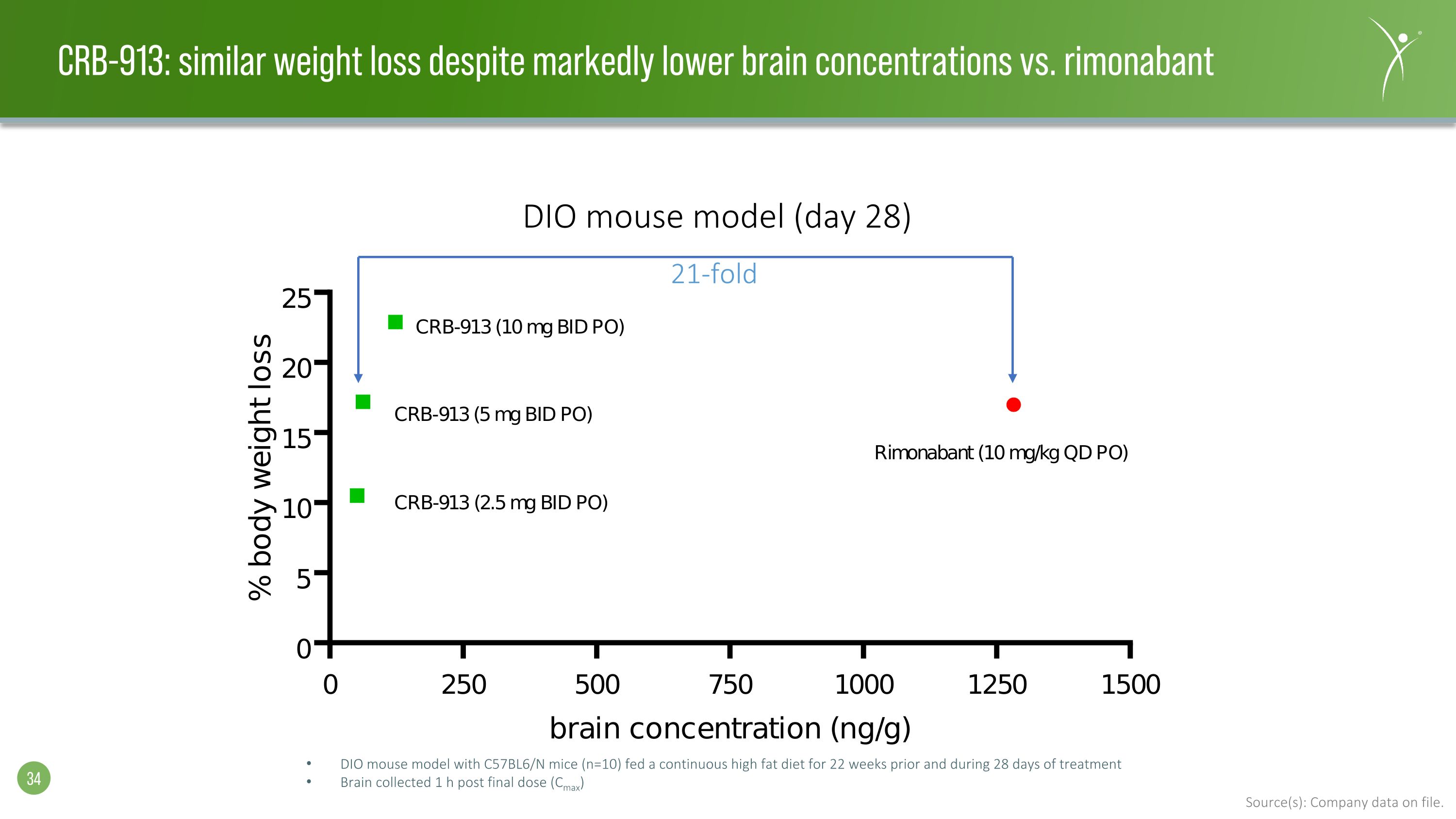
21-fold DIO mouse model (day 28) DIO mouse model with C57BL6/N mice (n=10) fed a continuous high fat diet for 22 weeks prior and during 28 days of treatment Brain collected 1 h post final dose (Cmax) Source(s): Company data on file. CRB-913: similar weight loss despite markedly lower brain concentrations vs. rimonabant
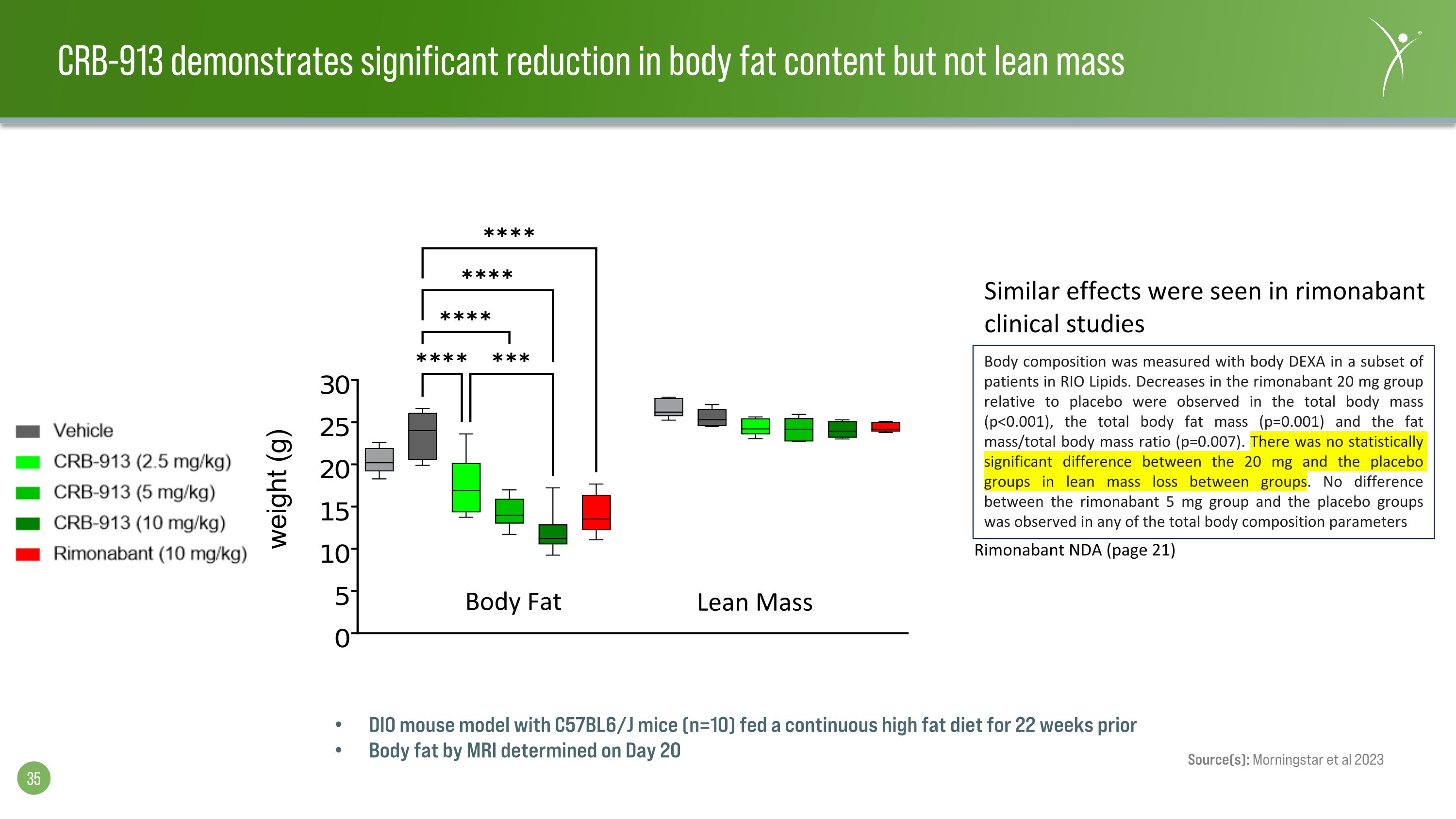
DIO mouse model with C57BL6/J mice (n=10) fed a continuous high fat diet for 22 weeks prior Body fat by MRI determined on Day 20 Source(s): Morningstar et al 2023 CRB-913 demonstrates significant reduction in body fat content but not lean mass weight (g) Body Fat Lean Mass Body composition was measured with body DEXA in a subset of patients in RIO Lipids. Decreases in the rimonabant 20 mg group relative to placebo were observed in the total body mass (p<0.001), the total body fat mass (p=0.001) and the fat mass/total body mass ratio (p=0.007). There was no statistically significant difference between the 20 mg and the placebo groups in lean mass loss between groups. No difference between the rimonabant 5 mg group and the placebo groups was observed in any of the total body composition parameters Rimonabant NDA (page 21) Similar effects were seen in rimonabant clinical studies
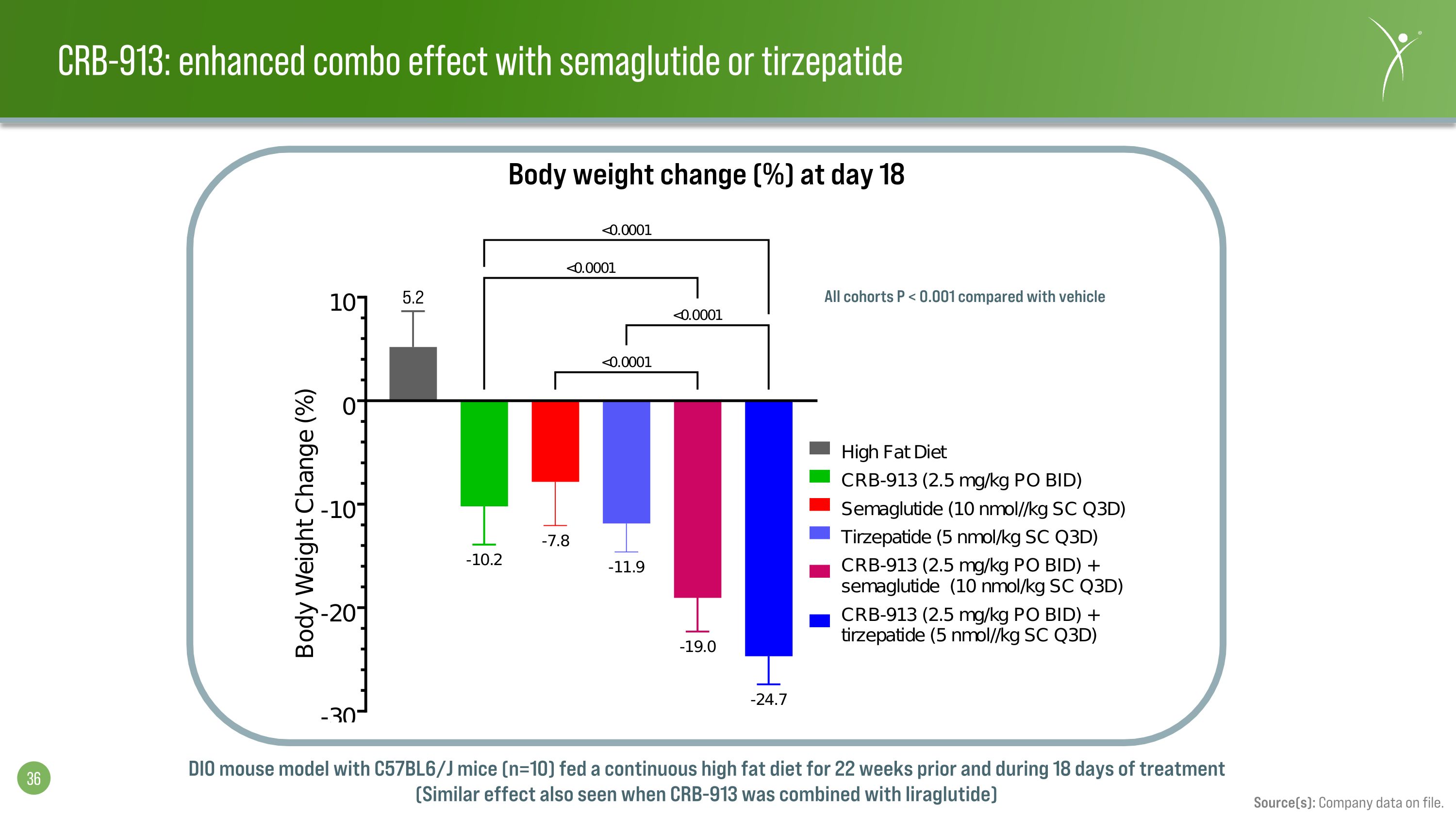
CRB-913: enhanced combo effect with semaglutide or tirzepatide Source(s): Company data on file. DIO mouse model with C57BL6/J mice (n=10) fed a continuous high fat diet for 22 weeks prior and during 18 days of treatment (Similar effect also seen when CRB-913 was combined with liraglutide) Body weight change (%) at day 18 All cohorts P < 0.001 compared with vehicle 5.2
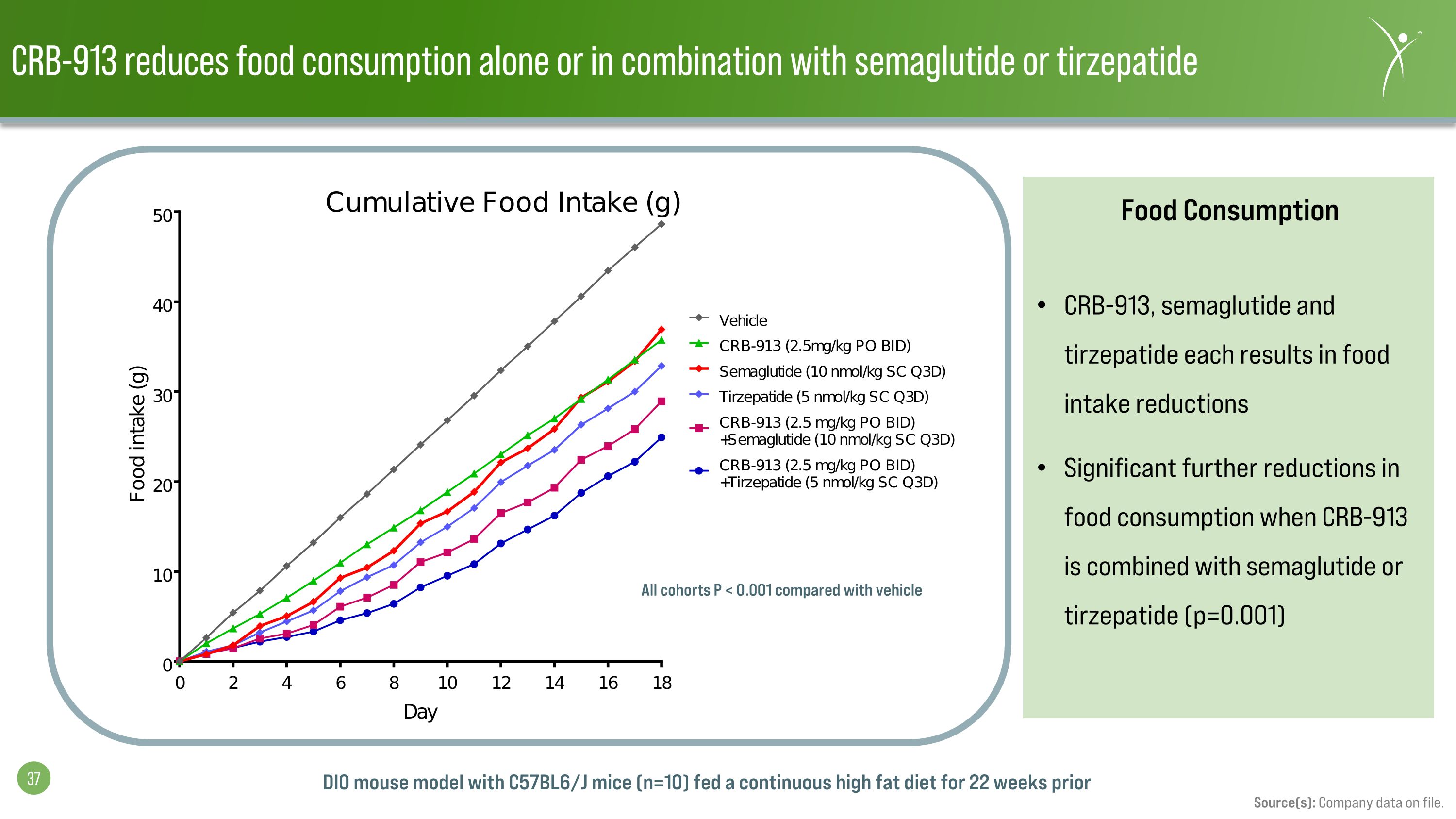
CRB-913 reduces food consumption alone or in combination with semaglutide or tirzepatide Source(s): Company data on file. Food Consumption CRB-913, semaglutide and tirzepatide each results in food intake reductions Significant further reductions in food consumption when CRB-913 is combined with semaglutide or tirzepatide (p=0.001) All cohorts P < 0.001 compared with vehicle DIO mouse model with C57BL6/J mice (n=10) fed a continuous high fat diet for 22 weeks prior
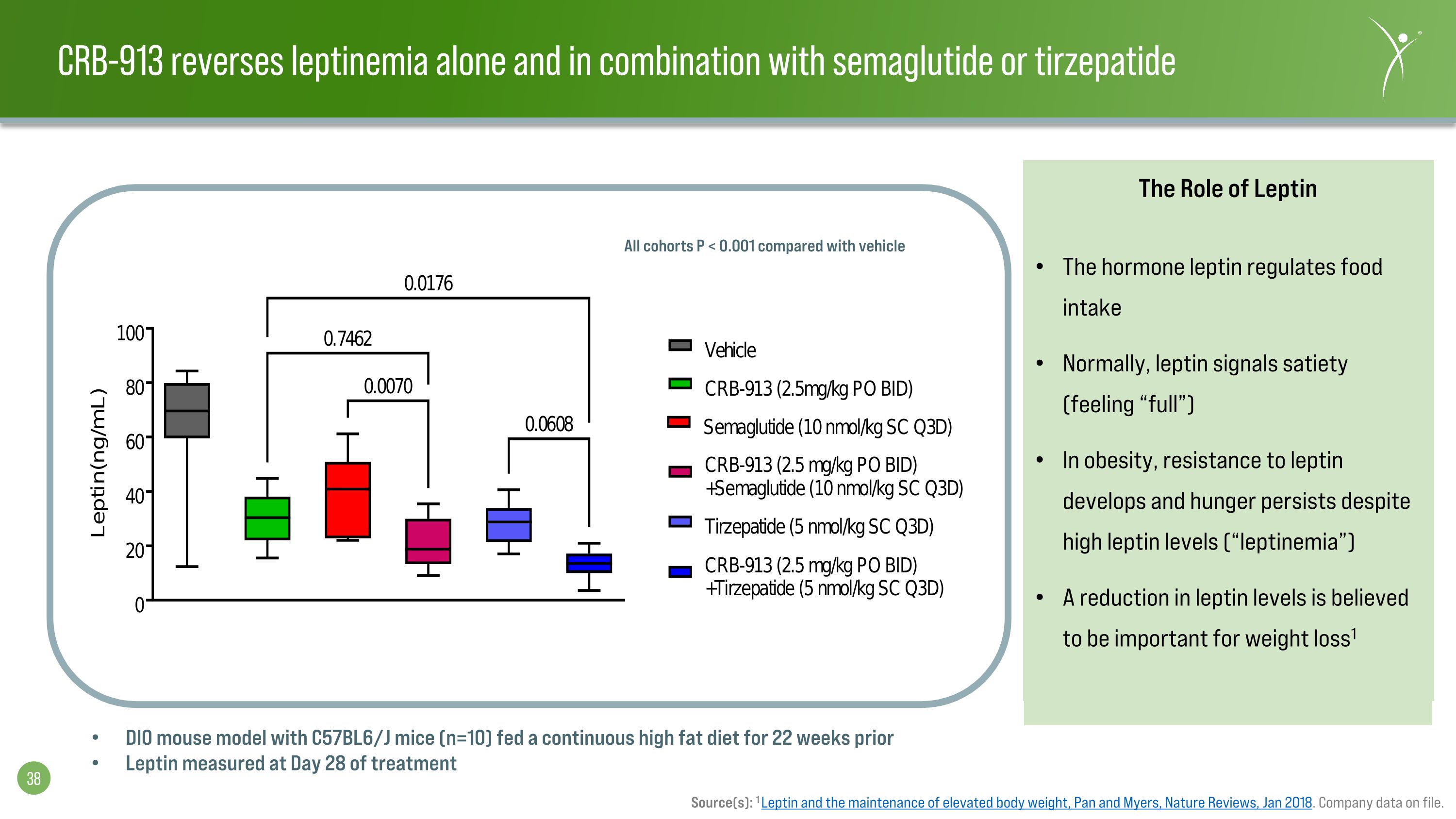
CRB-913 reverses leptinemia alone and in combination with semaglutide or tirzepatide Source(s): 1 Leptin and the maintenance of elevated body weight, Pan and Myers, Nature Reviews, Jan 2018. Company data on file. The Role of Leptin The hormone leptin regulates food intake Normally, leptin signals satiety (feeling “full”) In obesity, resistance to leptin develops and hunger persists despite high leptin levels (“leptinemia”) A reduction in leptin levels is believed to be important for weight loss1 DIO mouse model with C57BL6/J mice (n=10) fed a continuous high fat diet for 22 weeks prior Leptin measured at Day 28 of treatment All cohorts P < 0.001 compared with vehicle
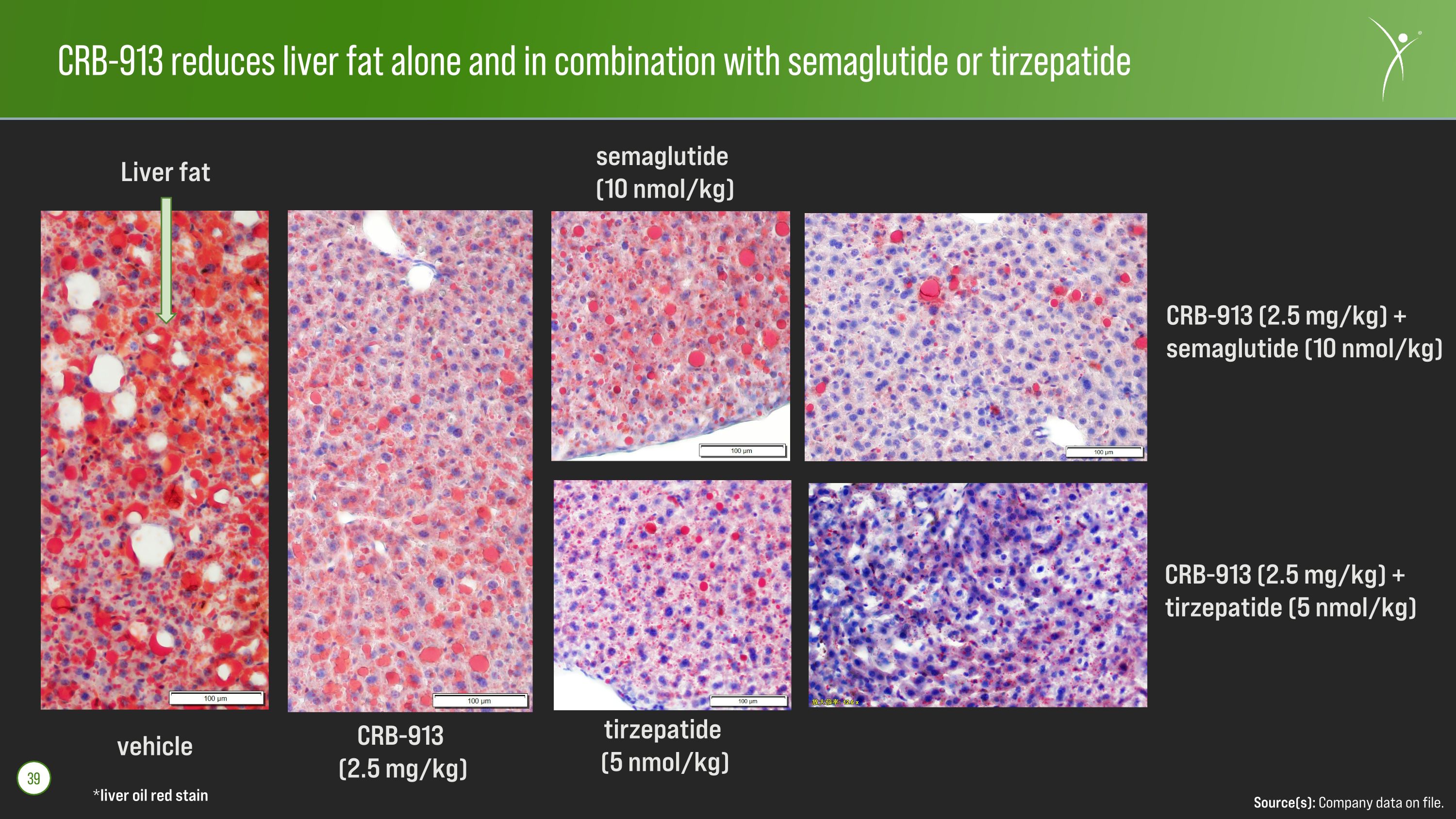
CRB-913 reduces liver fat alone and in combination with semaglutide or tirzepatide *liver oil red stain Source(s): Company data on file. 39 vehicle CRB-913 (2.5 mg/kg) semaglutide (10 nmol/kg) CRB-913 (2.5 mg/kg) + semaglutide (10 nmol/kg) tirzepatide (5 nmol/kg) CRB-913 (2.5 mg/kg) + tirzepatide (5 nmol/kg) Liver fat
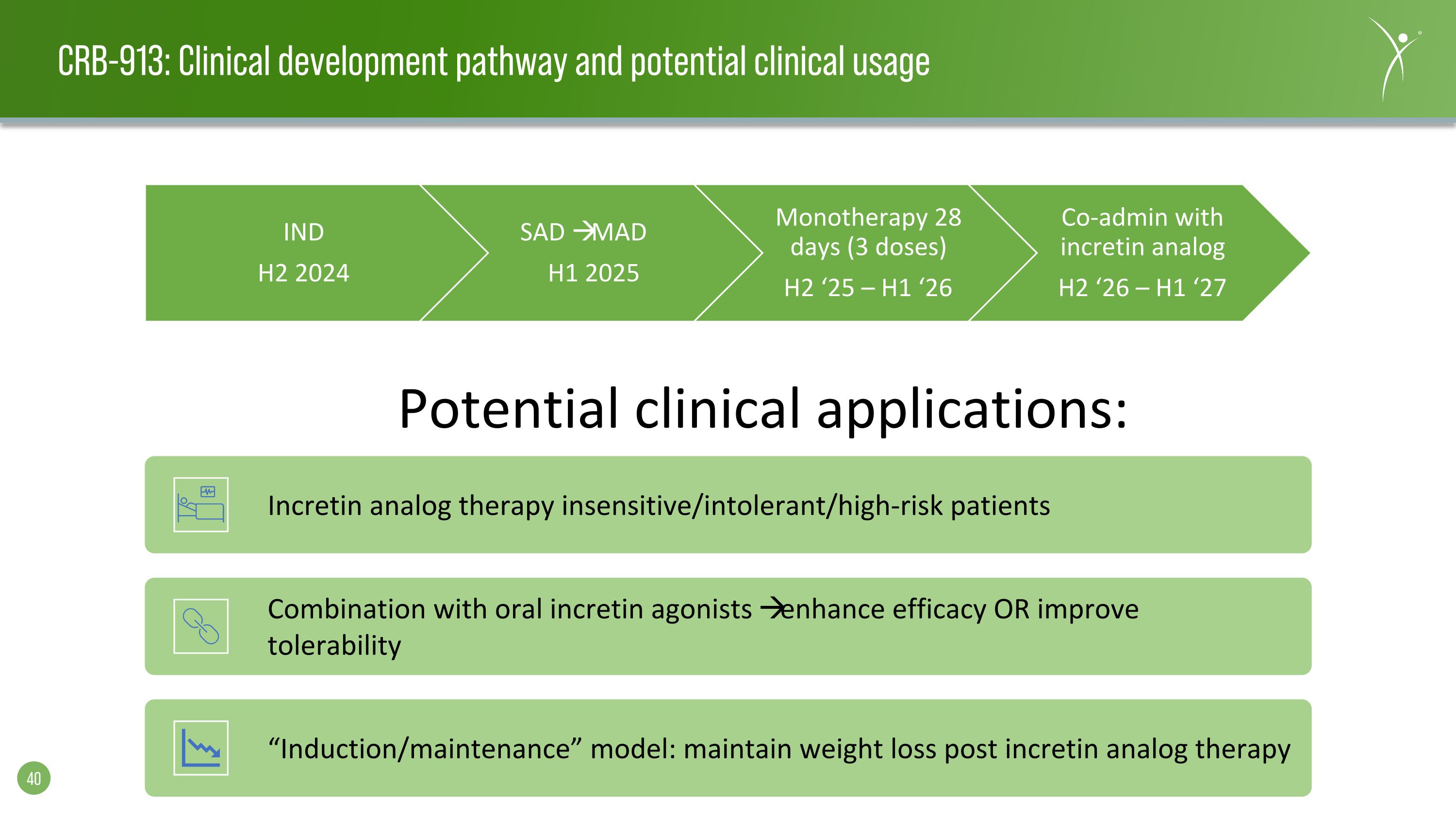
CRB-913: Clinical development pathway and potential clinical usage IND H2 2024 SAD MAD H1 2025 Monotherapy 28 days (3 doses) H2 ‘25 – H1 ‘26 Co-admin with incretin analog H2 ‘26 – H1 ‘27 Potential clinical applications: Incretin analog therapy insensitive/intolerant/high-risk patients Combination with oral incretin agonists enhance efficacy OR improve tolerability “Induction/maintenance” model: maintain weight loss post incretin analog therapy
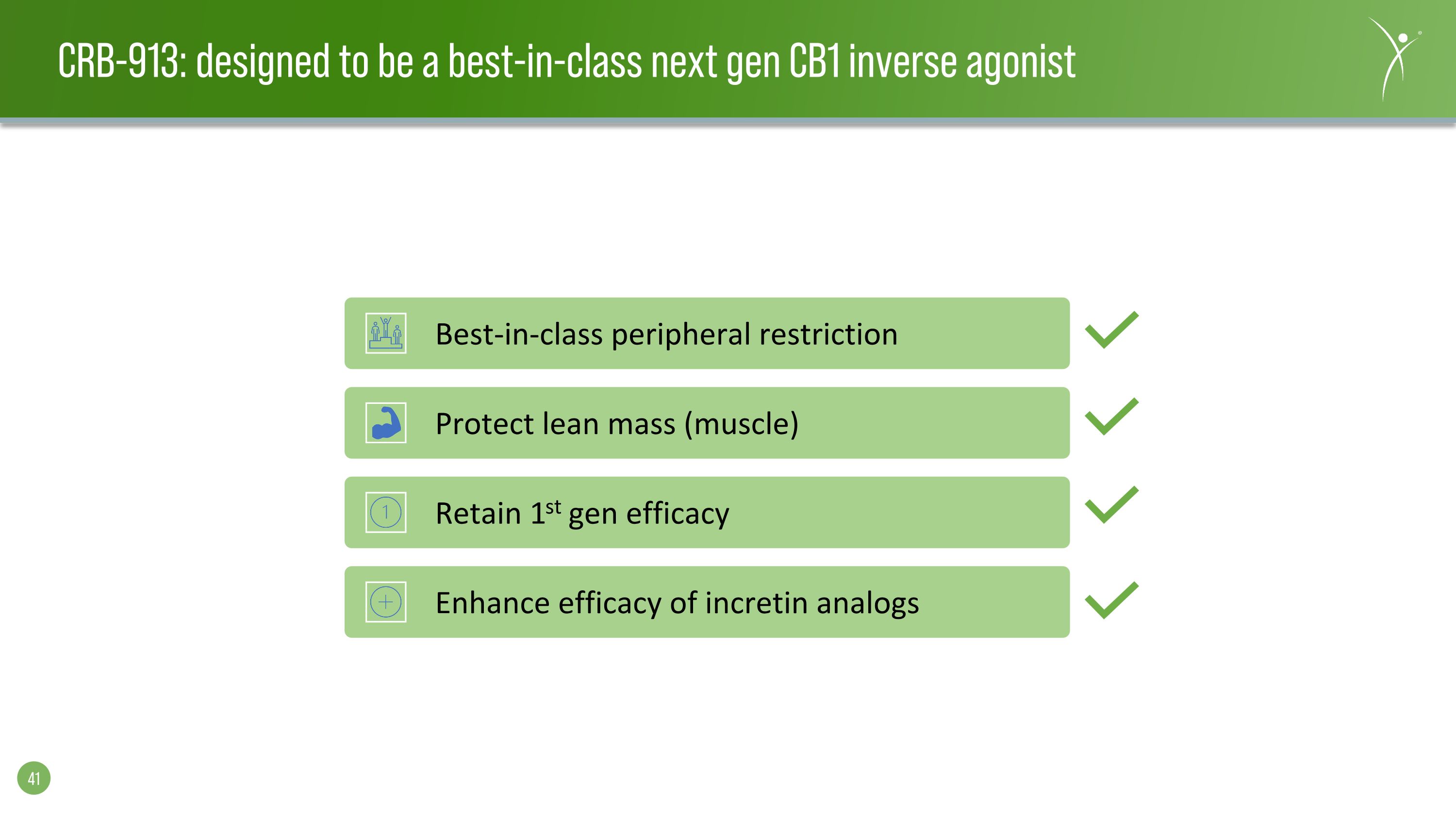
CRB-913: designed to be a best-in-class next gen CB1 inverse agonist Best-in-class peripheral restriction Protect lean mass (muscle) Retain 1st gen efficacy Enhance efficacy of incretin analogs

Leadership Financials Upcoming catalysts

Management Team Yuval Cohen, PhD Chief Executive Officer, Director Corbus co-founder and Chief Executive Officer since 2014. Previously the President and co-founder of Celsus Therapeutics from 2005. Sean Moran, CPA, MBA Chief Financial Officer Corbus co-founder and Chief Financial Officer since 2014. Prior senior financial management experience in emerging biotech and medical device companies. Rachael Brake, PhD Chief Scientific Officer Expert in developing and executing innovative drug discovery and clinical development oncology programs at several leading pharmaceutical companies. Christina Bertsch Head of Human Resources Accomplished senior human resource executive providing strategic HR consulting services to both large and small businesses across a variety of industries

Board of Directors Amb. Alan Holmer Ret. Chairman of the Board More than two decades of public service in Washington, D.C. including Special Envoy to China; Former CEO of PhRMA. Avery W. (Chip) Catlin Director More than 25 years of senior financial leadership experience in life science companies; Former CFO and Secretary of Celldex Therapeutics. Yuval Cohen, PhD Chief Executive Officer, Director Corbus co-founder and Chief Executive Officer since 2014. Previously the President and co-founder of Celsus Therapeutics from 2005. Rachelle Jacques Director More than 25-year professional career, experience in U.S. and global biopharmaceutical commercial leadership, including multiple high-profile product launches in rare diseases; CEO of Akari Therapeutics. (NASDAQ: AKTX) John K. Jenkins, MD Director Distinguished 25-year career serving at the U.S. FDA, including 15 years of senior leadership in CDER and OND. Pete Salzmann, MD, MBA Director 20 years of industry experience and currently serves as Chief Executive Officer of Immunovant (NASDAQ: IMVT), a biopharmaceutical company focused on developing therapies for patients with autoimmune diseases. Anne Altmeyer, PhD, MBA, MPH Director 20 years of experience advancing oncology R&D programs and leading impactful corporate development transactions; currently President & CEO of TigaTx. Yong (Ben) Ben, MD, MBA Director 25 years of oncology R&D experience across industry and academia. Held two industry CMO positions, most recently at BeiGene (BGNE).
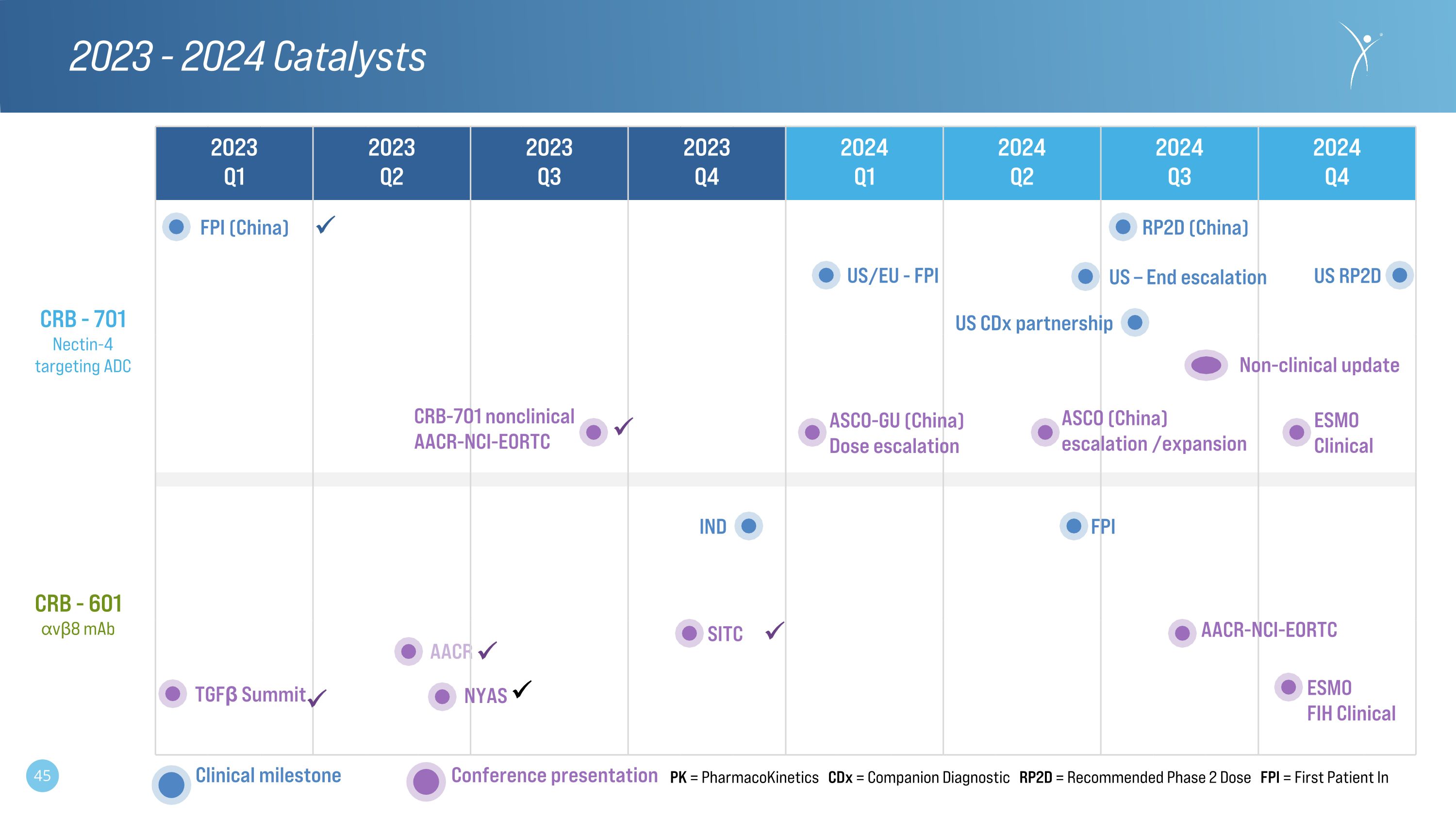
AACR 2023 - 2024 Catalysts 2023 Q1 2023 Q2 2023 Q3 2023 Q4 2024 Q1 2024 Q2 2024 Q3 2024 Q4 CRB - 601 ⍺vβ8 mAb CRB - 701 Nectin-4 targeting ADC IND FPI AACR-NCI-EORTC TGFβ Summit NYAS Conference presentation Clinical milestone SITC PK = PharmacoKinetics CDx = Companion Diagnostic RP2D = Recommended Phase 2 Dose FPI = First Patient In ESMO FIH Clinical US CDx partnership CRB-701 nonclinical AACR-NCI-EORTC Non-clinical update ASCO (China) escalation /expansion FPI (China) RP2D (China) ASCO-GU (China) Dose escalation US/EU - FPI US – End escalation US RP2D ESMO Clinical
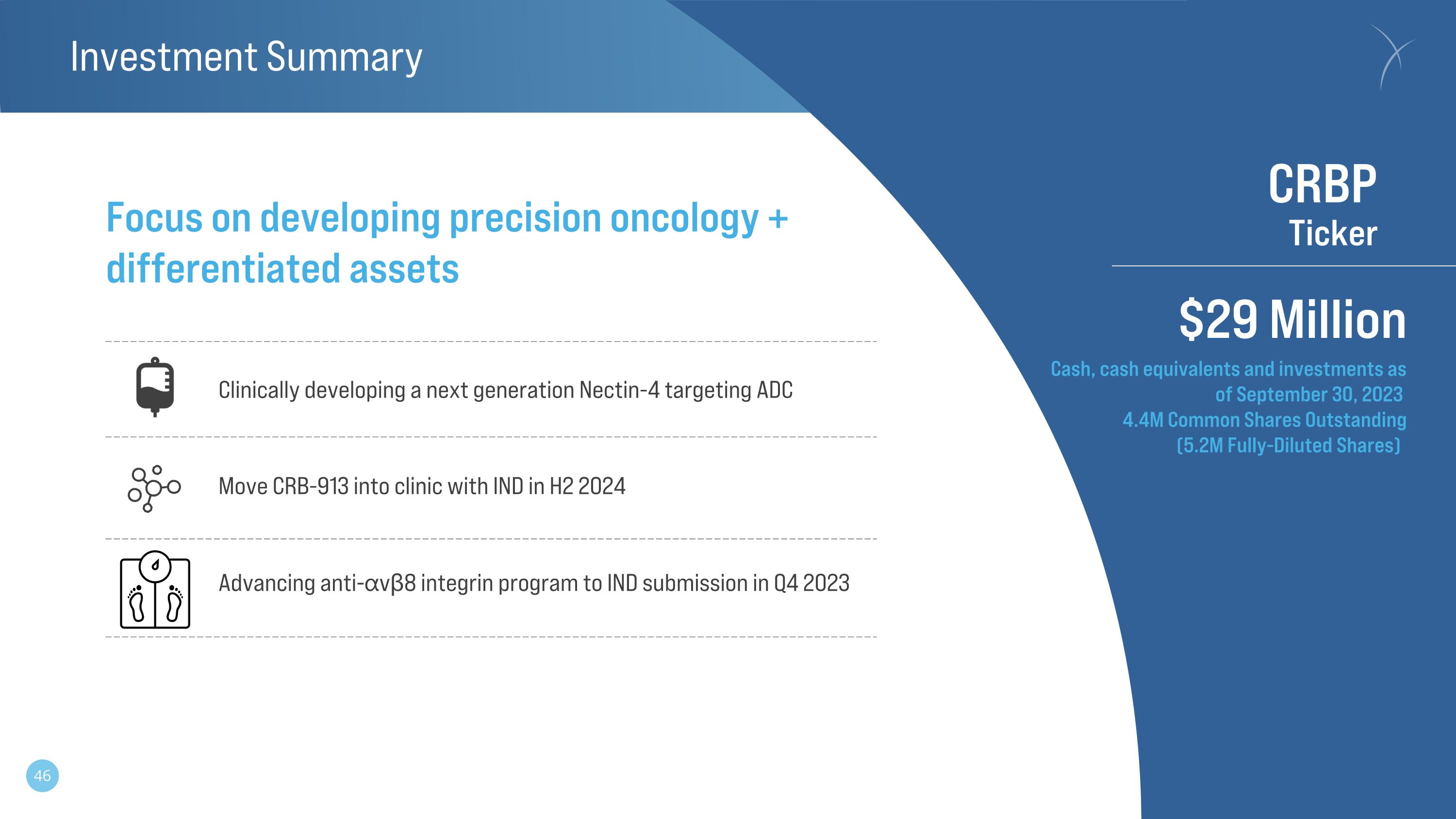
Investment Summary Advancing anti-⍺vβ8 integrin program to IND submission in Q4 2023 CRBP Ticker $29 Million Focus on developing precision oncology + differentiated assets Clinically developing a next generation Nectin-4 targeting ADC Cash, cash equivalents and investments as of September 30, 2023 4.4M Common Shares Outstanding (5.2M Fully-Diluted Shares) Move CRB-913 into clinic with IND in H2 2024
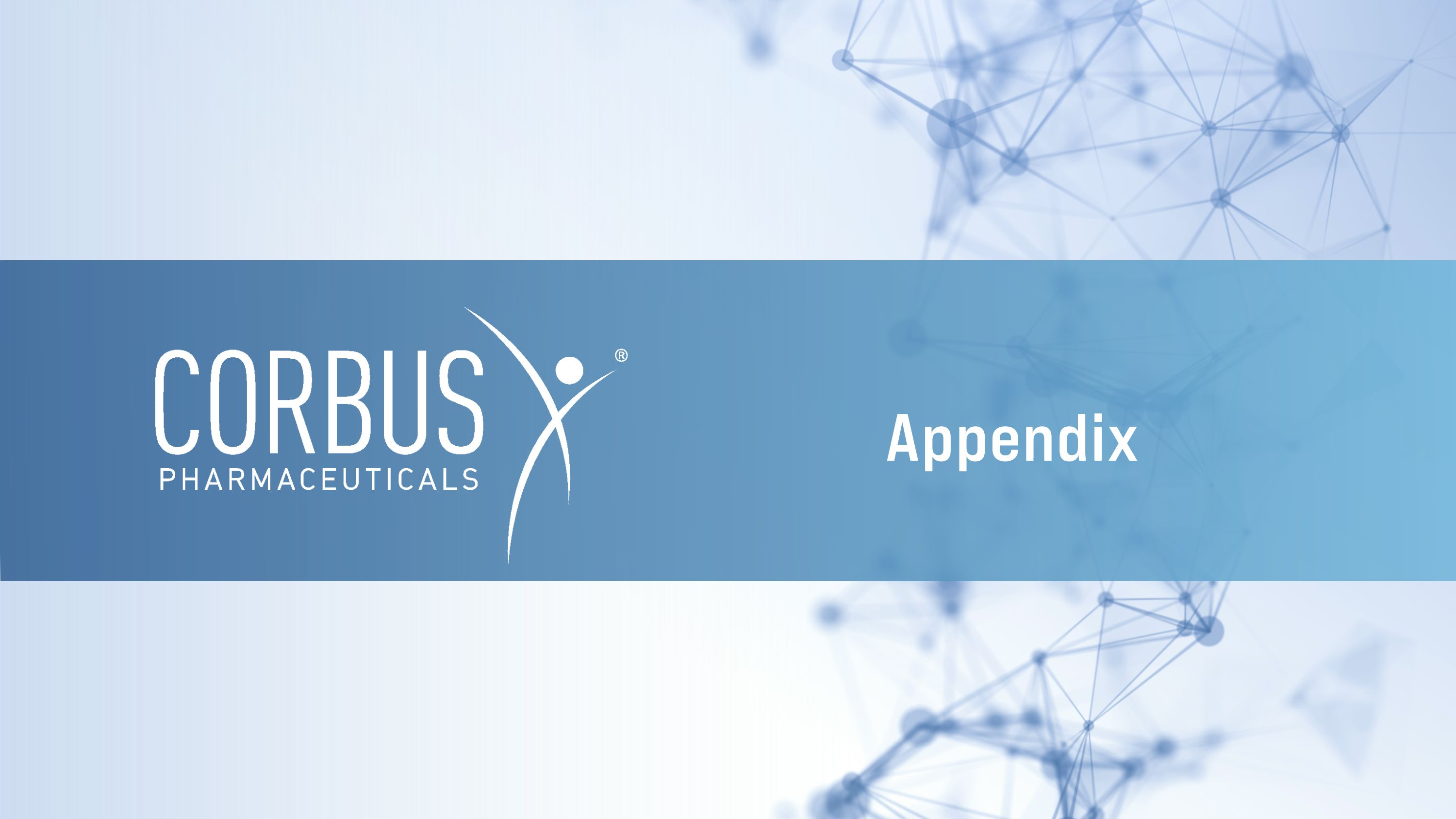
Appendix
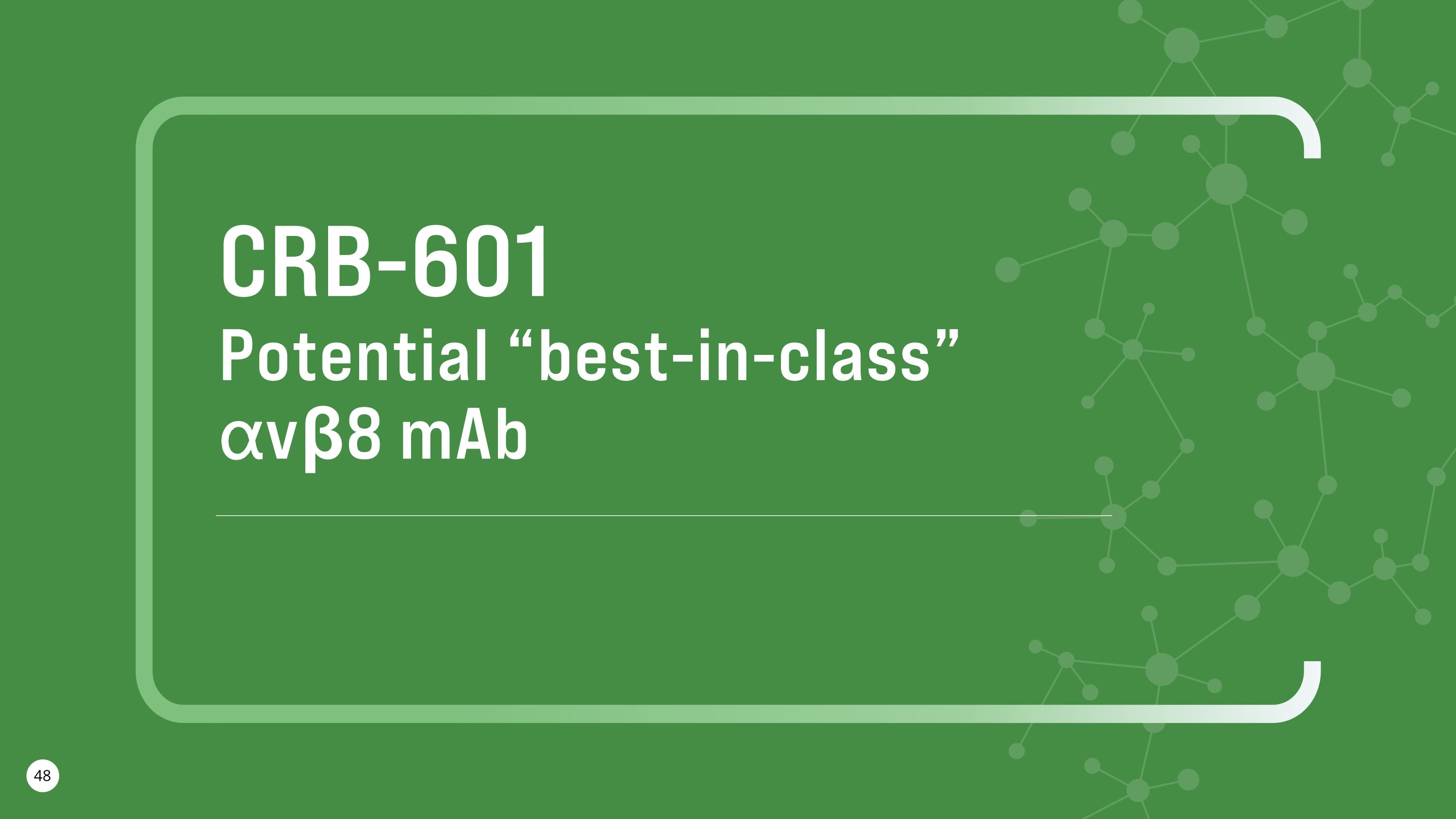
CRB-601 Potential “best-in-class” ⍺vβ8 mAb
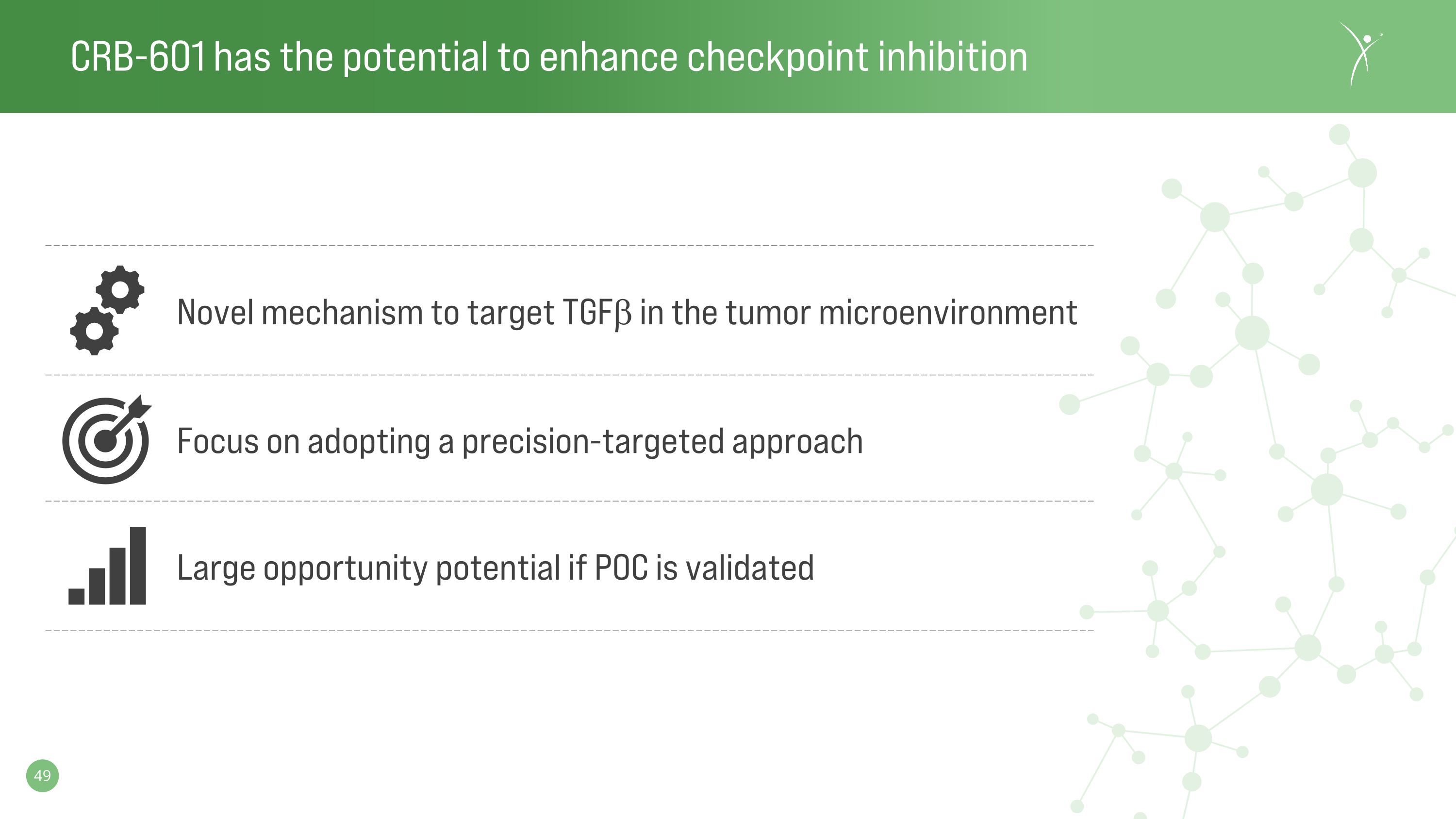
CRB-601 has the potential to enhance checkpoint inhibition Focus on adopting a precision-targeted approach Novel mechanism to target TGFb in the tumor microenvironment Large opportunity potential if POC is validated
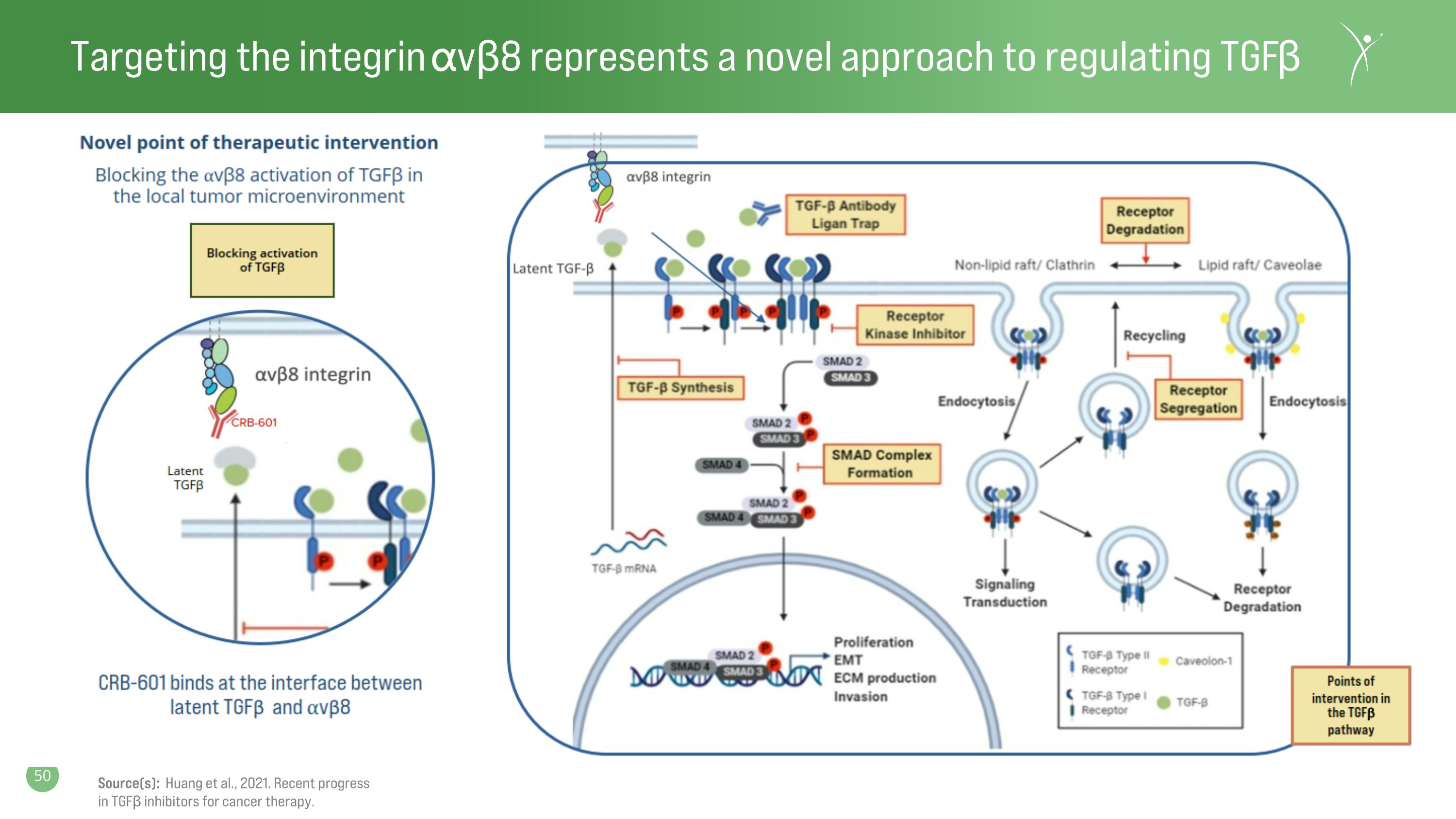
Targeting the integrin ⍺vβ8 represents a novel approach to regulating TGFβ Source(s): Huang et al., 2021. Recent progress in TGFβ inhibitors for cancer therapy.
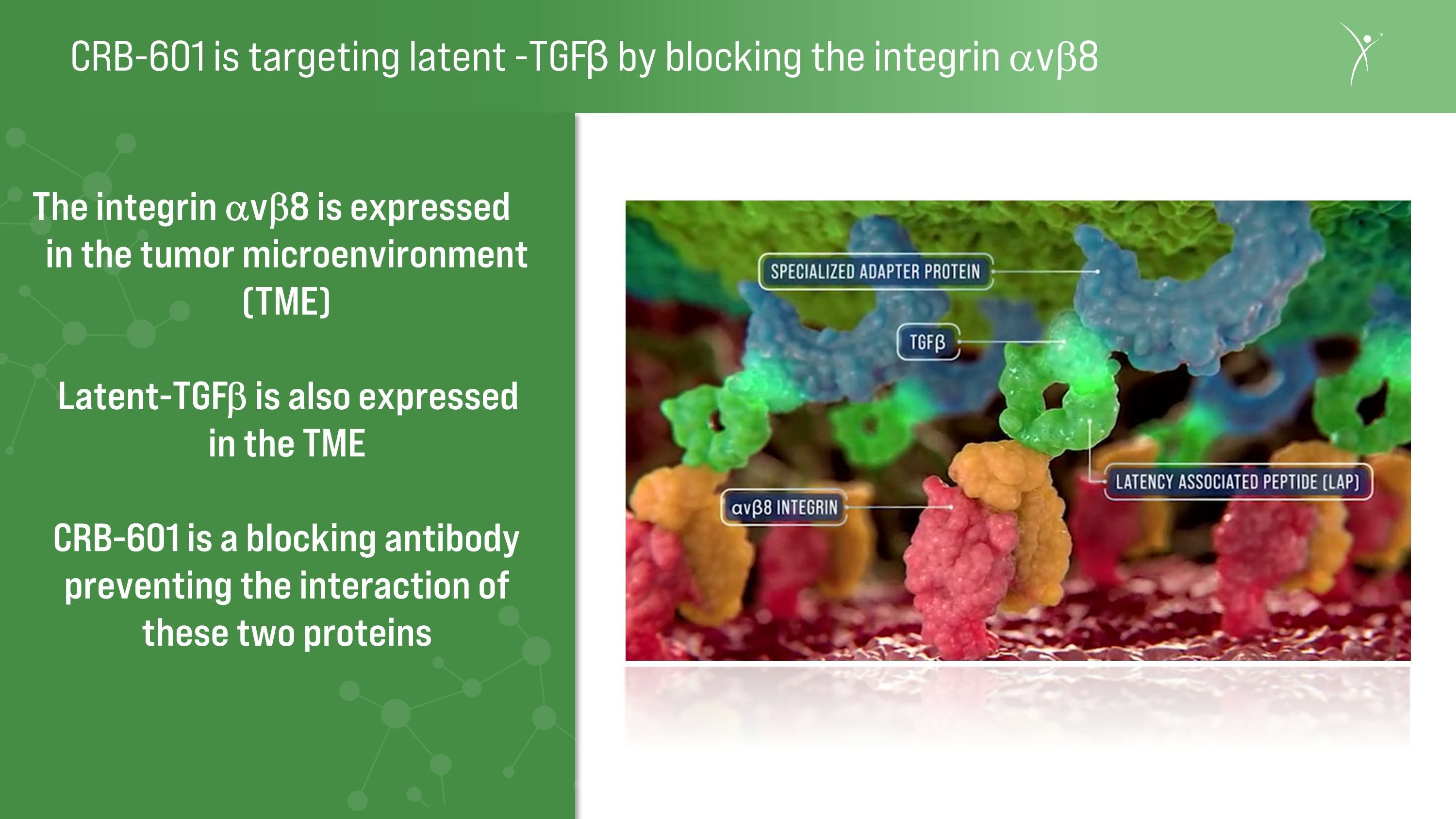
CRB-601 is targeting latent -TGFβ by blocking the integrin avb8 The integrin avb8 is expressed in the tumor microenvironment (TME) Latent-TGFb is also expressed in the TME CRB-601 is a blocking antibody preventing the interaction of these two proteins
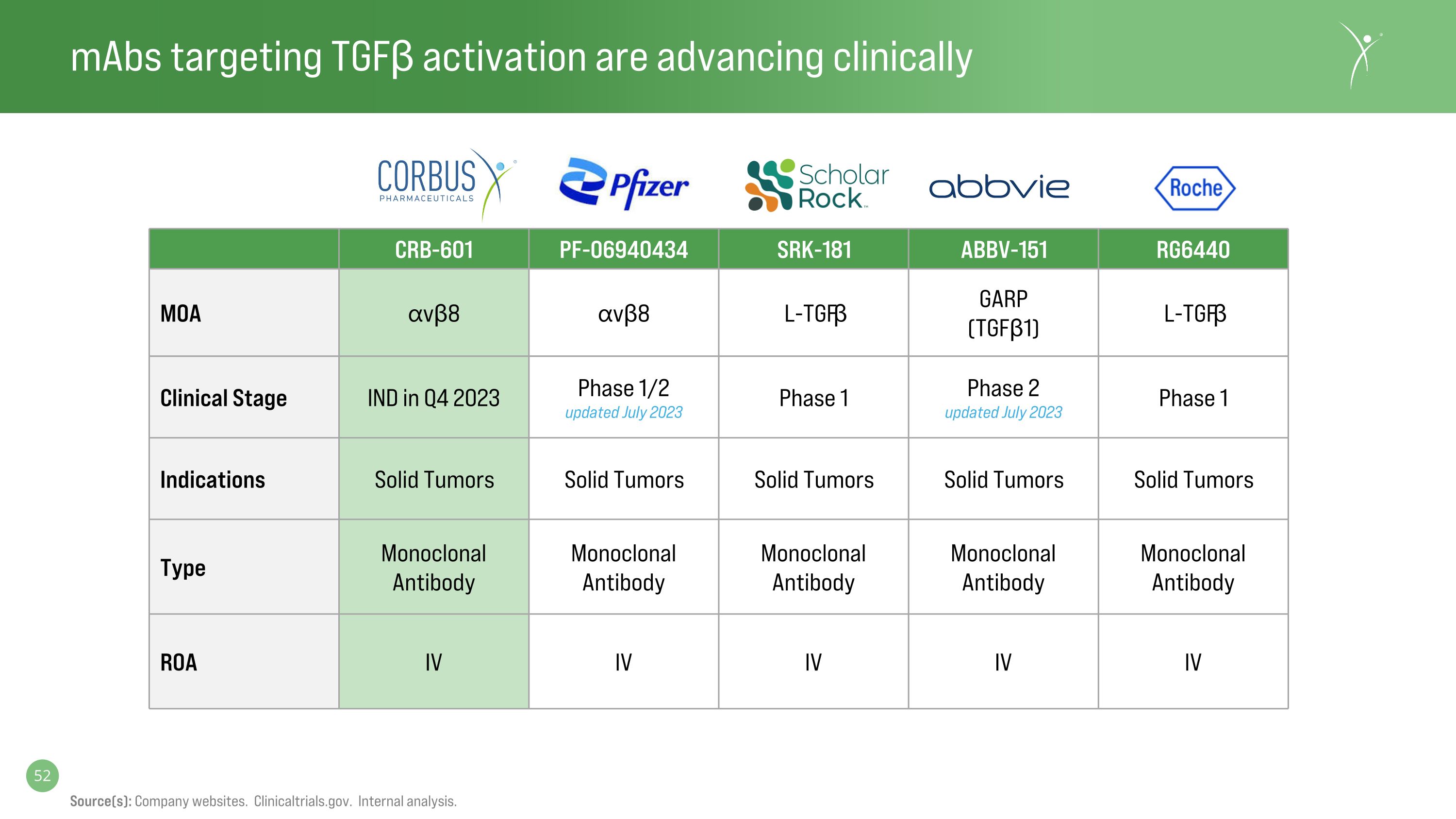
mAbs targeting TGFβ activation are advancing clinically Source(s): Company websites. Clinicaltrials.gov. Internal analysis. CRB-601 PF-06940434 SRK-181 ABBV-151 RG6440 MOA ⍺vβ8 ⍺vβ8 L-TGFβ GARP (TGFβ1) L-TGFβ Clinical Stage IND in Q4 2023 Phase 1/2 updated July 2023 Phase 1 Phase 2 updated July 2023 Phase 1 Indications Solid Tumors Solid Tumors Solid Tumors Solid Tumors Solid Tumors Type Monoclonal Antibody Monoclonal Antibody Monoclonal Antibody Monoclonal Antibody Monoclonal Antibody ROA IV IV IV IV IV
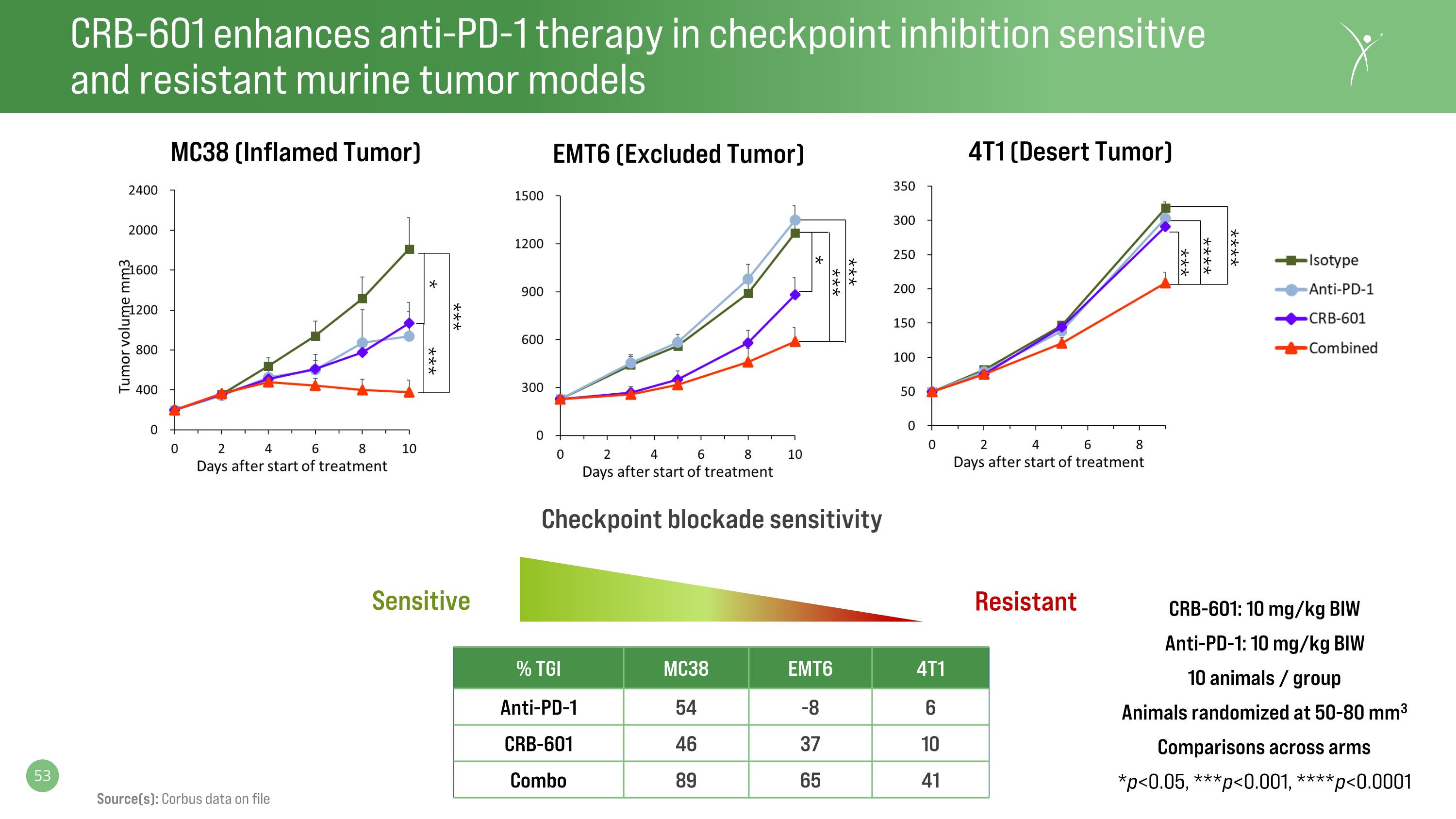
CRB-601 enhances anti-PD-1 therapy in checkpoint inhibition sensitive and resistant murine tumor models CRB-601: 10 mg/kg BIW Anti-PD-1: 10 mg/kg BIW 10 animals / group Animals randomized at 50-80 mm3 Comparisons across arms *p<0.05, ***p<0.001, ****p<0.0001 % TGI MC38 EMT6 4T1 Anti-PD-1 54 -8 6 CRB-601 46 37 10 Combo 89 65 41 Resistant Checkpoint blockade sensitivity Sensitive MC38 (Inflamed Tumor) EMT6 (Excluded Tumor) 4T1 (Desert Tumor) *** **** **** *** * *** *** *** * Source(s): Corbus data on file
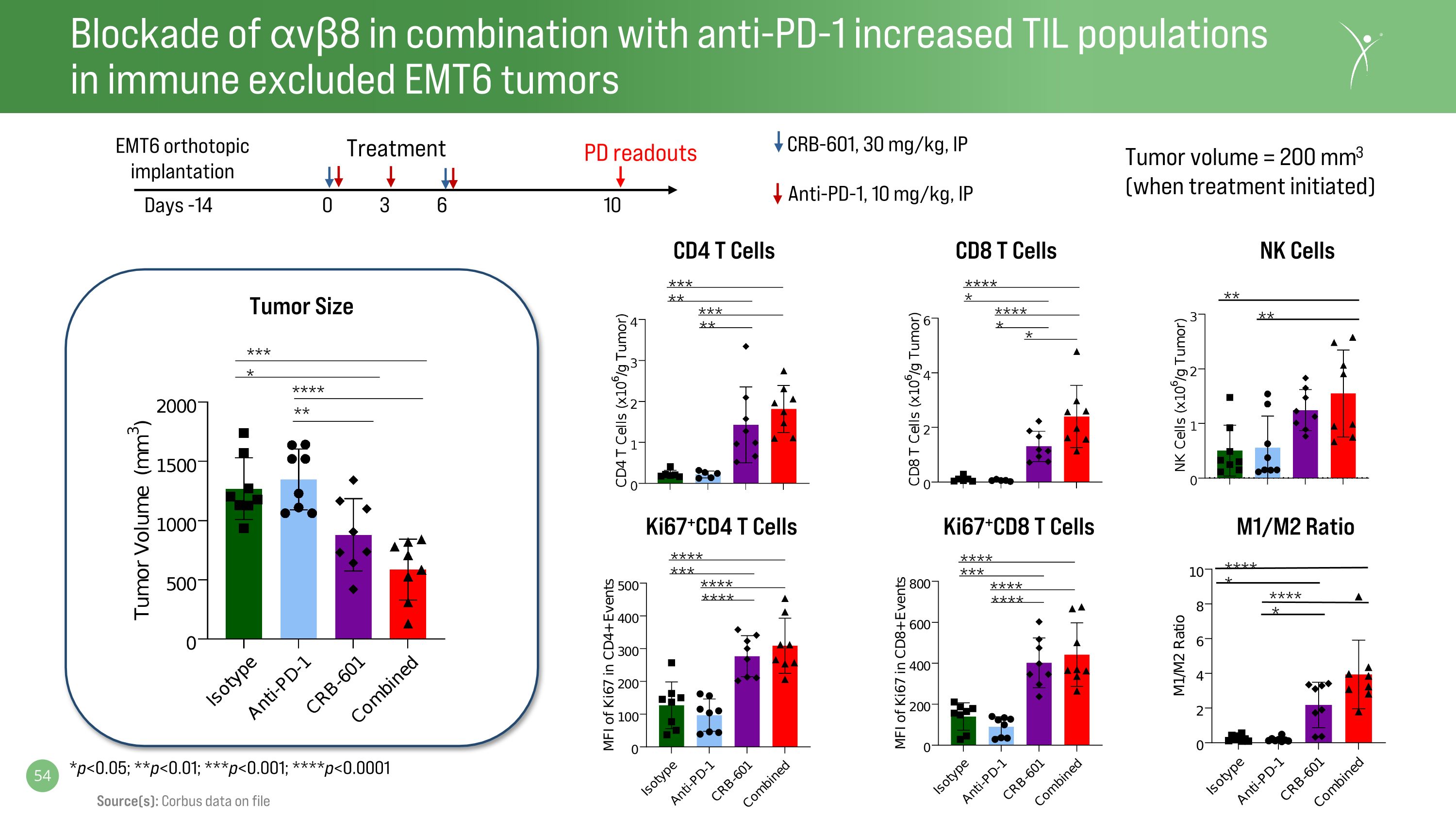
Blockade of ⍺vβ8 in combination with anti-PD-1 increased TIL populations in immune excluded EMT6 tumors **** *** **** **** **** *** **** **** Ki67+CD4 T Cells Ki67+CD8 T Cells CD4 T Cells CD8 T Cells Tumor Size * *** * **** ** *** ** *** ** **** * **** * Treatment Days -14 0 3 6 10 Anti-PD-1, 10 mg/kg, IP CRB-601, 30 mg/kg, IP EMT6 orthotopic implantation PD readouts Tumor volume = 200 mm3 (when treatment initiated) *p<0.05; **p<0.01; ***p<0.001; ****p<0.0001 M1/M2 Ratio NK Cells ** ** **** **** * * Source(s): Corbus data on file
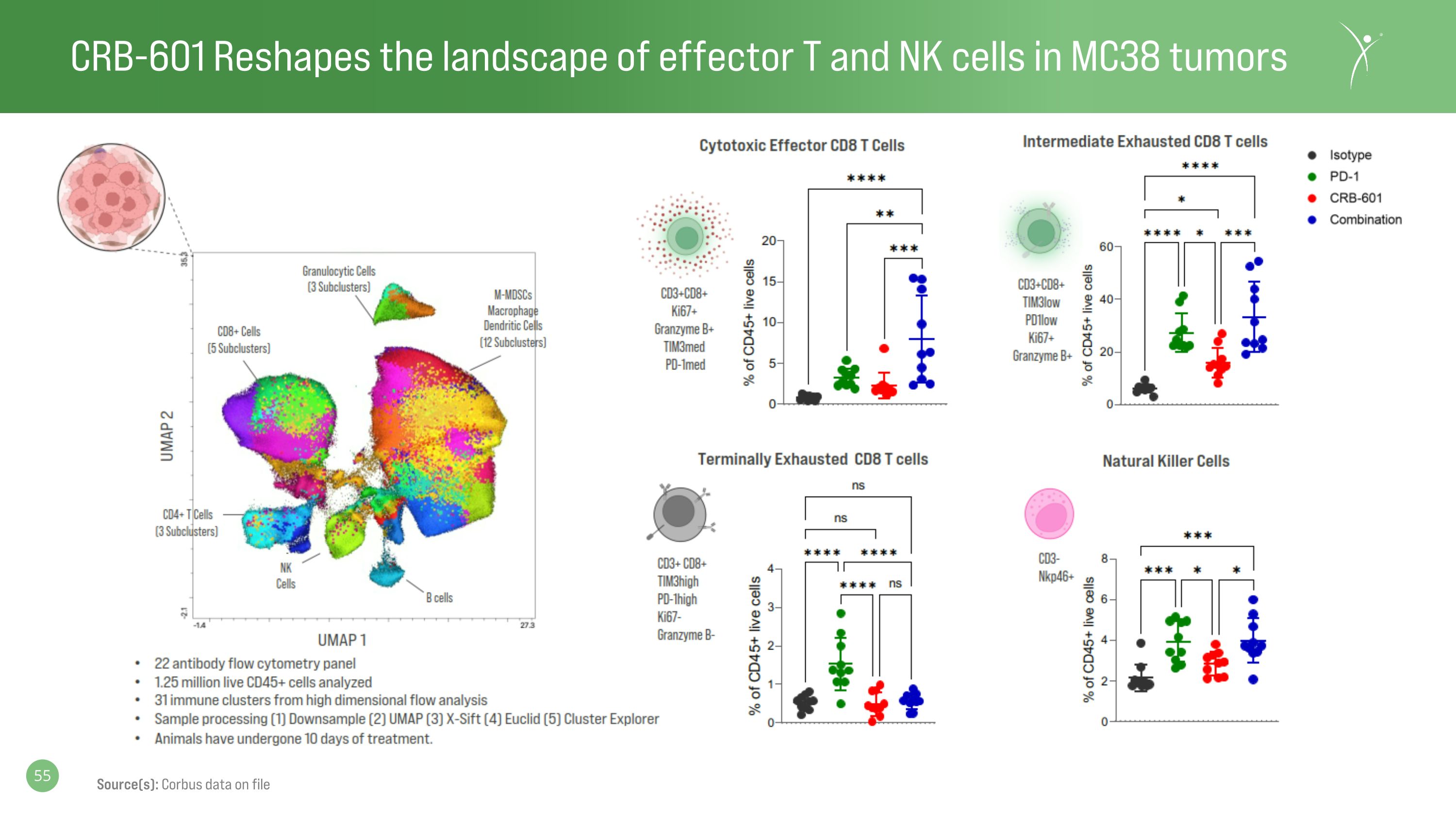
CRB-601 Reshapes the landscape of effector T and NK cells in MC38 tumors Source(s): Corbus data on file
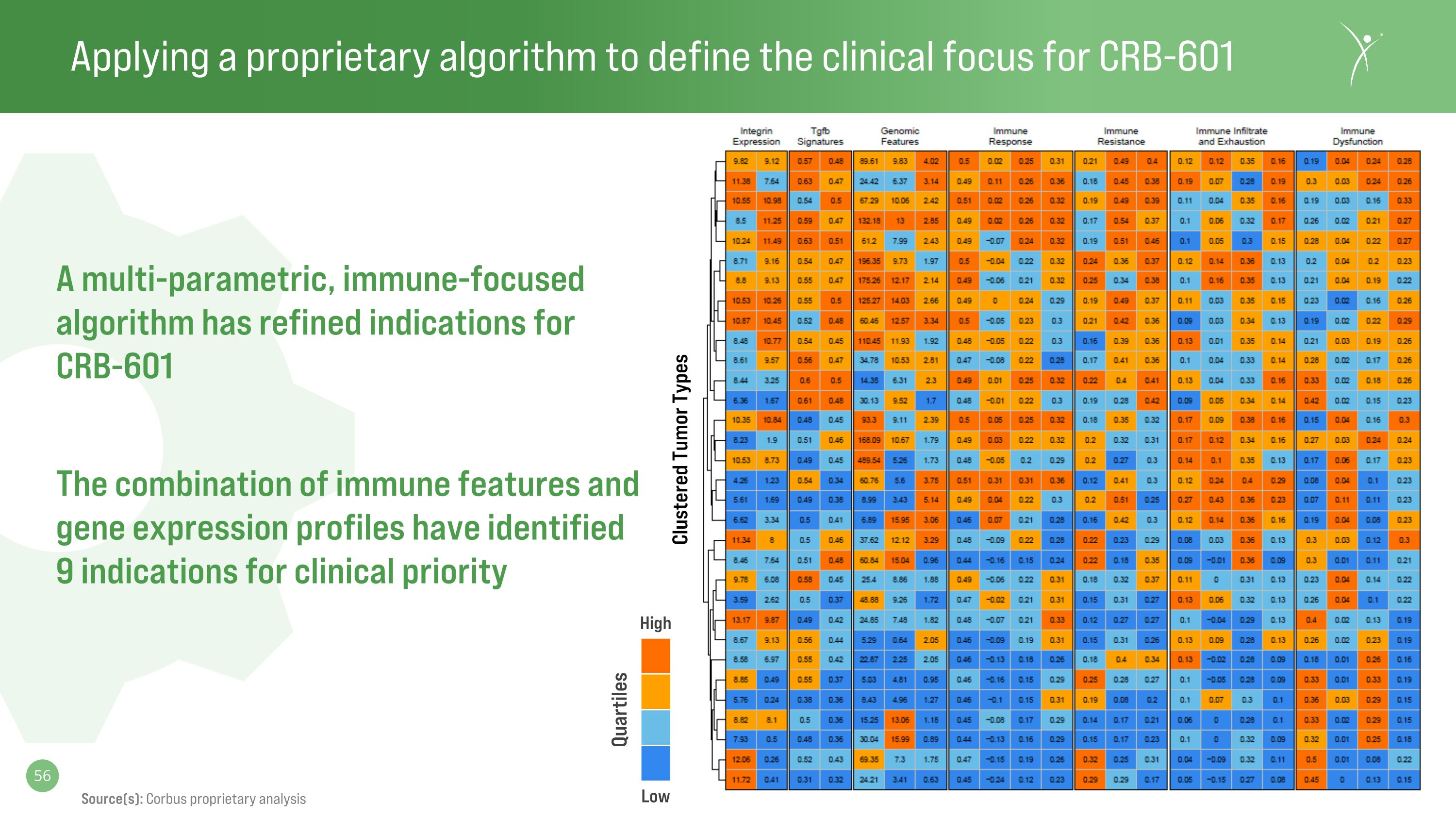
Applying a proprietary algorithm to define the clinical focus for CRB-601 A multi-parametric, immune-focused algorithm has refined indications for CRB-601 The combination of immune features and gene expression profiles have identified 9 indications for clinical priority High Low Quartiles Source(s): Corbus proprietary analysis Clustered Tumor Types
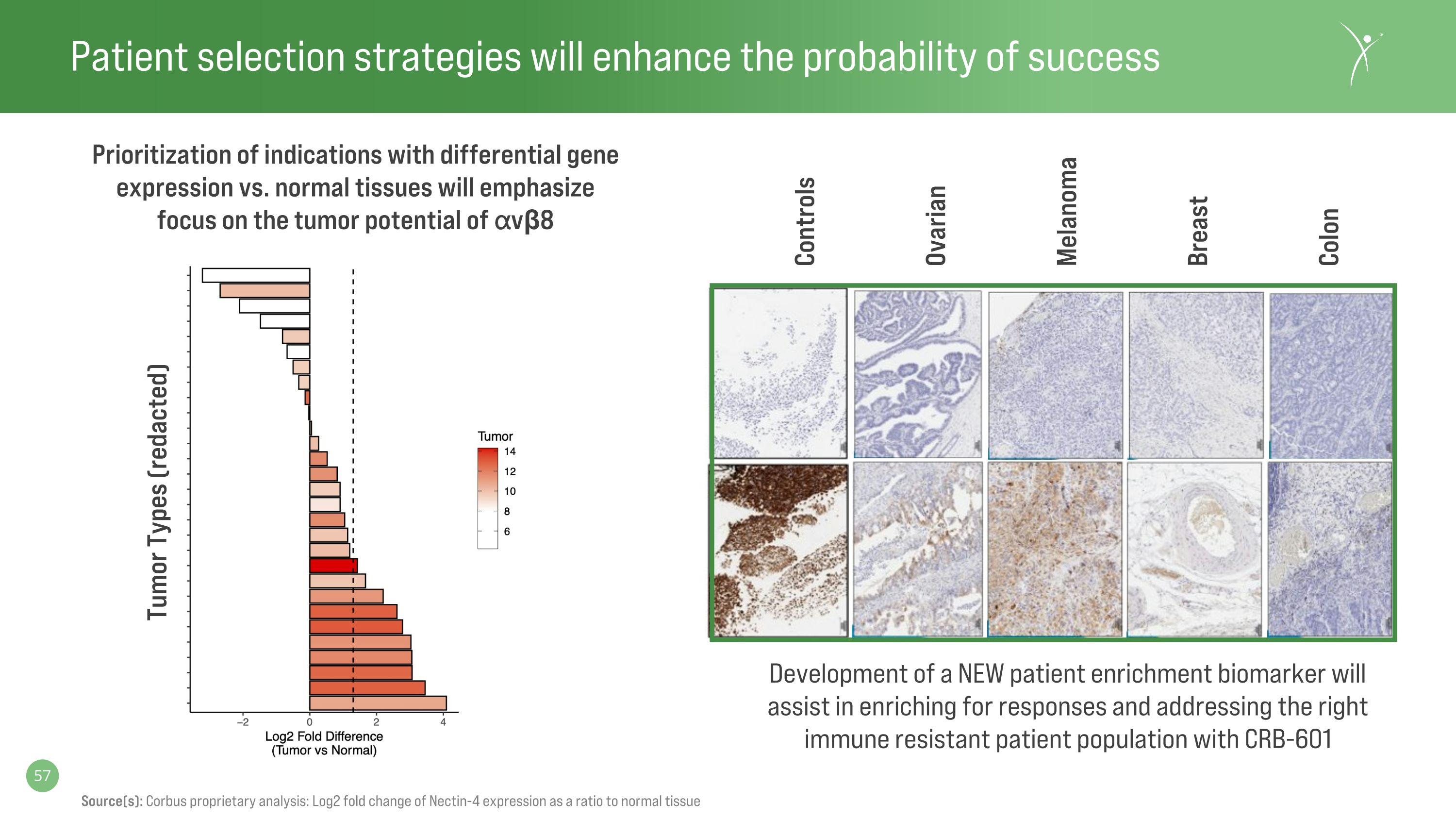
Patient selection strategies will enhance the probability of success Source(s): Corbus proprietary analysis: Log2 fold change of Nectin-4 expression as a ratio to normal tissue Controls Ovarian Melanoma Breast Colon Prioritization of indications with differential gene expression vs. normal tissues will emphasize focus on the tumor potential of ⍺vβ8 Development of a NEW patient enrichment biomarker will assist in enriching for responses and addressing the right immune resistant patient population with CRB-601 Tumor Types (redacted)
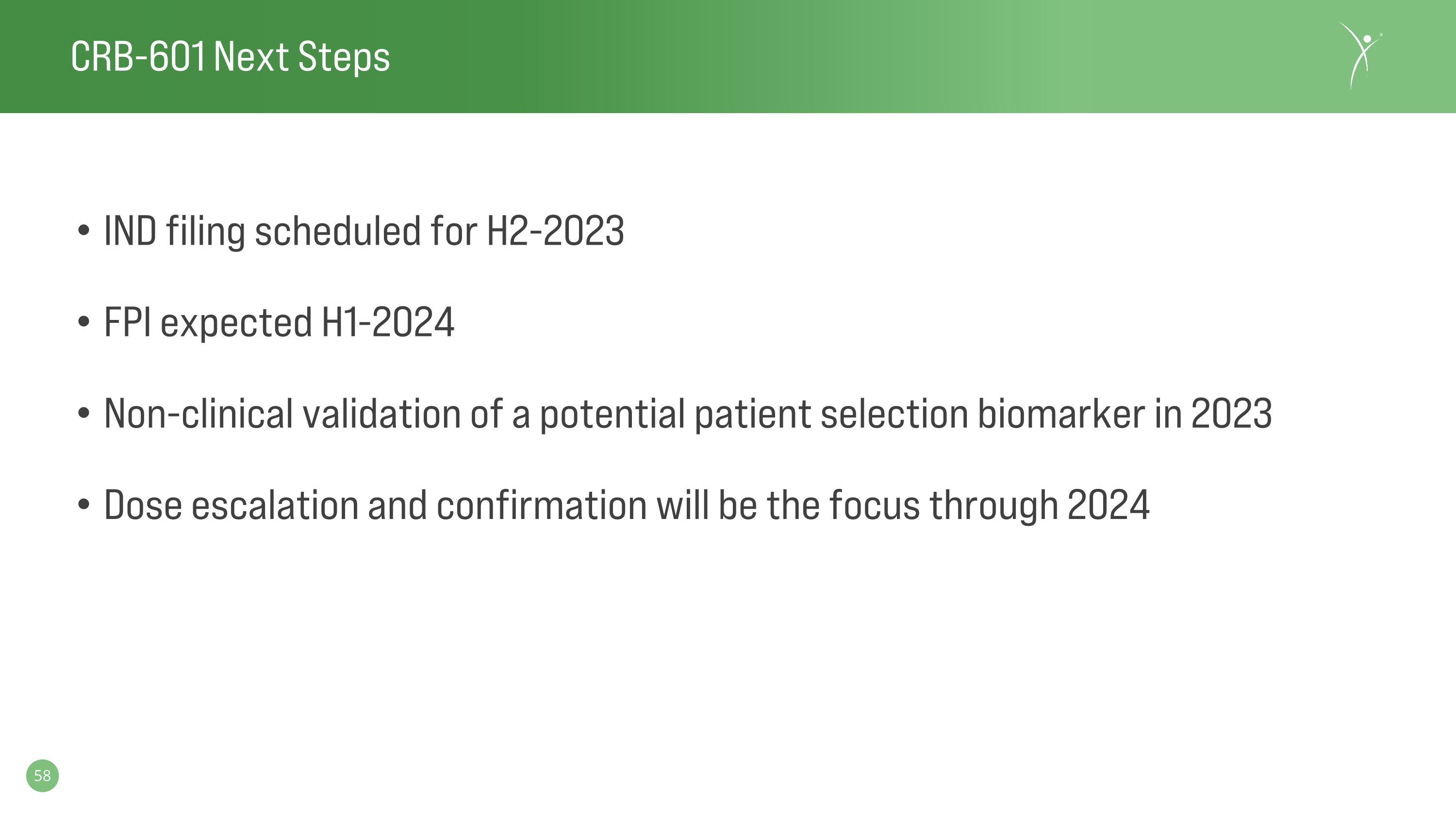
CRB-601 Next Steps IND filing scheduled for H2-2023 FPI expected H1-2024 Non-clinical validation of a potential patient selection biomarker in 2023 Dose escalation and confirmation will be the focus through 2024